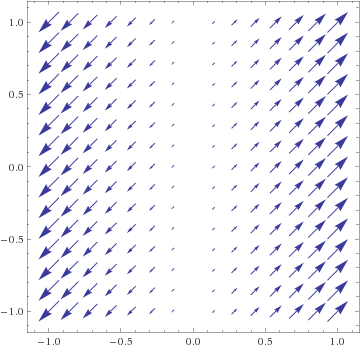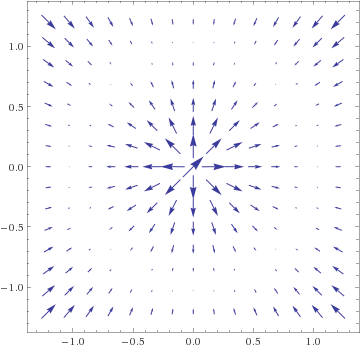Office hours: Mon, Wed, Fri 9:30−12:00, and Thu afternoon by appointment.
Assistant: Alex Wilson, wils1256@msu.edu
MLC hours: Wells C-126A, Thu 12:30−1:40, Fri 11:20−12:30pm.
Solving (not just looking at) problems is essential to learning: only look at the solution after a serious effort.
I will give 1 extra point to the first person reporting each significant typo or error on this page. Corrections and recent revisions are in red. Tentative future assignments are in gray.
- 1/9 Lect 1.
⊞
Vectors v,u ∈ R2, dot product
u•v, orthogonal decompostion v = p+q.
⊞ Solutions
- We write a vector v interchangeably as:
- two-point form v = AB, the arrow from point A to B; the same v could be drawn starting at any point in the plane;
- standard form v = (x,y) ∈ R2, giving the endpoint if v is drawn starting at (0,0).
- Operations sv, u ± v; basis vectors i = (1,0), j = (0,1), v = (x,y) = xi + yj
- Parametrized segment from a to b: a + t(b−a) = (1−t)a + tb for 0 ≤ t ≤ 1
- Dot product u•v = ±|u| |p| = |u| |v| cos(θuv), where p = perpendicular projection of v on u-line
- Length |v| = √(v•v), orthogonality u•v = 0, unit vector v⁄|v|
- Properties: commutative, bilinear, basis ⇒ formula:
(x1,y1) • (x2,y2) = x1x2 + y1y2 - Orthogonal decomposition v = p + q with p||u , q⊥u ⇒ p = (v•u)⁄(u•u) u , q = v − p
- Direction cosines.
HW 1: Start the Weekly Homework WHW 1 due 1/13 below.- Consider the triangle with vertices A = (1,2), B = (3,3), C = (2,0). Use dot products to show this is a right triangle, and verify the Pythagorean Theorem.
- Consider vectors v = (0, −10) and u = (3,2),
and let v = p + q be the orthogonal decomposition
where p is parallel to u
and q is orthogonal to u.

- Find the length |p| by computing the dot product u • v, then recalling our original definition u • v = ±|u| |p|.
- Find p and q by finding the scalar t such that tu is perpendicular to v − tu. (Hint: Solve an equation for t to get the familiar projection formula.)
- If u points along an inclined plane, and v represents the acceleration for a free-falling object (about 10 m/sec2), then what is the acceleration of an object sliding without friction along the plane? What is the gravitational force of a unit-mass object against the plane?
- Given a triangle whose vertices are (the endpoints of)
u, v, w,
the centroid or center of gravity is:
c = 1⁄3(u + v + w), the point whose x-coordinates are the average of the x-coordinates of the vertices, and same for y-coordinates.
A median of the triangle is the line segment from a vertex to the midpoint of the opposite side.
Using vector algebra, prove that the three medians all intersect at the centroid, which is 2⁄3 of the way along each median.- Write each median as a parametrized line segment.
- Show that the point 2⁄3 of the way along each median is indeed the centroid.
- [MT] Ch 1.2 Exercise 27, 29, 31, 33, 37, 39. Ch 1 Review Ex 19, 39.
1. Consider the vectors a = OA, b = OB, c = OC, and let α be the angle at A. Then:
cos(α) = (b−a)•(c−a)⁄|b−a| |c−a| = (2,1)•(1,−2)⁄√5√5 = 0. Thus α = arccos(0) = π⁄2, a right angle, and similarly for the other two angles. The Pythagorean Theorem says |b−a|2 + |c−a|2 = |c−b|2, i.e. (√5)2 + (√5)2 = (√10)2.2a. We compute: |p| = |u•v|⁄|u| = |(3,2)•(0,−10)|⁄|(3,2)| = 20⁄√13.
2b. Given u, v, we solve for the scalar t in the equation tu • (v−tu) = 0, namely tu•v − t2u•u = 0, and t = (u•v)⁄(u•u). This gives the familiar projection formula p = (u•v)⁄(u•u) u = −(60⁄13,40⁄13) and q = v − p = (60⁄13,−90⁄13).
2c. Here p is the component of acceleration along the plane u, so the acceleration is |p| = 20⁄√13 ≈ 5.5 m/sec2, about half the acceleration of free-fall. The force on the surface is mass times the perpendicular acceleration, so a 1 kg object (pressing about |v| = 10 Newtons on a flat surface) would exert a force of |q| = 30⁄√13 ≈ 8.3 N.
4. Odd-numbered exercises in [MT] have answers in the back, p. 494.
- We write a vector v interchangeably as:
- 1/11 Lect 2.
⊞
Linear fun L: param line ℓ(t), directional height ℓ(x,y), lin transform L
Soln
- Linear: ℓ(u+v) = ℓ(u) + ℓ(v) , ℓ(sv) = s ℓ(v) ,
affine f(v) = ℓ(v) + b
ℓ : R → R, ℓ(x) = mx , f(x) = mx + b - ℓ : R → R2,
ℓ(t) = mt, f(t) = mt + b is parametrized line
line segment from a to b: ℓ(t) = a + (b−a)t = (1−t)a + tb for 0 ≤ t ≤ 1 - ℓ : R2 → R,
ℓ(v) = m•v
= scaled height function in m direction
true height = m⁄|m| • v , where m⁄|m| is a unit vector (length 1) - Linear transformation L : R2 → R2
- L(u+v) = L(u) + L(v), L(sv) = s L(v)
- Coord formula L(x,y) = x L(i) + y L(j)
- Matrix of column vectors: [L] = [L(i) | L(j)]
- projection Proja(v) = p = (v•a)⁄(a•a) a (v = p+q with p = ta , q•a = 0)
- reflection Refa(v) = −p + q = v − 2(v•a)⁄(a•a) a (reflect along a, across perp line a⊥)
- dilation Dila(v) = av
- rotation by angle θ, Rotθ(i) = cos(θ) i + sin(θ) j , Rotθ(j) = −sin(θ) i + cos(θ) j
- shear mapping Shr(i) = i , Shr(j) = i + j
HW 2: Continue WHW 1 due 1/13 below.- Given two functions L1, L2 : R2 → R2, we define their composite function L3 = L1 ∘ L2 by L3(v) = L1(L2(v)). The functions are chained so that the output of L2 becomes the input of L1. Problem: Show that if L1, L2 are linear transformations, then so is L3.
- Compute the following composites of the functions in the notes above. (Apply the vector algebra or coordinate formulas; do not use matrix multiplication, which we will cover next time.)
For each composite, give a vector or coordinate formula and a pictorial, geometric description.
Note: If you have trouble computing with Proja or Refa for a general a = (a1, a2), try it for a particular vector such as a = (1,2). Also, you can multiply a general a by a scalar without changing Proja or Refa, so you may scale it to be a unit vector, meaning a12 + a22 = 1.
I did not talk about the rotation Rotθ in class, but you can use the coordinate formula above.- Proja ∘ Proja
- Refa ∘ Refa
- Rotθ ∘ Rotθ
- Rotπ/2 ∘ Refi
- Find the matrix of Refa, assuming a = (a1, a2) is a unit vector, |a| = 1.
- Linear: ℓ(u+v) = ℓ(u) + ℓ(v) , ℓ(sv) = s ℓ(v) ,
affine f(v) = ℓ(v) + b
- 1/12 Recitation 1: Geometric proofs by vector algebra
- 1/13 Lect 3.
⊞
Matrix notation [L] for linear transformation. Determinant.
Soln
- ℓ : R2 → R , ℓ(v) = m•v = ax + by for m = (a,b), v = (x,y)
Matrix notation: (1×2) • (2×1) = (1×1), dot row with column[ℓ] • [v] = a b • x y = ax + by = ℓ(v) - L : R2 → R2 defined by
L(i) = (a,b), L(j) = (c,d),
L(v) = L(x,y) = x (a,b) + y (c,d) = (ax+cy, bx+dy) Matrix notation: (2×2) • (2×1) = (2×1), dot rows of [L] with column [v]
= ( (a,c)•(x,y) , (b,d)•(x,y) )
That is, [L(v)] = M • [v] , where M = [L] = "matrix of slopes"[L] • [v] = a b c d • x y = a c b d • x y = (a,c)•(x,y) (b,d)•(x,y) = [L(v)] - Composition of linear transformations: L1(L2(v)) = L3(v), with linear L3 : R2 → R2
[L1] = a b c d = a c b d , [L2] = e f g h , [L3] = ??
Answer: to get [L3], dot rows of [L1] with columns of [L2].[L3] = [ L1(L2(i)) | L1(L2(j)) ] = [ [L1]•[L2(i)] | [L1]•[L2(j)] ] = (a,c)•(e,f) (a,c)•(g,h) (b,d)•(e,f) (b,d)•(g,h) - Matrix multiplication rule: (m×k) • (k×n) = (m×n)
Product matrix ith row, jth column is equal to: ith row of first dotted with jth column of second.− r1 − ⋮ − rm − • | c1 | . . . | cn | = r1• c1 . . . r1• cn ⋮ ⋮ rm• c1 . . . rm• cn - Chain Rule for Linear Transformations: If we define the composition L3(v) = L1(L2(v)), then we have the matrix equation [L3] = [L1] • [L2].
HW 3: Look at the new WHW 2 due 1/20 below.- Use the Chain Rule for Linear Transformations to compute the matrix of each composition in Hw 2 #2.
- Consider the two linear mappings ℓ1 : R2 → R , ℓ1(v) = m•v , and ℓ2 : R → R2 , ℓ2(t) = ta. Of the four possible compositions, ℓ1∘ℓ1 , ℓ1∘ℓ2 , ℓ2∘ℓ1 , ℓ2∘ℓ2 , which ones are defined (make sense)? For each composition which does make sense, adapt the Chain Rule to compute its matrix, and describe the mapping geometrically.
- Assume the geometric fact that a composition of rotations is a rotation: Rotα ∘ Rotβ = Rotα+β. Use the Chain Rule to translate this into an equality of matrices, and prove the Angle Addition Formulas for sin(θ) and cos(θ). This is the "real" reason for these formulas.
Extra Credit: The rigid symmetries of the plane consist of the rotations Rotθ and the reflections Refa = Refθ for all unit vectors a = (cos(θ), sin(θ)). Give the general formula for each type of symmetry. Use matrix multiplication to compute the 2×2 "multiplication table" giving the composition of Rotα with Rotβ, of Rotα with Refβ, etc. Explain geometrically why Refθ = Rotθ ∘ Ref0 ∘ Rot−θ = Rot2θ ∘ Ref0 . This is the simplest example of a Lie group, a continuous set of symmetries. - [MT] Ch 1.5 Ex 17: Is multiplication of 2×2 matrices always commutative, A•B = B•A ?
- ℓ : R2 → R , ℓ(v) = m•v = ax + by for m = (a,b), v = (x,y)
- 1/18 Lect 4.
⊞
Parametrized curve c(t), scalar-valued fun f(x,y), graph, contour plot
⊞ Soln
- Parametrized curve c : R → R2 , c(t) = (x(t), y(t))
- Example: cycloid c(t) = (0,1) + (t,0) − (sin(t),cos(t))
- Parametric curve plotter
- Scalar-valued f : R2 → R.
Pictures: draw graph z = f(x,y), contour map of level curves f(x,y) = c
Examples:- Linear f(v) = ℓ(v) = m•v
- Cone f(v) = |v| ,
paraboloid f(v) = |v|2 = x2+y2 ,
surface of revolution f(v) = g(|v|) for one-var g(r) - Trough f(x,y) = x2, vertical slices
- Saddle surface f(x,y) = x2−y2, vertical and horiz slices
- 3D-graph plotter
HW: Start WHW 2 due 1/20 below.- Consider the curve C in the plane defined by |x| + |y| = 1. Describe this in three ways.
- Write C as the combined graphs of two functions y = ±f(x).
- Parametrize C by c(t) = (x(t),y(t)). Define c(t) piecewise: for 0 ≤ t ≤ 1, let c(t) parametrize the segment from (x,y) = (1,0) to (0,1), and similarly for 1 ≤ t ≤ 2, etc.
- Write C as a level curve of a two-variable function f(x,y) = c. Draw the graph z = f(x,y), indicating the level curves.
- Picture each of the following functions f : R2 → R by drawing:
- its contour map, a set of level curves f(x,y) = c for c = ...,−1, 0, 1,...
- its graph z = f(x,y), by stacking level curves and/or assembling vertical slice curves (ribs)
- f(x,y) = x + 3y
- f(x,y) = x2 + y
- f(x,y) = xy
- f(x,y) = x3 − 3x − y2
1a. Two graphs y = 1−|x| and y = −(1−|x|) for −1 ≤ x ≤ 1.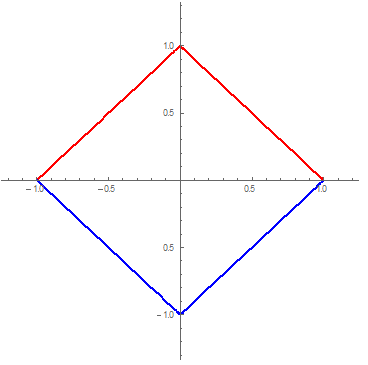
1b. Four parametrized segments along 0 ≤ t ≤ 4:
- c(t) = (1,0) + (−1,1)t for 0 ≤ t ≤ 1
- c(t) = (0,1) + (−1,−1)(t−1) for 1 ≤ t ≤ 2
- c(t) = (−1,0) + (1,−1)(t−2) for 2 ≤ t ≤ 3
- c(t) = (0,−1) + (−1,1)(t−3) for 3 ≤ t ≤ 4
1c. For f(x,y) = |x| + |y|, our curve is the level curve f(x,y) = 1. Graph:
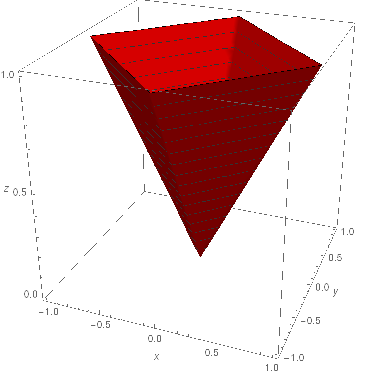
2a. f(x,y) = x + 3y. Level curves: f(x,y) = c , y = −⅓x + k parallel lines. Ribs: z = f(x,c) = x + k , z = f(c,y) = 3y + k lines.
2b. f(x,y) = x2 + y . Level curves: f(x,y) = c , y = −x2 + k parabolas. Ribs: z = f(x,c) = x2 + k upward parabolas , z = f(c,y) = k + y lines.
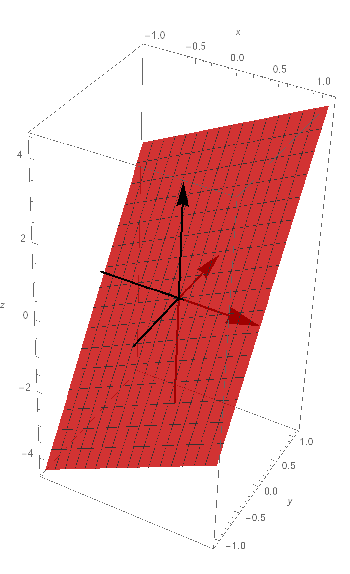
2c. f(x,y) = xy . Level curves: f(x,y) = c , y = c⁄x hyperbolas. Ribs: z = f(x,c) = cx , z = f(c,y) = cy steeper & steeper lines, z = f(x,x) = x2 upward parabola, z = f(x,−x) = −x2 downward parabola.
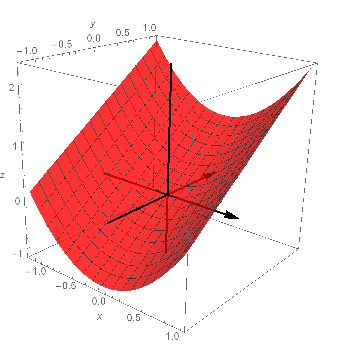
2d. f(x,y) = x3 − 3x − y2 . Level curves: f(x,y) = c , y = √(c − x3 + 3x) ?? Ribs: z = f(x,c) = x3 − 3x − k cubic with hill & valley, z = f(c,y) = − y2 + k downward parabola.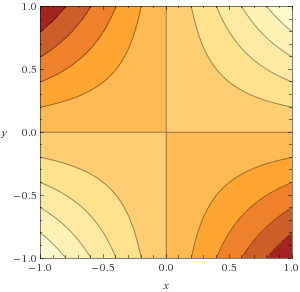
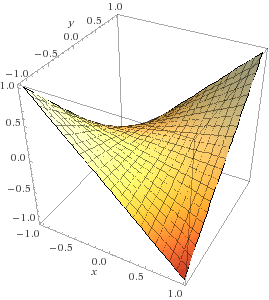
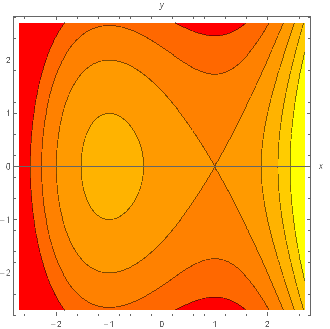
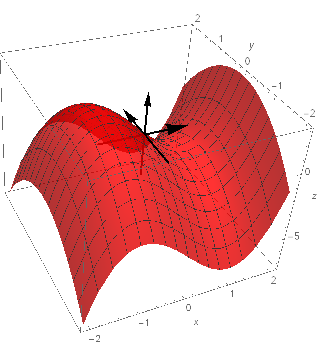
- 1/19 Recitation 2:
Zoo of functions (WHW 2). Bring laptop.
⊞
Zoo of curves
- Lemniscate of Bernoulli: r = a √(cos(2θ)): inversion of hyperbola; locus where prod of distances from F & F' = a2, where dist(F,F') = a; vertical slice of a torus tangent to the inner ring (equal to girth of tube)
- Lissajous curves x = sin(at+c), y = sin(bt)
- Rose curves r = cos(kθ); 2k petals for k even, k petals for k odd
- Cardioid epicycloid r = 2(1−cos(θ)) = 4 sin2(θ⁄2), inverted parabola, horizontal tangent
- False cardioid r = 4 sin(θ⁄2), continues to −2π ≤ θ ≤ 2π
- 1/20 Lect 5.
⊞
Lin approximations DF: c'(a), ∂f⁄∂x(a,b), ∇f(a,b).
⊞ Soln
-
For f : R → R, deriv f '(a) is slope of best (affine) linear approx:
f(x) ≈ f(a) + f '(a)(x−a) for x ≈ a, or f(a+h) ≈ f(a) + f '(a) h -
Deriv of c(t) at t = a: best linear approx for t ≈ a,
c(t) ≈ c(a) + c'(a) (t−a) = tangent line; or c(a+h) ≈ c(a) + c'(a) h
Find c'(a) = ?? From calculus, approximate each component:
(x(a+h), y(a+h)) ≈ (x(a) + x'(a) h , y(a) + y'(a) h) = c(a) + (x'(a),y'(a)) h.
Thus: c'(a) = (x'(a), y'(a)) -
Deriv of f : R2 → R is best linear approx
for v ≈ a = (a,b),
f(v) ≈ f(a) + ∇f(a)•(v−a) = tangent plane, or f(a+h) ≈ f(a) + ∇f(a)•h
Gradient vector ∇f(a) = (d1, d2) = ??
f(a+h, b) ≈ f(a,b) + (d1,d2)•(h,0) = f(a,b) + d1h
Thus: d1 = d⁄dxf(x,b)|x=a = ∂f⁄∂x(a,b); similarly d2 = d⁄dyf(a,y)|y=b = ∂f⁄∂y(a,b) -
Tangent plane approx for (x,y) near (a,b):
f(x,y) ≈ f(a,b) + ∂f⁄∂x(a,b) (x−a) + ∂f⁄∂y(a,b) (y−b)
Partial derivative ∂f⁄∂x(a,b) is slope in x-direction -
Gradient is vector of partial derivatives:
∇f(a) =
(∂f⁄∂x(a), ∂f⁄∂y(a))
Gradient vector field: ∇f(v) gives an arrow at each v = (x,y).
Draw gradient field for examples from Lect 4.
Vector field plotter
Fact: ∇f(a) is uphill direction, length = uphill slope
HW: Look at WHW 3 due 1/27 below.- Consider the curve c(t) = (t2, t3) for t ∈ (−∞, ∞).
- Draw the curve by hand-plotting points for some sample t-values, then check this against a computer plot.
- Solve for t as a function of x, and use this to write y = f(x), possibly needing more than one graph. Sketch this graph, and compare the result with part (a).
- Find the tangent vector c'(t) at t = 1. Zoom in on your plot of c(t) near c(1) and verify that the curve looks indistinguishable from the parametrized line c(1) + c'(1)(t−1). (Here c'(1) is the velocity vector of a particle moving along c(t), at time t = 1; the length |c'(1)| is its speed.)
- The tangent vector at t = 0 is zero. How to describe the corresponding motion of a particle along c(t)?
- Consider the function f : R2 → R given by
f(x,y) = x2 + y, near the point (x,y) = (2,1).
- Compute the linear approximation f(x,y) ≈ f(2,1) + ∇f(2,1)•(x−2,y−1) for (x,y) ≈ (2,1).
- Zoom in on the contour map of f(x,y) near (x,y) = (2,1). Compare it with contour map of the approximation g(x,y) = f(2,1) + ∇f(2,1)•(x−2,y−1). If you zoom enough, the two should look the same: this is the defining property of the derivative ∇f(2,1).
- Draw the gradient vector ∇f(2,1) onto the contour map of f, starting at (2,1). Note that it is perpendicular to the level curve through (2,1), and points uphill, in the direction of maximum increase of f.
- For each function f(x,y) = x+3y, x2+y, in HW 4 #2a,b, compute the derivative (gradient vector) ∇f(x,y) = (∂f⁄∂x(x,y), ∂f⁄∂y(x,y)). At grid points (x,y), draw ∇f(x,y) as an arrow starting at (x,y): this is the gradient vector field, another way of picturing f. (Use the computer if it's too complicated.) Compare the gradient field with the contour map of the function in the HW 4 solutions, and verify that the gradient vectors are perpendicular to the level curves f(x,y) = c. Also verify: closer level curves ⇔ steeper 3D-graph slope ⇔ longer gradient vector.
1a. c(t) = (t2, t3)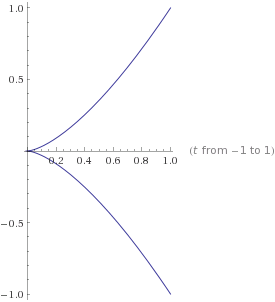
1b. Eliminating t from the system of equations {x = t2 , y = t3} gives t = ±√x, and y = ±x3/2 (two graphs). The function x3/2 rises faster than y = x, but not as fast as y = x2.
1c. The derivative is: c'(t) = (2t, 3t2), so c'(1) = (2,3). The linear approximation (red tangent line) is:
ℓ(t) = c(1) + c'(1)(t−1) = (1,1) + (2,3)(t−1) = (2t−1, 3t−2), which is very close to the original curve (black) even in a window of width 1.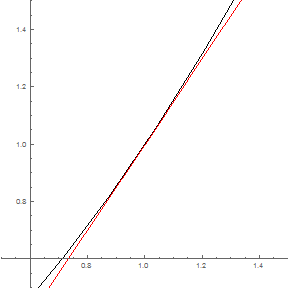
1d. c'(a) = 0 means zero velocity at time t = a. Here, the particle traveling along the curve slows down as it approaches time t = 0, stops, then gradually starts again in the opposite direction. No matter how it is represented, the curve has no well-defined tangent line at (x,y) = (0,0).
2a. The function f(x,y) = x2 + y has ∇f(x,y) = (2x,1), with ∇f(2,1) = (4,1). The linear approximation for (x,y) ≈ (2,1) is:
ℓ(x,y) = f(2,1) + ∇f(2,1)•(x−2,y−1) = 5 + (4,1)•(x−2,y−1) = 4x + y − 1. 2b. Comparing the plots of f(x,y) and the linear approximation ℓ(x,y) zoomed in near (2,1) shows they are very close:
2c. The gradient vector ∇f(2,1) = (4,1) is scaled down to fit in the picture above. Notice that it is perpendicular to the level curve f(x,y) = 5 through (2,1), and points toward the direction of fastest increase of f(x,y), shown by lighter colors in the contour map. To explain why, note that the linear approximation f(x,y) ≈ ℓ(x,y) = 5 + (4,1)•(x−2,y−1) measures the "height" of the vector from (2,1) to (x,y), considering direction (4,1) as "up": this "height" increases fastest exactly in the direction (4,1).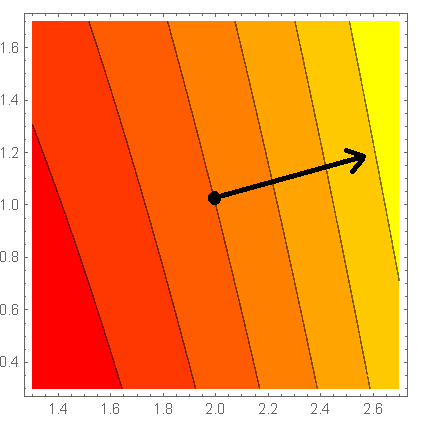
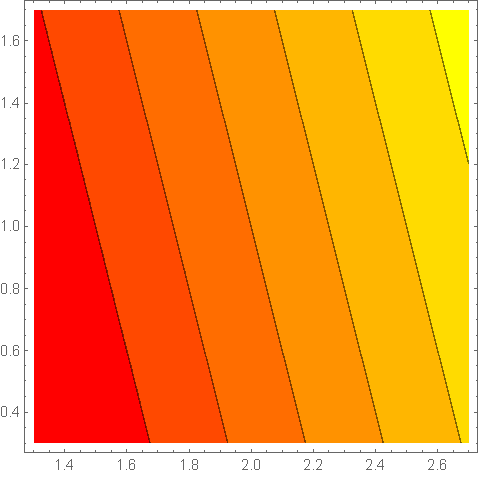
3a. f(x,y) = x + 3y , ∇f(x,y) = (1,3). That is, we draw the same vector (1,3) at each point (x,y), scaled down to fit the picture:

3b. f(x,y) = x2 + y , ∇f(x,y) = (2x,1). At a grid point (x,y), we draw an arrow (scaled) with vertical component 1, and horizontal component 2x: pointing to the right for x > 0, up for x = 0, and left for x < 0. Notice the vectors get longer near the sides, as the level curves get closer and the graph gets steeper.

-
For f : R → R, deriv f '(a) is slope of best (affine) linear approx:
- 1/23 Lect 6.
⊞
Directional ∂f⁄∂v & ∇f. Critical pts ∇f = (0,0), max/min probs
⊞ Soln
- Draw gradient vector field examples: linear, paraboloid, cone.
Each arrow represents a linear approximation ℓ(v) = ∇f(a)•v for v near a
Analogy to 1-dim derivative vector field (& graph, level marks) - Directional deriv ∂f⁄∂w(a)
= limh→0 (f(a+wh)−f(a))/h
= slope of graph above line ℓ(t) = a+wt if unit vector |w| = 1
Lin approx f(a+wh) ≅ f(a) + ∇f(a)•wh ⇒ ∂f⁄∂w(a) = ∇f(a)•w - Max slope of graph =
max|w|=1 ∇f(a)•w
= maxθ |∇f(a)| cos(θ)
= |∇f(a)| = gradient length, when θ = 0, w = ∇f(a)⁄|∇f(a)| = gradient direction
Lesson: w = ∇f(a) is direction of fastest increase of f(v) from v = a
|∇f(a)| is maximum slope - Critical point: (a,b) where ∇f(a,b) = (0,0):
all dir derivs are zero, flat point of graph z = f(x,y)
Types: max, min, saddle, ridge (graph & contour pictures) - To find max/min of f(x,y), candidates are critical points and boundary points
- Max/min example: Closest approach between y = x2 and y = x−1.
- Parametrize (t, t2), (s, s−1), square dist fun D(s,t) = (t−s)2 + (t2−(s−1))2 = min
- Inspect contour map to find crit pt
- Solve
∂D⁄∂t = 0, ∂D⁄∂s = 0, add eqns
⇒ (t,s) =
(1⁄2 ,7⁄8)
Boundary t,s → ∞ makes D → ∞ = max - Gradient flow method to approximate max pt
Start at guess point ao, follow ∇f(ao) to get to better (higher) point a1
HW: Start WHW 3 due 1/27 below.- Consider the function f(x,y) = xy.
- Sketch the graph z = xy. Hint: Draw the vertical slices above the radial lines y=0, x=y, x=0, x=−y. The result should be familiar.
- Sketch the contour map of level curves xy = c. Hint: What curve is y = c/x?
- Sketch the gradient vector field ∇f(v). That is, compute the gradient ∇f(x,y) = (∂f⁄∂x(x,y), ∂f⁄∂y(x,y)), and at each grid point (x,y) = (a,b) draw the arrow ∇f(a,b).
- Explain why the critical point looks the way it does in the three pictures.
- For the function f(x,y) = x4 − 2x2 − 3(2x+1)y2,
have a computer draw its graph, contour map and gradient vector field.
Locate the critical points by
solving ∇f(x,y) = (0,0),
and verify the answers visually on your gradient plot.
Visually classify each critical point as:
- a local maximum (hill), where the gradient arrows all point in
- local minimum (bowl), where the arrows point out
- saddle point, where the arrows point in along one direction, out along another direction.
- ridge or ditch, where the vectors vanish along a ridgeline curve, with the surrounding vectors pointing toward (or away from) the ridgeline
- Max/min: Consider a rectangular bin having a bottom but no top, and three sides with the fourth side open. Assuming it has volume 1, find the
length, width and height which will minimize
the total surface area of the three sides and bottom.
Hint: Write the surface area as s(x,y), a function of the length x and width y (with the height z determined by volume = 1). Then the unique critical point, where ∇s(x,y) = (0,0), is the minimum point of s(x,y).
1a,b,c. f(x,y) = xy , ∇f(x,y) = (y,x).


2. f(x,y) = x4 − 2x2 − 3(2x+1)y2:
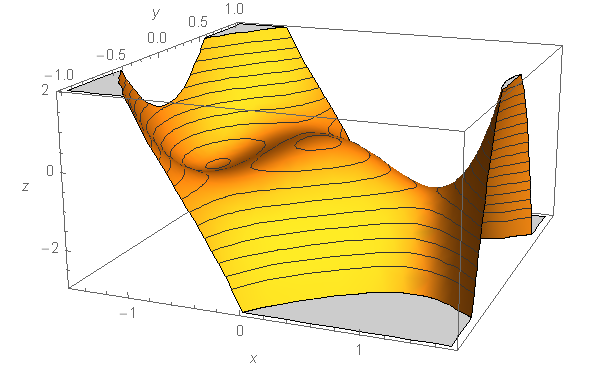
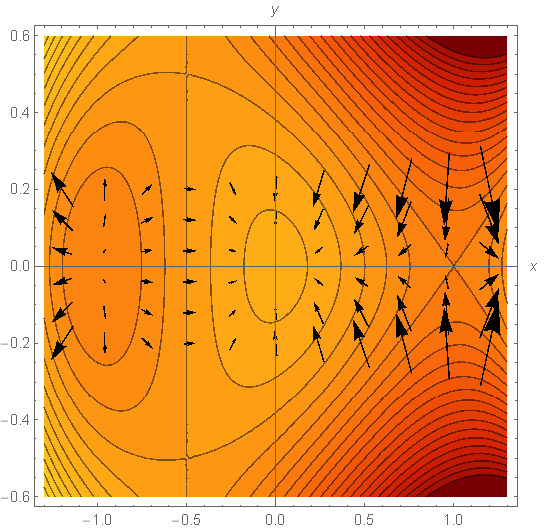
- (x,y) = (−1,0), a local min for f(x,y), a bowl in the graph, a darkening bullseye in the countour map, and an outflow point for the gradient vectors
- (x,y) = (0,0), a local max for f(x,y), a hill on the graph, a lightening bullseye in the contour map, and an inflow point for the gradient vectors
- (x,y) = (1,0), a pause point for f(x,y), a saddle point on the graph, an X on the countour map, with gradient vectors flowing in along the vertical direction and flowing out along the horizontal direction
- (x,y) = (−1⁄2, ±1⁄2), two more saddle points.
3. Letting x,y,z be the side-lengths of the rectangular bin, the volume is xyz = 1, and the surface area of the four sides is s = xy + yz + 2xz. Eliminating the variable z = 1⁄xy, we get the function
s(x,y) = xy + 1⁄x + 2⁄y for x,y > 0. The gradient field is: ∇s(x,y) = (y − 1⁄x2 , x − 2⁄y2):
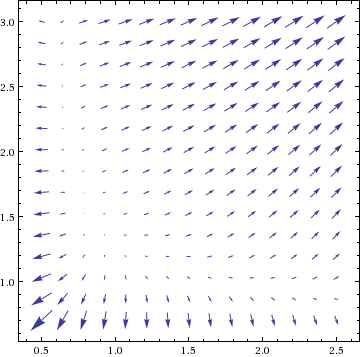
The only critical point, where ∇s(x,y) = (y − 1⁄x2, x − 2⁄y2) = (0,0), is (x,y) = (2−1/3, 22/3) ≈ (0.8, 1.6). The vector field plot shows this is a local minimum, since the uphill vectors all point outward from this point. For completeness, we should also consider the critical points where ∇s is undefined, namely the boundary points where x = 0 or y = 0; but these are clearly vertical asymptotes where s(x,y) tends to infinity.
Thus, our final answer is: (x,y,z) = (2−1/3, 22/3, 2−1/3). - Draw gradient vector field examples: linear, paraboloid, cone.
- 1/25 Lect 7.
⊞
Parametrization F(u,v) = (x,y), polar coordinates P(r,θ) = (x,y).
⊞ Soln
- Function F : R2 → R2,
F(u,v) = (f1(u,v), f2(u,v)) = (x(u,v), y(u,v))
Transformation moves and stretches plane: picture u,v grid lines in x,y plane - Linear F(u,v) = Shear(u,v) = (u+v, v), squashed grid
- Translation F(u,v) = Tran(u,v) = (u+½, v−⅓), shifted grid
- Polar coord map P(u,v) = (u cos(v), u sin(v))
or P(r,θ) = (r cos(θ), r sin(θ))
Polar grid, not a rotation mapping
Domain (r,θ) ∈ [0,∞) × [0,2π) - Parametrize a region: R = half-circle x2 + y2 ≤ 4, x ≥ 0
P(r,θ) for parameter region (r,θ) ∈ R* = [0,2]×[−π⁄2,π⁄2] - Ellipse R, (x−1)2 + 4y2 = 1,
define elliptical coords
F(u,v) = (1 + u cos(v), ½u sin(v)) for parameter region (u,v) ∈ R* = [0,1]×[0,2π]
HW: Continue WHW 3 due 1/27 below.- Parametrize a triangle
- Consider a (u,v)-grid in the (x,y)-plane
R2 whose u-lines (red) are
parallel to the vector (2,1), and whose v-lines (blue)
are parallel to (1,3).

- Consider the triangular region R (light blue) with vertices (0,0), (2,1), (1,3). Find a triangular parameter region R* in the (u,v) plane which is taken to R by the mapping L: that is, L parametrizes R by R*. (Define R* in terms of inequalities such as u ≥ 0 and v ≤ f(u) for some function f.)
- Now let R be any triangular region in the (x,y) plane with vertices a, b, c. Generalize the above exercise to define an affine linear function F(u,v) and a parameter region R* which parametrize R. (It may be convenient to define F(u,v) in terms of the vectors b−a, c−a, rather than in coordinates.)
- Consider a (u,v)-grid in the (x,y)-plane
R2 whose u-lines (red) are
parallel to the vector (2,1), and whose v-lines (blue)
are parallel to (1,3).
- Inversion mapping
- Let F : R2 → R2 be the mapping which takes a non-zero vector (u,v) to a vector (x,y) with the same direction and the reciprocal radius: that is, F turns the unit circle "inside out" so that its interior is stretched to cover the whole plane outside the circle, and region outside the circle is squashed inside. Find a vector formula for F(v), as well as a coordinate formula F(u,v) = (x,y).
- Sketch the F(u,v)-grid produced by the above mapping in the (x,y)-plane. Hint: The integer grid lines in the (u,v) plane are all taken to small circles inside the unit circle. Since each (u,v)-grid line goes to infinity in the (u,v)-plane, its image goes to the origin in the (x,y)-plane. These are called Apollonian circles.
- Extra Credit: Inverting familiar curves in the (u,v) plane gives interesting new curves in the (x,y) plane. The inversion of the parabola v = u2 − 1 is called the cardioid: you can parametrize it as c(u) = (x(u), y(u)) = F(u, u2−1). Similarly, the inversion of the hyperbola u2 − v2 = 1 is called the lemniscate of Bernoulli. Explore these curves, and say as much as you can about them, showing how the inversion definition is equivalent to the usual ones you can find online. For example, find (x,y) equations defining these curves, or polar coordinate equations r = f(θ). Does the inversion mapping give insight on their properties?
- Parametrizing rotated objects
- Parametrize the region R bounded by the ellipse x2⁄4 + y2⁄9 = 1. That is, find a function F(u,v) which takes some simple (u,v)-region R* to R. Hint: The extreme points of the ellipse are (±2,0) and (0,±3). Stretch the x and y coordinates of the usual polar parametrization of the unit disk to get the correct height and width.
- Now parametrize the same ellipse, but rotated 45° and with its center shifted to (1,2). Hint: Take the the previous parametrization mapping, then compose it with rotation and translation mappings.
1a. We just need the (u,v) coordinate axis vectors to map as L(i) = (2,1) and L(j) = (1,3), and the rest of the grid follows. Thus L(u,v) = (2,1)u + (1,3)v = (2u+v, u+3v). Note that the matrix of L is [
].2 1 1 3 1b. The parameter region is the standard triangle with vertices (u,v) = (0,0), (1,0), (0,1). That is, R* = {(u,v) with 0 ≤ u and 0 ≤ v ≤ 1−u} = {(u,v) with u ≥ 0, v ≥ 0, u+v ≤ 1}.
1c. F(u,v) = a + (b−a)u + (c−a)v will take the standard (u,v) grid to the grid generated by the edge-vectors b−a and c−a, with the origin taken to a. Use the previous parameter region R* = {(u,v) with u ≥ 0, v ≥ 0, u+v ≤ 1}.
2a. The vector parallel to v = (u,v), having length 1⁄|v|, is F(v) = v⁄|v|2, which means F(u,v) = ( u⁄u2+v2 , v⁄u2+v2 ).
2b. To see the transformation of the (u,v) grid under the mapping F(u,v), apply a parametric curve plotter successively to c(t) = F(1,t), F(2,t), F(3,t) gives red circles labeled u = 1,2,3 with diameter 1, 1⁄2, 1⁄3, all passing through the origin and with centers on the y-axis. Similarly for blue circles c(t) = F(t,1), F(t,2), F(t,3) centered on the x-axis.

3a. F(r,θ) = (1⁄2 r cos(θ), 1⁄3 r sin(θ)) over the region (r,θ) ∈ R* = [0,1]×[0,2π].
3b. The rotation map Rotπ⁄4 is defined by a rotation matrix which works out to Rot(x,y) = 1⁄√2(x+y, x−y). Applying this to the output of the previous F(r,θ), then translating by (1,2), gives:
G(r,θ) = ( 1 + r⁄2√2 cos(θ) + r⁄3√2 sin(θ) , 2 + r⁄2√2 cos(θ) − r⁄3√2 sin(θ) ). Here we should think of r as measuring an "elliptically scaled" radius measured from the center of the tilted, translated ellipse; and θ as measuring a squashed "elliptical angle". - Function F : R2 → R2,
F(u,v) = (f1(u,v), f2(u,v)) = (x(u,v), y(u,v))
- 1/26 Recitation 3: Critical pts, max/min problems, gradient flow method (spreadsheet).
- 1/27 Lect 8.
⊞
Coordinate funs u(x,y), v(x,y).
Derivative DFa, Jacobian matrix [DFa].
- Picture F : R2 → R2, F(u,v) = (x,y)
F(u,v)-grid in (x,y)-plane is set of parametrized curves
c(v) = F(a,v) , c(u) = F(u,b) for const a,b - Inverse function of F(u,v) = (f1(u,v),
f2(u,v)) = (x,y)
F−1(x,y) = G(x,y) = (g1(x,y), g2(x,y)) = (u,v)
Solve x = f1(u,v), y = f2(u,v) ⇒ u = g1(x,y), v = g2(x,y) - F(u,v)-grid in (x,y)-plane is two contour maps: u(x,y) = a , v(x,y) = b
- Review definition of deriv: f(x) ≈ f(a) + f '(a)(x−a) ⇔
f '(a) ≈ (f(x)−f(a))⁄(x−a)
f(a+h) ≈ f(a) + f '(a)h ⇔ f '(a) ≈ (f(a+h)−f(a))⁄h
Lin approx f(a+h) ≈ f(a) + ∇f(a)•h is valid, but diff quotient makes no sense - Deriv of F(u,v) = (f1(u,v), f2(u,v)) = (x,y):
curved grid looks linear close up
f1(a+h) f2(a+h) ≈ f1(a) + ∇f1(a)•h f2(a) + ∇f2(a)•h = f1(a) f2(a) + ∇f1(a) ∇f2(a) • [h] . Jacobian matrix:
[DFa] = ∇f1(a) ∇f2(a) = ∂f1⁄∂u(a) ∂f1⁄∂v(a) ∂f2⁄∂u(a) ∂f2⁄∂v(a) = ∂x⁄∂u(a,b) ∂x⁄∂v(a,b) ∂y⁄∂u(a,b) ∂y⁄∂v(a,b) - Ex: Jacobian of polar coord mapping P(r,θ) = (r cos(θ), r sin(θ))
Thus near a point like (r,θ) ≈ (3,π⁄4),[DP(r,θ)] = ∂⁄∂r(r cos(θ)) ∂⁄∂θ(r cos(θ)) ∂⁄∂r(r sin(θ)) ∂⁄∂θ(r sin(θ)) = cos(θ) −r sin(θ) sin(θ) r cos(θ) P(r,θ) ≈ P(3,π⁄4) + DP(3,π⁄4)(r−3,θ−π⁄4)
Lin approx of polar grid near (ro,θo): DP(ro,θo) = Rotθo∘ Dil(1,ro) Reading: [MT] Ch 2.3 pp. 111−113, including HW:= 3 cos(π⁄4) 3 sin(π⁄4) + cos(π⁄4) −3 sin(π⁄4) sin(π⁄4) 3 cos(π⁄4) • r − 3 θ − π⁄4 - Consider the function: F(u,v) = (uv, u⁄v) = (x,y) over the parameter domain u,v > 0.
- Draw the grid produced by F(u,v) in the (x,y)-plane, by sketching some sample curves of the form c(u) = F(u,b) and c(v) = (a,v) for a,b = 1,2,3,... Hint: A curve like c(v) = (2v, 2⁄v) = (x,y) is a parametrization of the hyperbola graph y = 4⁄x .
- Compute the inverse function F−1(x,y) = G(x,y) = (u,v). That is, given a point (x,y), solve for (u,v) in the system of equations x = uv , y = u⁄v .
- Re-draw the (u,v)-grid in the (x,y)-plane as the level curves u(x,y) = a and v(x,y) = b.
- Find the Jacobian matrix [DF(1,2)] at (u,v) = (1,2). Determine the (affine) linear approximation F(u,v) ≈ A(u,v) near (u,v) ≈ (1,2).
- Draw the grid of the approximation function A(u,v) near (u,v) ≈ (1,2) and (x,y) ≈ A(1,2) = F(1,2). (Take sample grid lines at 1⁄4 intervals.) Show this is locally close to the grid of the original function F(u,v).
1a. For F(u,v) = (uv, u⁄v), the horizontal v-gridlines (u,b) become c(u) = F(u,b) = (bu,u⁄b), parametrizing lines y = x⁄b2 getting squashed toward the x-axis. The vertical u-gridlines (a,v) become c(v) = F(a,v) = (av,a⁄v), parametrizing equally spaced hyperbolas y = a2⁄x.
1b. For u,v > 0, the equations x = uv, y = u⁄v are equivalent to u = √(xy), v = √(y⁄x), so:
F−1(x,y) = (√(xy), √(y⁄x)) = (u,v). 1c. The v-gridlines are indeed of the form v = √(y⁄x) = b, meaning y = x⁄b2. The u-gridlines are u = √(xy) = b, meaning y = a2⁄x.
1d. The Jacobian of F(u,v) = (uv, u⁄v) = (x,y) at (u,v) = (1,2) is:
Thus DF(1,2)(h1, h2) = (2h1+h2, 1⁄2h1−1⁄4h2). This means that for (u,v) ≈ (1,2), we have:[DF(1,2)] = ∂x⁄∂u ∂x⁄∂v ∂y⁄∂u ∂y⁄∂v = ∂⁄∂u(uv) ∂⁄∂v(uv) ∂⁄∂u(u⁄v) ∂⁄∂v(u⁄v) = v u 1⁄v −u⁄v2 = 2 1 1⁄2 −1⁄4 F(u,v) ≈ A(u,v) = F(1,2) + DF(1,2)(u−1,v−2)
= ( 2+2(u−1)+(v−2) , 1⁄2+1⁄2(u−1)−1⁄4(v−2) ).1e. Zooming in near F(1,2) = (2,1⁄2), the curvy F(u,v)-grid at left is close to the linear A(u,v)-grid at right. The smaller the window, the closer the two grids:


- 1/30 Lect 9. ⊞ Product and Chain Rules
Soln- Theme: Close up, any smooth function looks like a linear function.
- Product Rule: To find derivative of product, multiply linear approx
∇(fg)(a) = f(a) ∇g(a) + ∇f(a) g(a) - Chain Rule for f,g : R → R, compose linear approximations:
f(g(a+h)) ≈ f( g(a) + g'(a)h ) ≈ f(g(a)) + f '(g(a)) g'(a)h
So: (f(g(t)))' = f '(g(t)) g'(t) , d⁄dt(f(g(t))) = df⁄dx(g(t)) dg⁄dt(t)
Ex: d⁄dt(sin(t2)) = sin'(t2) (t2)' = cos(t2) 2t - Chain Rule for f : R2 → R ,
c : R → R2 ,
c(t) = (x(t), y(t)) ,
f∘c : R → R,
f(c(a+h)) ≈ f( c(a) + c'(a)h ) ≈ f(c(a)) + ∇f(c(a)) • c'(a)h
So: d⁄dtf(g(t)) = ∇f(c(t)) • c'(t) = ∂f⁄∂xdx⁄dt + ∂f⁄∂ydy⁄dt
Ex: f(x,y) = sin(xy) , c(t) = (x(t),y(t))= (t2, t+1) , f(c(t)) = sin(t2(t+1))
d⁄dt sin(t2(t+1)) = ∇sin(xy) • d⁄dt(t2, t+1)
= (cos(xy) y , cos(xy) x) • (2t, 1)
= cos(xy) (x(2t) + y(1)) = cos(t2(t+1)) (2t3+t+1) - Chain Rule for
F,G : R2 → R2
Compose linear approximations: D(F∘G)a(h) = DFG(a)( DGa(h) )
Multiply Jacobian matrices: [D(F∘G)a] = [DFG(a)] • [DGa]
Ex: L(x,y) = Shear(x,y) = (x+y, y), P(r,θ) = (r cos(θ), r sin(θ)) = (x,y) ,
L(P(r,θ)) = (r(cos(θ)+sin(θ)), r sin(θ)) sheared polar coord map
[D(L∘P)(r,θ)] = [DL(x,y)] • [DP(r,θ)] = [L] • [DP(r,θ)], multiply Jacobian matrices
HW- Given a function f(x,y), its polar coordinate form is g(r,θ) = f(r cos(θ), r sin(θ)). Find the gradient ∇g(r,θ) using the Chain Rule.
- First, use the matrix form of the Chain Rule, multiplying the gradient of f(x,y) by the Jacobian matrix of the polar coordinate map P(r,θ).
- Redo this using the letter-form of the Chain Rule:
for z = f(x,y), x = r cos(θ), y = r sin(θ),
we have:
∂z⁄∂r = ∂z⁄∂x ∂x⁄∂r + ∂z⁄∂y ∂y⁄∂r , and similarly for ∂z⁄∂θ.
- A polar graph is a curve around the origin in which the radius is a function of the angle: r = r(θ). That is, the curve c(t) = P(r(θ), θ), where P(r,θ) is the polar coordinate mapping. Use the Chain Rule to compute the tangent vector of this curve at a given value of θ.
- Given functions f,g : R2 → R, we showed the Product Rule for ∇(fg)
by multiplying linear approximations. Here is another proof, assuming the Chain Rule.
Consider the multiplication function m(x,y) = xy, and F(x,y) = (f(x,y), g(x,y)), where F : R2 → R2. Then we can write the product function as: f(x,y) g(x,y) = m(F(x,y)). Compute the derivative matrices [∇m] and [DF], and apply the Chain Rule to deduce the derivative of the product. - Given f,g : R2 → R, find the gradient (derivative) of h(x,y) = f(x,g(x,y)). Hint: Write h(x,y) as a composite of f(x,y) and a function G : R2 → R2.
- 2/1 Lect 10. ⊞ Vector field F(x,y): grad & non-grad fields.
⊞ Soln- Vector field: F : R2 → R2, F(x,y) = (p(x,y), q(x,y))
F(x,y) = arrow drawn at point (x,y), field of wheat stalks
Same data as F(u,v) = (x,y) motion of plane, different geometric meaning
Vector field plotter - Gradient vector field F(x,y) = ∇f(x,y)
⇒ draw contour map, level curves f = n
Gradient arrows are perpendicular to level curves, cutting straight across them
Proof: Parametrized level curve c(t) has f(c(t)) = const for all t
So d⁄dtf(c(t)) = (const)', by Chain Rule ∇f(c(t)) • c'(t) = 0
So gradient vector orthogonal to level curve tangent vector
Distance d between level curves f = n and f = m:
|∇f| = slope between level curves = rise⁄run ≈ (m−n)⁄d, so d ≈ (m−n)⁄|∇f| - Ex: F(x,y) = ∇(x2+y2) = (2x,2y), F(v) = 2v
vanishes at (0,0), radial, gets longer outward
F(x,y) = (0,y), vertical vectors ⇒ horiz level curves, F(x,y) = ∇(y2) trough function
F(x,y) = (y,0), horiz vectors, river with no flow on x-axis, opposite flows above & below
If F = ∇f level curves vertical, but uphill arrow inconsistent, so F not gradient
F(x,y) = (−y,x), F(v) = v⊥ turn-table velocity field, circular flows
F ≠ ∇f: level curves radial, values inconsistent at different radii
HW: No Weekly HW due this week.- Rectangular vector fields.
Sketch the following by hand.
- F(x,y) = 2i + j = (2,1), constant arrows
- F(x,y) = sin(x) j = (0, sin(x)), vertical arrows with length oscillating as (x,y) moves horizontally
- F(x,y) = cos(x) i = (cos(x), 0), horizontal arrows with length oscillating as (x,y) moves horizontally
- F(x,y) = cos(x) i + sin(x) j = (cos(x), sin(x)), unit arrows rotating as (x,y) moves horizontally
- Which of the above could be gradient fields? If so, find f(x,y) with F = ∇f. If not, find an inconsistency involving possible contour lines.
- Polar vector fields (radial + circular).
Sketch the following by hand.
Notation: v = (x,y), v⊥ = (−y,x) = 90° rotation of v.- F(v) = v⁄|v| unit-length radial
- F(v) = v⊥⁄|v| unit-length circular
- F(v) = v⊥⁄|v| − v⁄|v| whirlpool
- For each pictured vector field, give a formula which produces the picture, at least approximately.
-
- Find the unique circular vector field F(v) = g(|v|) v⊥ which is a gradient, F(v) = ∇f, at least in most of the plane. Try to draw the contour map and imagine the graph of f(x,y). Hint: the total circular gradient flow between two radial contour lines must be the same for any radius: this determines the magnitude.
1,2. Use the vector field plotter to check your sketches. Some principles: Know a few basic vector fields, such as constant fields F = i, j radial field F(v) = v, rotation field F(v) = v⊥; how to scale (stretch) them by given functions f(x) and f(y); and how to combine them by adding the vectors at each point. Given a formula for F, build it up from simple fields by known operations.3a. Vertical, so (0, g(x,y)), length depends only on height, so (0, g(y)). Ans: F(x,y) = (0, y2) = ∇(0, ⅓y3)
3b. Clearly g(x,y) (1,1), length depends only on x, so g(x) (1,1). Ans: F(x,y) = x(1,1) = (x,x)
3c. Radial unit length would be F(v) = v⁄|v|. To adjust length by radius, scale: g(|v|) v⁄|v|. Here, g(0) = 1, g(1) = 0, g(r) < 0 for r > 1; take g(r) = 1−r. Ans: (1−√(x2+y2)) (x,y)⁄√(x2+y2) .
4. To have consistent circular flows, the circular gradient field must have magnitude |F(v)| = 1⁄|v|, so take g(|v|) = 1⁄|v|2. Then z = f(x,y) has radial level curves, and is a helical staircase surface, in which the height of a radial line equals its polar angle: f(x,y) = θ = arctan(y⁄x), at least for x > 0.
- 2/2
Recitation 4: Zoo of vector fields. Discussion along the lines of HW 2/1.- 2/3 Lect 11. ⊞ Line integral ∮∇f•dc, Gradient Theorem.
⊞ Soln- Integral of f(x) over interval t ∈ [0,a]
Sample points 0 = t0 < t1 < ... < tn = a, increments Δti = ti+1−ti
∫a0 g(t) dt = limn→∞ ∑ n=0 n−1 g(ti) Δti , limit of Riemann sums -
Ex: g(t) = sin(t), t ∈ [0,3⁄2]
sample points 0 < 0.5 < 1.0 < 1.5 , Δti = 0.5
∫01.5 sin(t) dt ≈ sin(0)(0.5) + sin(0.5)(0.5) + sin(1)(0.5) ≈ 0.66
More accuracy: extra sample points near start, where g(t) steeper
0 < 0.1 < 0.3 < 0.5 < 1.0 < 1.5
∫10 2t dt ≈ sin(0)(0.1) + sin(0.1)(0.2) + sin(0.3)(0.2)
+ sin(0.5)(0.5) + sin(1.0)(0.5) ≈ 0.74 - Fundamental Theorem:
Integral of rate of change is total change
∫0a f '(t) dt = f(a) − f(0).
Ex: Anti-derivative sin(t) = (−cos(t))', so:
∫01.5 sin(t) dt = (−cos(1.5)) − (−cos(0)) ≈ 0.93
Argument: linear approx for t ≈ ti , f(t) ≈ f(ti) + f '(ti)(t−ti),
so f-increment f(ti+1) − f(ti) ≈ f '(ti)(ti+1−ti) = f '(ti)Δti
∫0a f '(t) dt ≈ ∑ i=0 n−1 f '(ti) Δti ≈ ∑ i=0 n−1 (f(ti+1)−f(ti))
= f(tn) − f(t0) = f(a) − f(0)
Sum of f-increments equals total change in f - Given vector field F(x,y) = ∇f(x,y),
define line integral to recover f(a,b).
Reverse the above argument.
Take curve c(t) with start c(0) = (0,0), end c(1) = (a,b).
Subdivide curve: 0 = t0 < t1 < ... < tn = 1, points ci = c(ti)
Lin approx for v ≈ ci , f(v) ≈ f(ci) + ∇f(ci)•(v−ci)
so f-increment f(ci+1) − f(ci) ≈ ∇f(ci)•(ci+1−ci) = ∇f(ci)•Δci
Total change in f equals sum of f-increments:
f(a,b) − f(0,0) ≈ ∑ i=0 n−1 (f(ci+1)−f(ci)) = ∑ i=0 n−1 ∇f(ci)•Δci
Last expression approximates a new kind of integral: ∮c ∇f(c)•dc - Line integral of F(x,y) over curve
c(t) is defined as:
∮c F(c)•dc = limn→∞ ∑ i=0 n−1 F(ci)•Δci
for sample points c0 < ... < cn on c(t), Δci = ci+1 − ci - Gradient Theorem: For any curve c(t) from (0,0) to (a,b):
∮c ∇f(c)•dc = f(a,b) − f(0,0).
We defined the line integral to make this true. - Ex: Field F(x,y) = ∇f(x,y) = (1, 6y),
integrated along c(t) = (t,t2) from (0,0) to (2,4)
sample points c0 = (0,0), c1 = (1,1), c2 = (2,4)
f(2,4)−f(0,0) = ∮c F(c)•dc ≈ F(0,0)•(c1−c0) + F(1,1)•(c2−c1)
= (1,0)•(1,1) + (1,6)•(1,3) = 20.
Guess anti-derivative: f(x,y) = x+3y2, ∇f(x,y) = (1,6y)
exact f(2,4)−f(0,0) = 50, approx 50 ≈ 20 stinks -
Improve approx: more sample points, or better:
sample midpoints ci = ½(ci+ci+1), keep previous Δci
Re-doing ex: c0 = (0.5, 0.5), c1 = (1.5, 2.5)
∮c F(c)•dc ≈ F(0.5, 0.5)•(c1−c0) + F(1.5, 2.5)•(c2−c1)
= (1,3)•(1,1) + (1,15)•(1,3) = 50, exact within error tolerance. -
Note: So far, we only have numerical approximations of ∮c F(c)•dc.
Next time, we learn exact anti-derivative methods.
But exact methods only apply in simple cases.
Numerical methods are needed for most practical problems.
Also, the limit-of-approximations definition
is the true meaning of integrals.
HW:- Approximate the 1-variable integral
I = ∫10 e−t2 dt.
Note: This anti-derivative is not given by any formula, so only numerical methods work. Wolfram gives I ≈ 0.747, as well as an answer in terms of the Gaussian error function erf(t), but this is just defined in terms of the original integral. There is no way around approximation methods here.- Compute the Riemann sum by hand for n = 2 sample points, the left endpoint of each interval [ti, ti+1].
- Repeat part (a) for n = 10. (Use a spreadsheet.)
- Repeat part (a) for n = 2 with better sample points, the midpoints ti = ½(ti+ti+1). How much did this improve the accuracy from part (a)?
- Consider the vector field:
F(x,y) = (1+y, x+2y), and approximate the line integral ∮c F(c)•dc from (0,0) to (1,2) along two different paths.- Let c(t) = (t,2t) for 0 ≤ t ≤ 1 be the straight-line path, take a few evenly-spaced sample points ci, and compute the Riemann sum approximating ∮c F(c)•dc. Improve your estimate by sampling F(ci), the midpoints ci = ½(ci+ci+1).
- Consider the alternative path going linearly from
(0,0) to (1,0), then from (1,0) to (1,2). Repeat part (a),
and approximate
∮c F(c)•dc.
Note: The computations do not depend on a formula for c(t), just on the chosen sample points (0,0) = c0, c1, ... , cn = (1,2). - If F = ∇f for some f(x,y), parts (a) and (b) should both approximate the same value, ∮c F(c)•dc = f(1,2) − f(0,0). Is this plausible? Try to guess such an f(x,y), and check the approximations.
2a. Take c0 = (0,0), c1 = (0.25, 0.5), c2 = (0.5, 1), c3 = (0.75, 1.5), c4 = (1,2). Then:∮c F(c)•dc ≈ F(0,0)•(c1−c0) + F(0.25, 0.5)•(c2−c1) + F(0.5, 1)•(c3−c2) + F(0.75, 1.5)•(c4−c3) Spreadsheet computes this, and the midpoint-sample sum: ∮c F(c)•dc ≈ 7.00 .
= (1,0)•(0.25, 0.5) + (1.5, 1.25)•(0.25, 0.5) + (2, 2.5)•(0.25, 0.5) + (2.5, 3.75)•(0.25, 0.5) = 5.52b. Same spreadsheet for alternative path gives ∮c F(c)•dc ≈ 7.00 .
2c. It seems quite plausible that these line integrals along different paths are approximating the same value 7.00 .
If we take a good guess that F = ∇f for f(x,y) = x+xy+y2, we get the exact value: ∮c F(c)•dc ≈ f(2,1) − f(0,0) = 7.00, confirming that the line integral does not depend on the path from (0,0) to (1,2). Also, we see that the midpoint-sample Riemann sum is highly accurate.- 2/6 Lect 12. ⊞ Line integral ∮F•dc, work, potential function ∇f = F.
⊞ Soln- We defined line integrals to reverse gradient:
given F = ∇f, find f(x,y).
We say: a potential function for F is f with ∇f = F. -
Gradient Theorem: For curve c from c(0) = (ao,bo) to c(1) = (a1,b1)
the line integral of gradient of f equals the total change in f:∮c ∇f(c) • dc = f(a1,b1) − f(ao,bo). - Reduce line integrals to ordinary integrals:
Sample points c(ti), c-increment Δci = c(ti+1)−c(ti+1) ≈ c'(ti) Δti, so:
∮c F(c)•dc ≈ ∑ i=0 n−1 F(ci)•Δci ≈ ∑ i=0 n−1 F(c(ti))•c'(ti) Δti ≈ ∫10 F(c(t))•c'(t) dt -
For F(x,y) = (p(x,y), q(x,y)) and a curve c(t) = (x(t),y(t)) for 0 ≤ t ≤ 1,
we can evaluate the line integral in terms of an ordinary one-variable integral:∮c F(c)•dc = ∫10 ( p(x(t),y(t)), q(x(t),y(t) ) • (x'(t),y'(t)) dt
= ∫10 p(x(t),y(t)) x'(t) + q(x(t),y(t)) y'(t) dt . - Ex: F(x,y) = (1,6y) for straight-line path to (2,4), and to (a,b)
Potential function f(a,b) = a + 3b2 + const -
Ex: F(x,y) = (−y,x) to (1,1) by straight line & by horiz/vert lines
Inconsistency means F non-conservative, no potential function possible - Physical meaning: Work = force × distance
At time t, component of force along curve is F(c(t)) • c'(t)⁄|c'(t)|
Over time increment dt, distance = |c'(t)| dt
Work done by F in pulling along c is: ∫10 F(c(t)) • c'(t)⁄|c'(t)| |c'(t)| dt = ∮c F(c) • dc
Work done by F = − work needed to move against F
In physics, potential energy function φ(x,y) has ∇φ = −F
HW: Start WHW 4 due 2/10 below.- Consider the vector field: F(x,y) = (ey, xey).
- Find the line integral ∮ F(c) • dc along the path c(t) = (3t, 5t), from c(0) = (0,0) to c(1) = (3,5). Now, assuming the vector field is the gradient of a scalar function, F = ∇f, with f(0,0) = 0, find f(3,5).
- Find the line integral ∮ F(c) • dc along the path c(t) = (at, bt), from c(0) = (0,0) to a general point c(1) = (a,b). Find the potential function f(a,b) and verify that ∇f = F.
- Do part (c) using a different path c(t).
Namely take c(t) = (at, 0) for 0 ≤ t ≤ 1, and
c(t) = (a, (t−1)b) for 1 ≤ t ≤ 2.
This goes from c(0) = (0,0) to c(1) = (a,0)
to c(2) = (a,b). Then compute:
∮ F(c) • dc = ∫02 F(c(t)) • c'(t) dt. Hint: Split the integral into intervals, ∫02 = ∫01 + ∫12. - Finally, evaluate the line integral of F over the path c(t) = (t,t2) from (0,0) to (1,1). Hint: Difficult to compute directly, but you already know the answer.
- Consider the vector field: F(x,y)
= (x,y)⊥ = (−y, x).
- Sketch the vector field F, which looks like a spinning vortex, getting stronger farther from the center. This is the velocity field of a turn-table: the speed of each point is proportional to its distance from the center of rotation.
- Based on the sketch, could F have a potential function f, whose gradient field is F? That is, could F be pointing in the uphill direction of a graph z = f(x,y), perpendicular to the level curves f(x,y) = const?
- Try to use the Gradient Theorem to find a potential function f with F = ∇f, as in Prob 1(b) above. That is, compute f(a,b) = ∫c F(c) • dc for the straight-line path c(t) = (at, bt). Does this give a correct potential function f?
- Next, try the line integral along the second path c in Prob 1(c). Does this give a correct potential function? What does it mean when two different paths between (0,0) and (a,b) give different line integrals of F?
1a. ∮ F(c) • dc = ∫10 F(c(t)) • c'(t) dt = ∫10 F(3t, 5t) • (3t, 5t)' dt
= ∫10 (e5t, 3t e5t) • (3, 5) dt = ∫10 3e5t + 15t e5t dt
= 3⁄5 e5t + 15t 1⁄5 e5t − 15 ∫10 1⁄5 e5t dt (integration by parts)
= 3⁄5 e5t + 3t e5t − 3⁄5 e5t = 3t e5t |1t=0 = 3e5.
Therefore, by the Gradient Theorem, and assuming f(0,0) = 0, we have f(3,5) = f(3,5) − f(0,0) = ∮ F(c) • dc = 3e5.1b. We imitate the previous computation, replacing (3,5) by (a,b):
∮ F(c) • dc = ∫10 F(c(t)) • c'(t) dt = ∫10 F(at, bt) • (at, bt)' dt = ∫10 (ebt, at ebt) • (a, b) dt = ∫10 a ebt + abt ebt dt = at ebt |1t=0 = a eb.
Therefore f(x,y) = x ey, and we easily check ∇f = F.1c. ∮ F(c)•dc = ∫10 F(at, 0)•(at, 0)' dt + ∫21 F(a, b(t−1))•(a, b(t−1))' dt
= ∫10 (1, at)•(a, 0) dt + ∫21 (eb(t−1), aeb(t−1))•(0, b) dt
= ∫10 a dt + ∫21 ab eb(t−1) dt = at|10 + aeb(t−1)|21 = aeb.
Therefore f(x,y) = xey as before. Since in fact F = ∇f, we must get the same answer f(a,b)−f(0,0) for the line integral over any path from (0,0) to (a,b).1d. Since we found in (b), (c) that F = ∇f for f(x,y) = xey, the line integral over any path from (0,0) to (1,1) is f(1,1) − f(0,0) = e. We say the vector field is conservative, or path-independent.
2b. If the vector field F were the gradient of a function f(x,y), the level curves would have to be orthogonal to the vectors of F, i.e. radial lines. But there is no consistent way to assign heights to these lines: any pair of level curves are connected by short circular arcs with short vectors (small f-slope, small f-increase), and by long circular arcs with long vectors (large f-slope, large f-increase).
Therefore, F could not be the gradient of any such function f(x,y).2c. The line integral over the straight-line path c from (0,0) to (a,b) gives zero for any (a,b): this is because the circular-field arrow F(at,bt) is always orthogonal to the line c, and to its tangent vector (a,b). Obviously, ∇(0) ≠ F(x,y).
2d. The line integral over the broken-line path from (0,0) to (a,0) to (a,b) gives zero for the first part, and ab for the second part. Thus, f(x,y) = xy, with ∇f(x,y) = (y,x) ≠ F(x,y).
In fact, if two curves from (0,0) to (a,b) give inconsistent answers, we say the field is not conservative, and it has no possible potential function.- 2/8 Lect 13. ⊞ Path independence, circulation, curl F.
⊞ Soln- Potential: We say a vector field F(x,y) is conservative if it has a potential function f(x,y) with ∇f = F, which is not always possible.
- If F is conservative, it has the same line integral for any curve c between two given points, such as (0,0) and (a,b), since the Gradient Theorem tells us ∮ F(c)•dc = f(a,b) − f(0,0). We say that F is path-independent.
- The line integral around a closed curve c,
a loop with c(0) = c(1), is called the
circulation of F around the loop.
(This is the reason for the little circle in the ∮ symbol.)
Let F be path independent. We can cut the loop c(t) into two halves, both from c(0) to c(½): namely c1(t) = c(t) and c2(t) = c(1−t) for 0 ≤ t ≤ ½, the second going backward from the end of loop. By path independence:∮ F(c)•dc = ∮ F(c1)•dc1 − ∮ F(c2)•dc2 = 0. We say that F has zero circulation. - Curl: The easiest way to measure whether F is conservative is to compute its rate of circulation at each point
(x,y).
We define the scalar function
(curl F) : R2 → R
in terms of the partial derivatives of the components
of F = (p,q):
curl F(x,y) = ∂q⁄∂x − ∂p⁄∂y. Geometrically, curl F measures the rate of circulation of F around a point (x,y) = (a,b), relative to the area enclosed by the boundary loop:
curl F(a,b) = limR → (a,b) ( ∮ F(c) • dc ) / area(R) , where the limit is over smaller and smaller regions R containing (a,b), and c is the counterclockwise boundary curve of R.
If has zero circulation, we have curl F(x,y) = 0 for all (x,y), and we say F is irrotational. -
Example: The field F(x,y) = (0,
1⁄(1+x2))
could represent the velocity of a river flowing strongest along the middle (the y-axis):
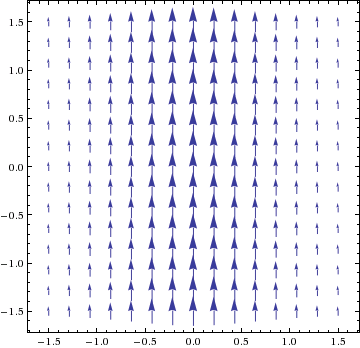
We compute: curl F(x,y) = ∂⁄∂x(1⁄(1+x2)) − ∂⁄∂y(0) = −2x⁄(1+x2)2 , and we verify that curl F(1, 0) = −½, and F(−1, 0) = ½. -
We will later show that all the following are equivalent:
- F = ∇f is conservative, the gradient of a potential function.
- F is path independent: the line integral between any two points (a1,b1) and (a2,b2) does not depend on the path chosen, ∮ F(c1)•dc1 = ∮ F(c2)•dc2 for any c1, c2 from (a1,b1) to (a2,b1).
- F has zero circulation: around any closed curve c, a loop with c(0) = c(1), the line integral ∮ F(c)•dc = 0.
- F is irrotational: curl F = 0 at all (x,y).
HW: Start WHW 4 due 2/10 below.- For each of the following vector fields F:
- Sketch F, and visually estimate curl F, the rate of rotation at each point: this is how strongly a little paddlewheel would be turned counterclockwise around the point (x,y) in the flow given by F.
- For F(x,y) = (p(x,y), q(x,y)), compute curl F = ∂q⁄∂x − ∂p⁄∂y, and compare to your estimate.
- If curl F = 0 everywhere, meaning F is irrotational, find the potential function f(x,y) = ∮ F(c) • dc for c from (0,0) to (x,y), and check ∇f = F, showing that F is conservative.
- F(x,y) = (0, x)
- F(x,y) = (x, 0)
- The vortex field F(x,y) = (−y, x). Imagine sitting on a turntable, with your velocity given by F. To keep from getting dizzy, you turn your head toward a fixed point on the horizon. The curl is your head's rate of rotation.
- Any radial field of the form F(x,y) = g(r) (x,y), where g(r) is any scalar function of the radius r = √(x2 + y2). For example g(r) = 1⁄r2 gives radial vectors of length inversely proportional to the distance from the center: F(x,y) = 1⁄(x2+y2) (x,y) = (x⁄(x2+y2) , y⁄(x2+y2)).
- Consider the rotational vector field with length
inversely proportional to the distance from the center:
F(x,y) = 1⁄(x2+y2) (−y, x) = (−y⁄(x2+y2) , x⁄(x2+y2)). - Verify that the length |F(x,y)| = 1/r. Sketch the vector field F, noting that it is undefined at the origin, and guess curl F.
- Show that curl F = 0 everywhere except at the origin. This means the rotation is all "concentrated in the center".
- Compute a potential function f(x,y) defined away from the negative x-axis, i.e. for any (x,y) with y ≠ 0 or x > 0.
Staying away from the singular point (0,0),
take a line integral along the radial line segment from (1,0) to (r,0),
then a circlar arc (r cos(t), r sin(t)) from (0,r) to (a,b),
where r = √(a2 + b2)
and t goes from 0 to arctan(b/a).
Note: The graph z = f(x,y) is a "spiral staircase" whose height equals the angle of (x,y) from the positive x-axis: z = θ. Can we define f(x,y) with ∇f = F for all (x,y) ≠ (0,0)?
1a. F(x,y) = (0, x)

A small paddlewheel placed at any point is pushed vertically on one side more than on the other, giving a counterclockwise rotational force, which means curl F > 0.
In fact, curl F = ∂⁄∂x(x) − ∂⁄∂y(0) = 1 − 0 = 1. Since the curl is non-zero, the field is not conservative, and cannot have a potential function f.1b. F(x,y) = (x, 0).
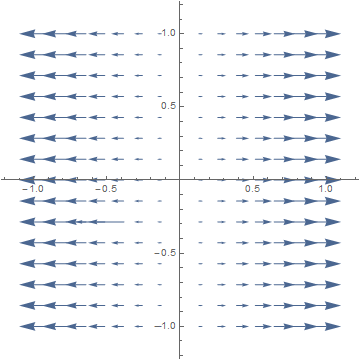
The equal flows on the top and bottom of a paddlewheel cancel each other, so we should have curl F = 0.
In fact, curl F = ∂⁄∂x(0) − ∂⁄∂y(x) = 0 − 0 = 0. The line integral along c(t) = (at, bt) is: f(a,b) = ∫01 F(at, bt) • (at, bt)' dt = ∫01 (at, 0) • (a, b) dt = ½a2. The potential function is thus f(x,y) = ½x2.1c. F(x,y) = (−y, x).
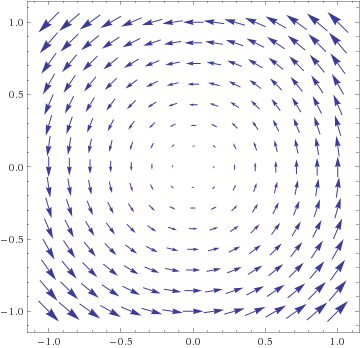
A paddlewheel is pushed harder on the side away from the origin than on the side facing the origin, giving a counterclockwise rotation, curl F > 0.
Using the other physical model, a person sitting anywhere on a turntable must turn his head at a constant rate to counter the table's rotation, so we expect curl F is constant.
In fact, curl F = ∂⁄∂x(x) − ∂⁄∂y(−y) = 1 − (−1) = 2. There is no potential function.1d. F(x,y) = 1⁄r2 (x,y).
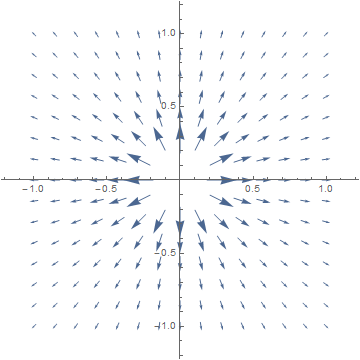
We compute: r = √(x2+y2), ∂r⁄∂x = x⁄√(x2+y2), and similarly for ∂r⁄∂y, so the Chain Rule gives:curl F = ∂⁄∂x [g(r) y] − ∂⁄∂y [g(r) x]
= g'(r) x⁄√(x2+y2) y − g'(r) y⁄√(x2 +y2) x = 0.The potential function is f(x,y) = r G(r), where G(c) = ∫c0 g(r) dr.
2a. The magnitude of F(x,y) = 1⁄r2 (−y, x) is |F(x,y)| = 1⁄r2 |(−y, x)| = 1⁄r2 r = 1⁄r .
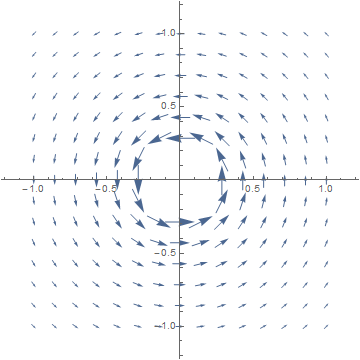
On the side away from the center, a paddlewheel is pushed counterclockwise by the flow; on the side facing the center, it is pushed clockwise along a shorter arc by a stronger flow. The two forces balance, and we should have curl F = 0.
2b. For F(x,y) = (−y⁄x2+y2 , x⁄x2+y2), we use the Quotient Rule to get:
curl F = ∂⁄∂x(x⁄x2+y2) − ∂⁄∂y(−y⁄x2+y2)
= (x2 + y2 − x(2x))⁄(x2+y2)2 − (−x2 − y2 − (−y)(2y))⁄(x2+y2)2 = 0That is, F has no rotation at any point where it is defined, though it has some singular behavior at the origin.
2c. To compute the potential function f(a,b), we take the line integral along a two-segment path: we define the constant s = √(a2+b2), and take the line segment c1(t) = (t + (1−t)s, 0) from (1,0) to (r,0); then the circular arc c2(t) = (s cos(t), s sin(t)) from (r,0) to (a,b), where t goes from 0 to θ = arctan(b/a), which is the angle from the x-axis to the radial vector (a,b). The potential function is given by:
f(a,b) = ∮ F(c1) dc1 + ∮ F(c2) dc2
= ∫01 F(st, 0) • (st,0)' dt + ∫0θ F(s cos(t), s sin(t)) • (s cos(t), s sin(t))' dt
= ∫01 1⁄r2(0, st) • (s,0) dt + ∫0θ 1⁄s2(−s sin(t), s cos(t)) • (−s sin(t), s cos(t)) dt
= 0 + ∫0θ s2⁄s2 (sin2(t) + cos2(t)) dt = θ = arctan(b/a).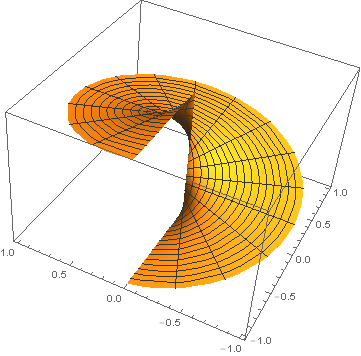
In the graph z = f(x,y), the ray at angle θ from the x-axis is at height θ, for −π ≤ θ ≤ π. This leads to a discontinuity on the negative x-axis, where the angle can be either π or −π. Thus, we cannot define the potential function all the way around the origin, which reflects the fact that F does have a rotation around that point, though nowhere else.
- 2/9 Recitation 5: Proof that curl equals rate of circulation (WHW 4).
- 2/10 Lect 14. ⊞ Double integral ∬D f(x,y) dx dy
⊞ Soln- Arclength of c(t) = (x(t),y(t))
for a ≤ t ≤ b:
L = limn→∞ ∑ i=0 n−1 |Δci| = limn→∞ ∑ i=0 n−1 |Δc'(ti)| Δti Length is integral of speed (abs value of velocity).
= ∫ab |c'(t)| dt = ∫ab √(x'(t)2+y'(t)2) dt . - Double integral is volume below graph z = f(x,y),
above planar domain D.
For rectangle domain:D = [a,b]×[c,d] = {(x,y) with a ≤ x ≤ b , c ≤ y ≤ d}, take sample points in x-interval and y-interval:a = x0 < x1 < ... < xn = b Sum up volumes of "french fries" above n×n tiny rectangles at (xi,yj):
c = y0 < y1 < ... < yn = d.
volume is: height f(xi,yj), times base area Δxi Δyj.∬D f(x,y) dx dy = limn→∞ ∑ i,j=0 n−1 f(xi,yj) Δxi Δyj . We can equally well write dy dx instead of dx dy. - Cavalieri Principle: To compute volume, integrate areas of all slices perpendicular to an axis.
Fubini Theorem: To compute double integral ∬D f(x,y) dx dy,- Evaluate area of each slice perpendiuclar to y-axis: the inside integral A(y) = ∫ab f(x,y) dx with respect to x-variable, considering y as constant.
- Integrate ∫cd A(y) dy along y-axis.
- Can also switch to dy dx, do y-integral first.
-
Example: Rectangular region D = [0,1]×[2,3] with 0 ≤ x ≤ 1 and 2 ≤ y ≤ 3,
function f(x,y) = xy2, we have:
∬D xy2 dx dy = ∫32 (∫10 xy2 dx) dy
= ∫32 [1⁄2x2y2]x=0 x=1 dy = ∫32 1⁄2y2 dy = 19⁄6 .∬D xy2 dy dx = ∫10 (∫32 xy2 dy) dx
= ∫10 [1⁄3xy3]y=2 y=3 dy = ∫10 1⁄3(27x − 8x) dx = 19⁄6 .
HW:- Arclength
- Find the arclength of the graph y = x2 for 0 ≤ x ≤ 1. Hint: Recall the integral formula ∫√(a2+x2) dx = x⁄2√(a2+x2) + a2⁄2 log(x+√(a2+x2)) + C.
- Using our formula for parametrized curves, derive the formula for arclength of a graph y = f(x) over a ≤ x ≤ b.
- Recall the cycloid curve c(t) = (t−sin(t), 1-cos(t)), the path of a point on the rim of a rolling wheel. Find the length of one arch of the curve, from t = 0 to t = 2π. Hint: Use a trig half-angle formula to evaluate the integral.
- A bunch of double integrals, done both ways (dx dy and dy dx):
[MT] Ch 5.1 p 269, Ex #1,2,3,4. Ch 5.2 p 282, Ex #1. - Sketch the solid region whose volume is computed by
the given integral.
- ∬R x+y2 dx dy for R = [0,1]×[−1,1]
- ∬R 1+xy dx dy for R = [0,2]×[0,3]
1a. Parametrize the curve as c(t) = (t,t2) for 0 ≤ t ≤ 1, giving length L = ∫10 √(12 + (2t)2) dt = 1⁄2√5 + 1⁄4log(2+√5). Even quite simple curves give difficult arclength integrals, which can usually only be evaluated numerically.
1b. Parametrize as c(t) = (t, f(t)) for a ≤ t ≤ b, with c'(t) = (1, f '(t)), and length L = ∫ba √(1+f '(t)2) dt.
1c. See [MT] Ch 4.2 Example 2, p 229.
2. See [MT] answers, p 517, or evaluate (indefinite or definite) double integrals using Wolfram. Note that doing an integral as dx dy or as dy dx should give the same answer.
3a. The solid is under the graph z = x+y2 and above the rectangle (x,y) ∈ [0,1]×[−1,1]. To visualize the graph, consider the slice above the x-axis (y=0), which is just the line z = x; and the slices perpendicular to the x-axis, above x = c, which are parabolas z = c+y2 rising from the backbone above the x-axis. See the graph in Wolfram.
3b. The graph is a saddle surface, with upward parabola above y = x, downward parabola above y = −x, and two flat lines above the x and y axes.
- 2/13 Lect 15. ⊞ Computing double integrals.
- Definition of ∬D f(x,y) dx dy for general domain D:
In Riemann sum, add only the sample points (xi,yj) ∈ D - Simple domains: generalize (x,y) ∈ D = [a,b] × [c,d]
x-simple D = {(x,y) | a ≤ x ≤ b , c(x) ≤ y ≤ d(x)}
y-simple D = {(x,y) | c ≤ y ≤ d , a(y) ≤ x ≤ b(y)} - Ex: D triangle bounded by y = x , y = 1−x , y = 0.
∬D x2+y2 dy dx
= ∫ x=0 x=1/2 ∫ y=0 y=x x2+y2 dy dx + ∫ x=1/2 x=1 ∫ y=0 y=1−x x2+y2 dy dx
∬D x2+y2 dx dy = ∫ y=0 y=1/2 ∫ x=y x=1−y x2+y2 dx dy
- Ex: D bounded between y = 2x2 and y = x2−2x+3
- Technique: Reversing the order of integration
∫ x=a x=b ∫ y=c(x) y=d(x) f(x,y) dy dx ⇒ sketch x-simple D
⇒ convert to y-simple D: y-shadow c ≤ y ≤ d
for given y, find x-floor and ceiling a(y) ≤ x ≤ b(y)
⇒ ∫ y=c y=d ∫ x=a(y) x=b(y) f(x,y) dx dy - Applications: total mass, center of gravity, of mass.
- More general: parametrized domain F : D* → D,
F(u,v) = (x,y)
Ex: Polar parametrization P(r,θ) = (r cos(θ), r sin(θ))
Find how F(u,v) stretches sample box areas Δu Δv by a factor stretch(u,v)
∬D f(x,y) dx dy = ∬D* f(F(u,v)) stretch(u,v) du dv
Analogous to 1-variable substitution: x = g(u), dx = g'(u) du = dx⁄du du
∫ f(x) dx = ∫ f(g(u)) g'(u) du
5.4 Changing the order of integration
HW: [MT] p. 288 and 293 odd exercises (answers p 518).- 2/15 Lect 16. ⊞ Det[L] = area; param region F(D*) = D; substitution
⊞ Soln- Area stretching factor for linear L(u,v) is determinant
Defined by L(1,0) = u = (a,b) , L(0,1) = v = (c,d).
Stretching factor is area of parallelogram D with edges u,v
Area = base×height = |u| |v| sin θ(u,v)
= |u⊥| |v| cos θ(u⊥,v) = u⊥•v = −bc+ad = ad−bc for u⊥ = (−b,a)
Positive area if v counterclockwise from u, negative area if clockwise= det[L] = det(u,v) = det a c b d = ad − bc
Properties of det(u,v): bilinear, alternating det(u,v) = −det(v,u) ⇒ formula - Substitution Rule for 1-variable integrals: x = g(u)
Local stretching factor: dx = g'(u) du = dx⁄du du
∫ f(x) dx = ∫ f(g(u)) g'(u) du - Substitution Rule for G(u,v) = (x,y),
one-to-one & onto G : D* → D
Local stretching factor is det of Jacobian matrix of derivatives∬D f(x,y) dx dy for = ∬D* f(x(u,v),y(u,v)) |det[DG(u,v)]| du dv. Leibnitz notation: |det[DG(u,v)]| = |∂(x,y)⁄∂(u,v)| - Ex: Polar P(r,θ) = (x,y) to parametrize roundish regions
Jacobian determinant:
= r cos2(θ) + r sin2(θ) = rdet[DP(r,θ)] = det ∇x(r,θ) ∇y(r,θ) = det cos(θ) −r sin(θ) sin(θ) r cos(θ)
for (x,y) ∈ D = disk of radius 1, parametrized by (r,θ) ∈ D* = [0,1]×[0,2π].∬D x2+y2 dx dy = ∬D* ( (r cos(θ))2 + (r sin(θ))2 ) |det[DP(r,θ)]| dr dθ Note: This is exactly half the volume of the enclosing cylinder under z = 1.
= ∫2π0 ∫10 r2 r dr dθ = ∫2π0 1⁄4 dθ = 1⁄4 2π = π⁄2 .
Review parametric regions in HW 1/25, HW 1/27
HW: Start WHW 5 due 2/17 below.- Use an appropriate parametrization to find formulas for
the following quantities:
- The volume under an arbitrary surface of revolution z = f(r) = f(√(x2+y2)) and above a ring-shaped region with a ≤ r ≤ b. You probably saw the resulting formula in Calculus II: what was it called?
- The integral of an arbitrary f(x,y) over the elliptical region D defined by (x−1)2 + y2⁄4 ≤ 1
- The integral of f(x,y) over the triangle with vertices a = (1,1), b = (3,2), c = (2,4).
- Vector geometry of the determinant
- Consider vectors u = (a,b), v = (c,d), forming an angle from u to v given by α with −π ≤ α ≤ π (positive meaning counterclockwise). Let β be the angle from v to u⊥, the 90° counterclockwise rotation of u.
- Let D be parallelogram with vertices 0, u, v, u+v.
- Let area(u,v) be the area of D, counted positively if α ≥ 0, and negatively if α ≤ 0.
- The following properties of the area function are easy to see geometrically:
- Bilinear:
area(au1+bu2, v) =
a area(u1,v) + b area(u2,v)
area(u, cv1+dv2) = c area(u,v1) + d area(u,v2) - Skew-symmetric: area(u,v) = −area(v,u)
- Unit square: area(i,j) = 1, where i = (1,0) and j = (0,1)
- Bilinear:
area(au1+bu2, v) =
a area(u1,v) + b area(u2,v)
1. Use the polar parametrization P(r,θ), having Jacobian determinant det[DP] = r, and which maps the parameter region D* = [a,b]×[0,2π] to the ring-region D = {(x,y) | a2 ≤ x2+y2 ≤ b2}. The volume is:
Vol = ∬D f(√(x2+y2)) dx dy = ∫ab ∫02π f(r) r dθ dr = ∫ab 2πr f(r) dr. This is the familiar "Shell Method Formula" for solids of revolution, usually justified by adding up thin cylindrical shells having perimeter 2πr, height f(r), and thickness dr.1b. The region D is an ellipse with center (1,0), height 1, and width 2, so it is parametrized by a shift and scaling of polar coordinates: E(u,v) = (x,y) = (1 + u cos(v), 2u sin(v)), over the parameter region D* = [0,1]×[0,2π]. This has Jacobian determinant:
= 2u cos2(v) + 2u sin2(v) = 2udet[DE(u,v)] = det ∇x(u,v) ∇y(u,v) = det cos(v) −u sin(v) 2sin(v) 2u cos(v) ∬D f(x,y) dx dy = ∫01 ∫02π f(1 + u cos(v), 2u sin(v)) 2u dv du. 1c. The given triangle D is half of a parallelogram with edge-vectors u = b−a = (2,1) and v = c−a = (1,3). We parametrize D by the affine linear mapping A(u,v) = a + L(u,v) with L(i) = u, L(j) = v, so that A(u,v) = (1+2u+v, 1+u+3v), over the triangular parameter region D* = {(u,v) | u,v ≥ 0, u+v ≤ 1}. The Jacobian determinant is:det[DA(u,v)] = det[L] = det 2 1 1 3 = (2)(3)−(1)(1) = 5. ∬D f(x,y) dx dy = ∫01 ∫01−v f(1+2u+v, 1+u+3v) 5 du dv. 2. We have the vectors u = (a,b), v = (c,d), the projection p of v on u, and the projection q of v on u⊥.
base×height = |u| |q| = |u⊥| |v| cos(β) = u⊥•v = (−b,a)•(c,d) = ac−bd. - 2/16 Recitation 6: Evaluating double integrals, switching order of integration
- 2/17 Lect 17. ⊞ Curl Theorem (Green's Theorem for Circulation).
- Tradeoff in using substitution (x,y) = F(u,v):
simplify region (x,y) ∈ D ⇒ (u,v) ∈ D*
but complicate integrand f(x,y) ⇒ f(x(u,v),y(u,v)) - One-variable Second Fundamental Theorem
Start with f(b)−f(a), break into small intervals ⇒ ∫ab f '(x) dx - Curl Theorem:
Let c be the counterclockwise boundary curve
of a plane region D. Then: ∮ F(c) • dc = ∬D curl F(x,y) dx dy.
Proof: Start with circulation integral of F,
break up into sum of circulations around sample grid boxes,
rate of circulation around each box approaches curl F - Example: Constant curl vector fields:
F(x,y) = (−y,0), (0,x), (−y,x)
Circulation around a loop equals (mult of) area enclosed - Discuss WHW 5, Main Thm on Conservative Fields
The Midterm Exam will be next Fri 2/24 in class.- 2/20 Lect 18. ⊞ Midterm Review: Derivatives and Integrals.
⊞ Soln- Gaussian integral ∫∞−∞ e−x2 dx = √π
- Consider the region R bounded by the x and y axes and the line x + 2y = 2,
and the vector field F(x,y) = (0,x2).
Verify the Curl Theorem for the double integral
∬D curl F dx dy.
- State the Theorem, both in words and integral formulas.
- Make a sketch of the vector field and the region, and visually estimate the total circulation around the boundary curve, and (independently) the total curl inside the region: the Theorem says these should be the same.
- Compute the double integral of the rate of rotation over the region in the form ∬D curl F dy dx, writing the region in x-simple form as D = {(x,y) s.t. a ≤ x ≤ b and c(x) ≤ y ≤ d(x)}.
- Repeat part (c) in the form ∬D curl F dx dy, reversing the order of the dx and dy integration by writing the region in the form D = {(x,y) s.t. c ≤ y ≤ d and a(y) ≤ x ≤ b(y)}. You should get the same answer as before.
- Compute the total circulation of F around the (counterclockwise) boundary of D. You should split this into three parametrized lines, the sides of the triangle. The Theorem says this should come out the same as part (c) and (d).
- Product Rules
- Given two functions f(x,y), g(x,y),
and their product function p(x,y) = f(x,y) g(x,y),
state and prove the Product Rule for ∇p = ∇(fg) from HW 1/30.
Hint: Prove the Rule by writing out the coordinates of the gradient and applying the one-variable Product Rule. - Given two curves b(t) and c(t) and
and their dot product p(t) = b(t)•c(t),
find and prove a Product Rule for p'(t) = d⁄dt(b(t)•c(t)).
Hint: To discover the Rule, multiply the linear approximations to b(a+h) and c(a+h), and find the "slope coefficient" of h in the resulting approximation of p(a+h). Prove the Rule by applying the one-variable Product Rule to each coordinate. - Show that if c(t) moves along the circle of radius r, meaning |c(t)| = r for all t, then the tangent vector of c is always perpendicular to the radius vector c(t) at time t. Hint: Use (b).
- Given two functions f(x,y), g(x,y),
and their product function p(x,y) = f(x,y) g(x,y),
state and prove the Product Rule for ∇p = ∇(fg) from HW 1/30.
1a. Curl Theorem: The total circulation of the vector field F around the counterclockwise curve c is equal to the integral of the rate of rotation of F over the enclosed region D:
∮ F(c) • dc = ∬D curl F dx dy . 1b. F(x,y) = (0, x2):

The line integral is zero on the horizontal and vertical sides of the triangle; only on the diagonal is there a non-zero dot product of the field with the tangent vector, with a value about 1⁄2 at the middle and a maximum of about 1 at the right end. Thus, we may guess a total circulation about 1.
To estimate the curl integral, note that for positive x, a paddlewheel would be pushed more strongly counterclockwise by the flow to its right than clockwise by the weaker flow to its left. Thus, curl F is clearly positive, and increases from zero for x = 0 to largish at x = 2; the right half of triangle has area 1⁄2, so the above guess of 1 is reasonable for the double integral of curl F over the triangle.1c. curl F(x,y) = 2x, and D = {(x,y) s.t. 0 ≤ x ≤ 2 , 0 ≤ y ≤ 1−½x}. The double integral is:
∬D curl F dy dx = ∫02 ∫01−½x 2x dy dx = ∫02 2xy |y=01−½x dx = ∫02 2x(1−½x) dx = 4⁄3 , in line with our guess.
1d. We have D = {(x,y) s.t. 0 ≤ y ≤ 1 , 0 ≤ x ≤ 2−2y}, and:
∬D curl F dx dy = ∫01 ∫02−2y 2x dx dy = ∫01 x2 |x=02−2y dy = ∫01 (2−2y)2 dy = 4⁄3 . Any double integral can be done either way (dy dx or dx dy), whichever is more convenient.
1e. The boundary c has three segments: c1(t) = (2t,0) ; c2(t) = (2,0) + [(0,1)−(2,0)]t = (2−2t, t) ; c3(t) = (0, 1−t), where all the parameter ranges are 0 ≤ t ≤ 1. The total circulation is:
∮ F(c) dc = ∮ F(c1) dc1 + ∮ F(c2) dc2 + ∮ F(c3) dc3
= ∫01 F(2t,0) • (2,0) dt + ∫01 F(2−2t, t) • (−2, 1) dt + ∫01 F(0, 1−t) • (0, −1) dt
= ∫01 0 dt + ∫01 (2−2t)2 dt + ∫01 0 dt = 4⁄3 .Behold the Curl Theorem!
2a. The first coordinate is ∂⁄∂x(fg) = ∂f⁄∂x g + f ∂g⁄∂x. Here we may use the one-variable Product Rule since taking the partial derivative ∂⁄∂x is defined as taking the ordinary derivative d⁄dx, while holding y constant. Similarly for the other coordinate. Thus we get the x- and y-coordinates on the left and right sides of the gradient Product Formula.
2b. p(a+h) = b(a+h) • c(a+h) ≈ (b(a) + b'(a)h) • (c(a) + c'(a)h) = b(a)•c(a) + b'(a)•c(a) h + b(a)•c'(a) h + b'(a)•c'(a) h2. The final h2 term is irrelevant for a linear approximation. The coefficient of h gives the derivative p'(a) = b'(a)•c(a) + b(a)•c'(a)
2c. Take the derivative of both sides of c(t)•c(t) = r, obtaining 2 c(t)•c'(t) = 0, meaning the radius vector c(t) and the tangent vector c'(t) are perpendicular (orthogonal).
- 2/22 Lect 19. ⊞ Midterm Review: Chain Rule, parametrizations, substitution.
Here is the original Quiz 18, covering the Chain Rule (Solution).⊞ Soln
HW: The Midterm Exam will be this Fri 2/24 in class.- Use an appropriate substitution to
evaluate the integral:
∬D exp (y−x)⁄(y+x) dx dy, over the triangular region D with vertices (0,0), (1,0), (0,1).- Try to substitute new variables u,v for relatively complicated expressions in the integrand, i.e. u = y−x , v = y+x. This defines a function G(x,y) = (u,v); compute the inverse function F(u,v) = (x,y), by solving for x,y in terms of u,v.
- G(x,y) is a linear function: find its matrix,
and its inverse matrix, which is the matrix of F(u,v).
Recall that, for det = ad − bc,
a c b d −1 = 1⁄det d −c −b a . - Since G(x,y) is a linear function, it takes the triangle D in the xy-plane to a triangular parameter region D* in the uv-plane. Determine the vertices of this triangle, and write it in v-simple form.
- Apply the Substitution Formula to evaluate the integral.
- Model an oval platter by the elliptical region:
D = {(x,y) | x2 + 4y2 ≤ 1600}, with x,y measured in cm. Suppose the platter is thicker around the rim, and its density (in g/cm2) is given by:f(x,y) = 1⁄400(x2 + 4y2). - Sketch the region, and make a rough estimate of the mass = area × average density.
- Find a parametrization F : D* → D with a simple parameter region D*. Hint: How does D compare to a unit disk?
- Compute the mass of the plate as the double integral ∬D f(x,y) dx dy, using the substitution in (b).
1a. Solving u = y−x , v = y+x, we get x = −1⁄2u+1⁄2v , y = 1⁄2u+1⁄2v . That is, the inverse of (u,v) = G(x,y) = (y−x, y+x) is:
(x,y) = F(u,v) = (−1⁄2u+1⁄2v , 1⁄2u+1⁄2v). 1b. The columns of the matrix of G(x,y) are G(1,0), G(0,1), having determinant −2. The matrix of F(x,y) can be obtained from the formula above, or from the inverse-matrix formula:[G] = −1 1 1 1 [F] = −1⁄2 1⁄2 1⁄2 1⁄2 . 1c. The parameter domain D* is a triangle with vertices G(0,0) = (0,0), G(1,0) = (−1, 1), G(0,1) = (1,1). This is v-simple:
D* = {(u,v) | 0 ≤ v ≤ 1 , −u ≤ v ≤ u}. 1d. The integral simplifies very nicely upon substitution:∬D exp (y−x)⁄(y+x) dx dy = ∬D* eu/v |det[DF(u,v)]| du dv Note that the stretching factor is the absolute value of the determinant det[DF(u,v)] = det[F] = −1⁄2 .
= ∫1v=0 ∫ u=−v v eu/v 1⁄2 du dv = 1⁄2 ∫1v=0 [v eu/v]u=−vu=v du dv
= 1⁄2 ∫1v=0 v (e−e−1) dv = (e−e−1)⁄4 .
In this case, the integrand function became simpler upon substition, and the region D became the mildly more complicated D*. Finally, a fortunate cancellation enabled an explicit solution, which is quite rare.2a. The area of the region is about 3⁄4 the area of the 80×40 rectangle, with an average density of about 3, since the minimum density is near 0 in a small region near the center and about 4 on a large region near the rim. Estimated mass: about 7000g.
2b. The region is an ellipse centered on the orgin, with horzontal radius (semi-major axis) 40cm and vertical radius (semi-minor axis) 20cm. Use the elliptical coordinates F(u,v) = (40u cos(v), 20u sin(v)), with parameter region (u,v) ∈ D* = [0,1] × [0,2π], with stetching factor det[DF(u,v)] = 800u.
2c. Note that f(x(u,v), y(u,v)) = 4u2, so the substitution formula gives: ∬D f(x,y) dx dy = ∫02π∫01 4u2 800u du dv = 1600π ≈ 5027. Pretty close to our estimate.
- 2/23 Recitation 7: ⊞ Midterm Review.
⊞ Soln- Find the absolute maximum and minimum of the function
f(x,y) = x3−3x−y2 = max/min over the disk D = {(x,y) | x2+y2 ≤ 4}.
- View the graph z = f(x,y) to get a rough idea of the max and min points. Hint: Plot using polar coordinates: 3D parametric plot (r cosθ, r sinθ, f(r cosθ, r sinθ)) for (r,θ) ∈ [0,2]×[0,2π].
- View the contour map of level curves f(x,y) = c, and again estimate the max and min points. How to see local max/min in the interior and on the boundary in this picture?
- View the gradient vector field ∇f(x,y), and again estimate max/min points. How to see them in this picture?
- Find the interior critical points by solving ∇f(x,y) = (0,0). Classify the critical points using the pictures.
- Find (or at least estimate) the critical points on the boundary by graphing the function g(t) = f(c(t)), where c(t) parametrizes the boundary circle. (Graph.)
- Write matrices for orthogonal reflection Refla taking a to −a, where |a| = 1; and rotation Rotθ. Show that any composition of reflections is a rotation; a reflection following a rotation is a reflection.
1a. From the graph, we see that the maximum of f(x,y) is attained either at the local maximum point near (x,y) = (−1,0) or on the boundary at (2,0), and there are two minimum points on the boundary near (1, ±√3). There is also a saddle point near (1,0).1b. Imagine trimming the contour plot down to the radius 2 boundary disk. Then we again see the local maximum point at (−1,0), and the boundary maximum at (2,0). We again see the boundary minimum points near (1,±√3), where the boundary circle cuts deepest into the dark-colored regions, and there also seems to be a local boundary minimum at (−2,0). The critical points on the boundary are precisely where the boundary curve is tangent to a level curve.
1c. Plotting the gradient vector field, we again see the local maximum with arrows pointing toward it.
Imagining the boundary circle c(t) of radius 2, the critical points are where the gradient ∇f(c(t)) is perpendicular to the direction of c(t). Proof: By the Chain Rule, the critical points of g(t) = f(c(t)) are where 0 = g'(t) = ∇(t) • c'(t).
Now we see that the boundary minumum points on the boundary are a bit to the left of x = 1.2. The orthogonal decomposition of v into p parallel to a and q orthogonal to a is given by p = (v•a)⁄(a•a) a and q = v − p. The reflection along a is thus the linear mapping L(v) = L(p+q) = −p + q = v − 2(v•a)⁄(a•a) a.
Taking a = (a,b) with |a|2 = a2 + b2 = 1, the matrix of L consists of column vectors L(i) = (1−2a2, −2ab) = (b2−a2, −2ab), and L(j) = (−2ab, 1−2b2) = (−2ab, a2−b2), giving the reflection matrix:
where c = b2−a2 and d = −2ab, with c2+d2 = (a2+b2)2 = 1.b2−a2 −2ab −2ab a2−b2 = c d d −c ,
We also have the rotation matrix:a −b b a
To take compositions of these mappings, we multiply their matrices. Inspecting the result shows that multiplying two different reflection matrices gives a rotation matrix, and multiplying a reflection times a rotation gives a new reflection. (Also, multiplying two rotations gives a rotation.) These formulas are all intimately related to the angle addition formulas for sin and cos.- 2/27−3/1 Lect 20−21. ⊞ Flux ∮F•dn & div F, Divergence Thm.
⊞ HW- Flux integral. The flux of a vector field F across a curve c is the net flow of F from the left to the right side of c, facing forward along the curve.
-
By this we mean that c(t) = (x(t), y(t))
has velocity vector c'(t) = (x'(t), y'(t)),
whose counterclockwise orthogonal
c'(t)⊥ = (−y'(t), x'(t))
points to the left side of c; and
the right-side orthogonal n(t) = −c'(t)⊥
= (y'(t), −x'(t)) is called the normal vector.
To see how strongly the field F is flowing across the curve c at a given point, we take the the dot product of F(c(t)) • n(t) The flux is the line integral of this quantity:Flux = ∮ F(c) • dn = ∮ F(c) • (−dc⊥) = ∫10 F(c(t)) • (−c'(t)⊥) dt. As with the circulation integral, we can also define flux (and compute it numerically) as a Rienmann sum:
∮ F(c) • dn = limn→∞ ∑ i=0 n−1 F(ci) • (−Δci⊥), where we take sample points c0,...,cn on the curve c, and Δci = ci+1−ci ≈ c'(ti) Δti . - Divergence: For a vector field F on the xy-plane,
we define its divergence as the rate
of outflow of F from a small region near (x,y) = (a,b),
relative to the area of the region:
div F(a,b) = limΔx,Δy → 0 ( ∮ F(cΔxΔy) • dn ) / ΔxΔy , where cΔxΔy(t) is the curve which traces counterclockwise around a rectangle from (a,b) to (a+Δx, b) to (a+Δx, b+Δy) to (a, b+Δy) and back to (a,b), and dn(t) = −dcΔxΔy(t)⊥ is the outward normal vector of the rectangle.
The above limit can be computed to give a formula in terms of the partial derivatives of the components of F(x,y) = (p(x,y), q(x,y)):div F(x,y) = ∂p⁄∂x + ∂q⁄∂y . If div F(x,y) = 0 everywhere, we say F is incompressible, modeling velocity of a fluid in which there is no net outflow from any region. - Example: The field F(x,y) = (1⁄(1+x2), 0)
could represent the velocity of the Red Cedar River flowing over
the dam (the y-axis): the river gets faster where it is shallower.
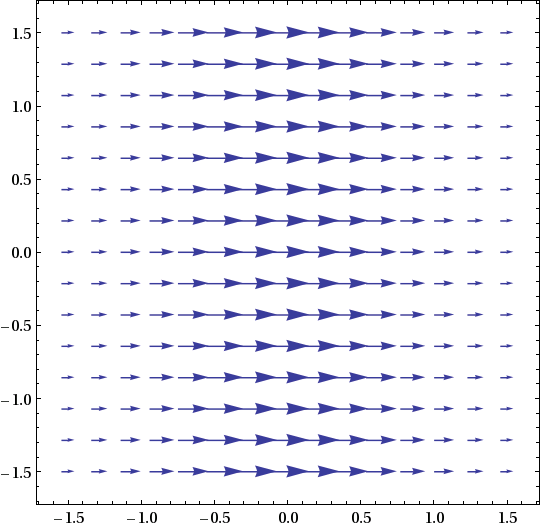
We compute: div F(x,y) = ∂⁄∂x(1⁄(1+x2)) − ∂⁄∂x(0) = −2x⁄(1+x2)2 , and we verify that div F(−1, 0) = ½. Similarly, F(1, 0) = −½. - Divergence Theorem (Green's Theorem for Flux):
For a vector field F,
the double integral of the rate of outflow of F over a region R
is equal to the total outflow of F across the boundary of R:
∬R div F dA = ∮ F(c) • dn . Here the closed curve c must not cross itself, and it must go counterclockwise enclosing R, a region with no holes or points where div F is undefined.
The intuitive explanation is that the flux line integral on the right side can be split over a grid of subregions whose flux integrals cancel each other along their common boundaries, except along the outside boundary of R. As the grid gets finer and finer, each small line integral near (x,y) is approximated by div F(x,y) dA, and their sum approaches the double integral on the left side. - Example: Consider the previous F(x,y) = (1⁄(1+x2), 0) over the
triangle region D, defined y-simply by 0 ≤ y ≤ 1 , 0 ≤ x ≤ 1−y.
The double integral of the rate of outflow (the divergence of F) over the region is:
∬D div F dx dy = ∫01 ∫0 1−y −2x⁄(1+x2)2 dx dy = ∫10 [1⁄1+x2 |1−y x=0 dy = ∫10 1⁄1+(1−y)2 − 1 dy = π⁄4 − 1.
The boundary of R consists of the line segments c1(t) = (t,0), c2(t) = (1−t,t), c3(t) = (0,1−t), each for 0 ≤ t ≤ 1; and the total flux is the line integral:
∮ F(c) • dn = ∮ F(c1) • dn1 + ∮ F(c2) • dn2 + ∮ F(c3) • dn3
= 0 + π⁄4 − 1 .In detail, one of these is:
∮ F(c2) • dn2 = ∫10 F(1−t, t) • (−(1−t, t)')⊥ dt Notice that n = (1,1) is the outward normal from the upper edge of the triangle.
= ∫10 (1⁄(1+t2), 0) • (−(−1,1)⊥) dt = ∫10 (1⁄(1+t2), 0) • (1,1) dt = π⁄4 .
HW:⊞ Soln- Picturing divergence (compare Lect 13 #1). For each of the following vector fields F:
- Sketch F, and visually estimate div F, the rate of outflow at each point (x,y).
- For F(x,y) = (p(x,y), q(x,y)), compute div F = ∂p⁄∂x + ∂q⁄∂y, and compare to your estimate.
- F(x,y) = (0, x)
- F(x,y) = (x, 0)
- The radial field F(x,y) = (x,y).
- A rotational field F(x,y) = g(r) (−y, x), where g(r) is any scalar function of the radius r = √(x2 + y2). For example g(r) = r−2, giving F(x,y) = (−y⁄(x2+y2) , x⁄(x2+y2)).
- Consider the radial vector field with length
inversely proportional to the distance from the center:
F(x,y) = 1⁄(x2+y2) (x,y) = (x⁄(x2+y2) , y⁄(x2+y2)). - Verify that the length |F(x,y)| = 1/r. Sketch the vector field F, noting that it is undefined at the origin, and guess div F.
- Show that div F = 0 everywhere except at the origin, meaning F is incompressible. This means the divergence is all "concentrated in the center".
- Compute the flux integral (total outflow) ∮c F • dn across the boundary curve c of the polar-box region D defined by 0 ≤ r ≤ 1, 0 ≤ θ ≤ π⁄2. Verify that it is indeed zero: by the Divergence Theorem, the flux integral must equal the double integral of the rate of flux ∬D div F • dx dy, but div F = 0.
1a. F(x,y) = (0,x)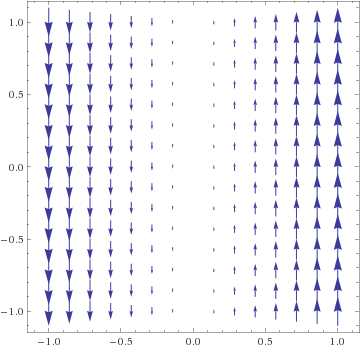
1b. F(x,y) = (x,0)
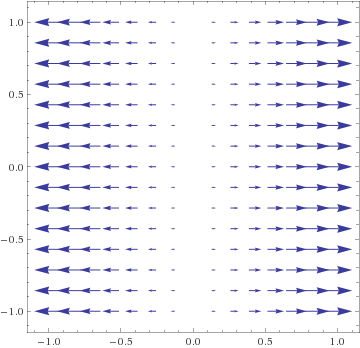
1c. F(x,y) = (x,y)
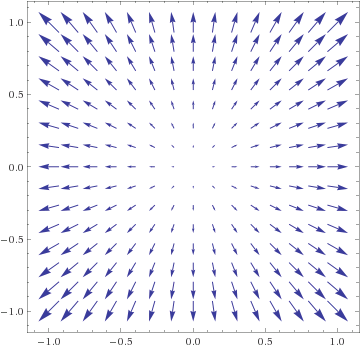
1d. F(x,y) = sin(x2+y2) (−y,x)
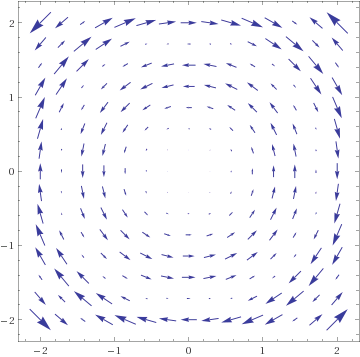
div F = ∂⁄∂x(g(x2+y2)(−y)) + ∂⁄∂y(g(x2+y2)x)
= g'(x2+y2)(2x)(−y) + g'(x2+y2)(2y)(−x) = 02a. F(x,y) = (x⁄(x2+y2) , y⁄(x2+y2)). A rough sketch, with the large vectors near the origin not show to scale:
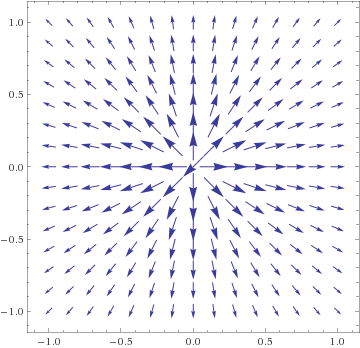
For any small radial box, the radial edges have zero flow; and the inner circular edge has a shorter arc with longer inflowing F vectors, while the outer circular edge as a longer arc with shorter outflowing F vectors. Thus we may guess div F ≈ 0 everywhere (except at the origin, where there is a positive outflow from zero area, an infinite rate of outflow).
2b. Compute for radial field F(x,y) = g(x2+y2) (x,y) = 1⁄(x2+y2) (x,y):
div F = ∂⁄∂x(g(x2+y2)x) + ∂⁄∂y(g(x2+y2)y) 2c. The radial box consists of curves:
= g'(x2+y2)(2x2) + g(x2+y2) + g'(x2+y2)(2y2) + g(x2+y2)
= −2(x2+y2)⁄(x2+y2)2 + 2⁄(x2+y2) = 0.c1(t) = (t+1, 0) , c2(t) = (2 cos(π⁄4 t), 2 sin(π⁄4 t)), where all parameters run over 0 ≤ t ≤ 1. These have tangent vectors:
c3(t) = (0, 2−t) , c4(t) = (cos(π⁄4(1−t)), sin(π⁄4(1−t))),c'1(t) = (1,0) , c'2(t) = (−π⁄2 sin(π⁄4 t), π⁄2 cos(π⁄4 t)), Since n(t) = −c'(t)⊥, where −(x,y)⊥ = (y,−x), we have:
c'3(t) = (0,−1) , c'4(t) = (π⁄4 sin(π⁄4(1−t)) , −π⁄4 cos(π⁄4(1−t))).n1(t) = (0,−1) , n2(t) = (π⁄2 cos(π⁄4 t), π⁄2 sin(π⁄4 t)), The flux integral is a sum of four line-integrals over c1, c2, c3, c4, for example:
n3(t) = (−1,0) , n4(t) = (−π⁄4 cos(π⁄4(1−t)) , −π⁄4 sin(π⁄4(1−t))).∮ c2 F(c2(t)) • dn2 = ∫01 F(2 cos(π⁄4 t), 2 sin(π⁄4 t)) • (π⁄2 cos(π⁄4 t), π⁄2 sin(π⁄4 t)) dt Note this is positive because there is a net outflow across c2: that is, F(c2(t)) flows from left to right, facing along c'2(t). Similarly, the integral for c4 is −π⁄2 , and the other two integrals are both zero, since F is orthogonal to the normal.
= ∫01 (1⁄2 cos(π⁄4 t), 1⁄2 sin(π⁄4 t)) • (π⁄2 cos(π⁄4 t), π⁄2 sin(π⁄4 t)) dt = π⁄2 .- 3/2 Recitation 8: Complex multiplication on R2 ≅ C
- 3/3 Lect 22. Conjugate-analytic vect flds F(x,y) = f(x−iy) ⇒ curl, div = 0
- Extra 1: ADD ⊞ Center of mass
- Average values
- Center of gravity, center of mass
- Moment of inertia
- 3/13 Lect 23. ⊞ Vectors in Rn, R3. Determinants.
⊞ Soln- Vector x = (x1,...,xn) ∈ Rn
- Dot product
u•v =
(u1,...,un)•(v1,...,vn)
= u1v1 + ... + unvn
Geometrically: u•v = |u| |v| cos θuv - Linear subspace V ⊂ Rn or R3, k-dimensional with basis {v1,...,vk}
Parametrize: V = { v = L(t1,...,tk) | t1,...,tk ∈ R },
for linear function L : Rk → Rn, L(t1,...,tk) = t1v1+...+tkvk
Equations: V = { v ∈ Rn | q1•v = ... = qn−k•v = 0 }
for orthogonal vectors q1,...,qn−k ⊥ V - Affine subspace A = V + a ⊂ Rn or R3 for constant vector a
Parametrize by function P(t1,...,tk) = L(t1,...,tk) + a
Equations: A = { v ∈ Rn | q1•(v−a) = ... = qn−k•(v−a) = 0 } - Determinant det(u,v,w) = signed volume of parallelopiped with edges from the origin parallel to u,v,w.
Sign is positive (+) if u,v,w form a right-handed coordinate system
negative (−) if they form a left-handed one. - Properties: det(u,v,w)
= −det(v,u,w)
= −det(u,w,v)
det(su+s'u',v,w) = s det(u,v,w) + s' det(u',v,w), similarly for variables v, w
det(i,j,k) = 1; also det(i,i,j) = 0, etc. - Formula for determinant:
det u1 u2 u3 v1 v2 v3 w1 w2 w3 = u1v2w3 − u1v3w2 − u2v1w3 + u2v3w1 + u3v1w2 − u3v2w1 = ∑σ sgn(σ) uσ(1)vσ(2)wσ(3) ,
We can denote a permutation by listing σ(1)σ(2)σ(3). For example, σ(1) = 3, σ(2) = 2, σ(3) = 1 is denoted σ = 321 - The sign of a permutation sgn(σ) equals +1 if σ is obtained from the identity permutation ε(i) = i by switching an even number of pairs of outputs; and sgn(σ) equals −1 if it is obtained by switching an odd number of pairs of outputs.
For example the permutation σ = 321 is obtained from ε = 123 by switching the single pair of outputs 1 and 3, so sgn(σ) = −1; or switch 12, then 23, then 12, again sgn(σ) = −1.
HW: Start WHW 6 due 3/17 below.- Consider the affine plane A ⊂ R3 containing the points
a = (0,1,1), b = (1,1,2), c = (1,2,0). (As usual, when we define a point by a vector, we mean the endpoint of the vector starting at the origin.)
- Find two vectors parallel to the plane, for example from a to b, and from a to c.
- Write a parametric formula P(t1,t2) = (x(t1,t2), y(t1,t2), z(t1,t2)) which outputs the points of the plane as s,t vary. Hint: Start at a and move along the two directions from part (a).
- Find an orthogonal vector q with q•(v−a) = 0 for v ∈ A. Write a defining linear equation satisfied by all v = (x,y,z) ∈ A, in the form ax + by + cz = d.
- Determine the distance from the point r = (3,4,5) to the plane. Hint: The distance is the difference in height with respect to the unit orthogonal vector q⁄|q|.
- Consider the affine line C ⊂ R3 through the points a = (0,1,1) and b = (1,1,2) from #1.
- Find a parametric form c(t) = (x(t),y(t),z(t)) for C.
- Find two vectors q1, q2 which are orthogonal to the direction of C. Write two defining equations satisfied by all v = (x,y,z) ∈ C.
- For each triple of vectors u, v, w:
- Sketch the vectors and the parallelopiped they span.
- Determine whether they form a right-handed triple: that is can you point your right index finger along u, middle finger along v, thumb along w,
so that the thumb is not bent behind or through
the plane of the other two fingers.

- Determine the signed volume of the parallelopiped by evaluating the determinant det(u; v; w). Verify that a right-handed triple has positive det, a left-handed one has negative det.
- u = (1,1,0), v = (1,0,1), w = (1,1,2)
- u = (1,0,1), v = (1,1,0), w = (1,1,2)
- u = (1,1,0), v = (1,0,1), w = (2,1,1)
1a. Directions along A: v1 = b−a = (1,0,1) , v2 = c−a = (1,1,−1).
1b. P(t1,t2) = t1v1 + t2v2 + a = (t1+t2, 1+t2, 1+t1−t2).
1c. The number of independent orthogonal vectors is n−k = 3−2 = 1. We want q = (q1,q2,q3) with q•v1 = 0 and q•v2 = 0, giving the linear system:
q1 + q3 = 0 , q1 + q2 − q3 = 0. Solving this by elimination gives q = q1(1,−2,−1).
Thus, a defining equation is q•(v−a) = 0, which in coordinates v = (x,y,z) can be simplified to:x − 2y − z = − 3 We can check that the original points a, b, c all satisfy this equation.1d. The orthogonal distance from V to r is:
q⁄|q|•(a−r) = 7⁄√6. 2. The affine line has direction vector v1 = b−a = (1,0,1), parametrized by c(t) = tv1 + a = (t,1,t+1).
There are n−k = 3−1 = 2 independent orthogonal vectors satisfying q•v1 = 0, i.e. q = (q1, q2, −q1) = q1(1,0,−1) + q2(0,1,0), giving q1 = (1,0,−1) and q2 = (0,1,0). The curve C is the set of points v = (x,y,z) satisfying the two equations qi•(v−a), i.e.: x − z = −1 , y = 1.3a. The triple u = (1,1,0), v = (1,0,1), w = (1,1,2):

Notice that we draw the x,y,z axes as a right-handed triple, and v is in the xz-plane in the foreground, whereas w recedes into the picture. This is a left-handed system: model it with your left palm up, index finger horizontal along u, middle finger almost vertical along v, thumb pointing away from you along w.
We compute the determinant, the signed volume of the parallelepiped spanned by the three vectors, writing u, v, w as the columns of a 3×3 matrix, with one term for each permutation of {1,2,3}:
det(u, v, w) = det 1 1 0 1 0 1 1 1 2 = u1v2w3 − u1v3w2 − u2v1w3 + u2v3w1 + u3v1w2 − u3v2w1 = 1·0·2 − 1·1·1 − 1·1·2 + 1·1·1 + 0·1·1 − 0·1·1 = −2.
det(u,v,w) = u1 det(v(1); w(1)) − u2 det(v(2); w(2)) + u3 det(v(3); w(3)) = 1 det(0,1 | 1,2) − 1 det(1,1 | 1,2) + 0 det(1,0 | 1,1) = −1 − 1 + 0 = −2.
The negative value verifies the left-handedness.
3b. The triple u = (1,0,1), v = (1,1,0), w = (1,1,2), with the first two vectors switched from part (a), is right-handed, with the opposite determinant: det(u,v,w) = 2.
3c. The triple u = (1,1,0), v = (1,0,1), w = (2,1,1) has w = u + v, which means the three vectors all lie in the same plane. Thus, the parallelepiped is flat, with volume zero, and we may verify det(u,v,w) = 0. The triple is degenerate, neither right- nor left-handed.
- 3/15 Lect 24. ⊞ Cross Product
- Linear function ℓ: R3 → R
ℓ(x,y,z) = ax+by+cz = (a,b,c)•(x,y,z), ℓ(v) = q•v for q = (a,b,c)
Picture ℓ(v) as height in direction q, normalized so ℓ(q) = |q|2
Height ℓ(v) = 0 defines plane orthogonal to q, through origin
Other level surfaces ℓ(v) = c define affine planes orthogonal to q
Actual height = (length of projection of v onto direction q) = q⁄|q|•v - Cross product on vectors in R3 only (not Rn),
giving vec × vec = vec
Geometrically: u×v = q = (a,b,c), vector of lin fun ℓ(w) = det(u,v,w) = q•wdet(u,v,w) = (u×v) • w - Formula for u×v
ℓ(x,y,z) = det u1 u2 u3 v1 v2 v3 x y z = u1v2z − u1v3y − u2v1z + u2v3x + u3v1y − u3v2x = (u2v3− u3v2)x + (−u1v3+u3v1)y + (u1v2− u2v1)z u×v = (u1,u2,u3) × (v1,v2,v3) = (u2v3− u3v2, −u1v3+u3v1, u1v2− u2v1)
- Determinant cofactor expansion
u × v = det u1 u2 u3 v1 v2 v3 i j k = det u2 u3 v2 v3 i − det u1 u3 v1 v3 j + det u1 u2 v1 v2 k - Properties of u×v come from
properties of det
u×v orthogonal to both u,v: (u×v)•u = (u×v)•v = 0
u, v, u×v form a right-handed basis
anti-commutative: u×v = −v×u, u×u = 0
distributive: (u+u') × v = u×v + u'×v
linear: (au)×v = u×(av) = a u×v - Length |u×v| = area of parallelogram spanned by u,v in R3
= |u| |v| sin(θuv)
Proof: (u×v)•w = volume(u,v,w) = (base area of u,v parallelogram) (height of w)
= area(u,v) u×v⁄|u×v|•w = area(u,v)⁄|u×v| (u×v)•w
HW: Do WHW 6 due 3/17 below.- 3/18 Recitation 9: Algebra of cross products (WHW 6)
- 3/17 Lect 25. ⊞ Linear Functions on R3
⊞ Soln- c : R → R3, c(t) = tu parametrized line
- L : R2 → R3, L(t,s) = tu + sv parametrized plane
- ℓ : R3 → R, ℓ(x) = q•x height of x in dir q, scaled so that ℓ(q) = |q|2
- P : R3 → R2,
Ker(P) = Rq with P(q) = 0, orthogonal plane V = q⊥,
P projects (collapses) R3 along q to V ≅ R2 - P : R3 → R3,
linear transformation, motion of space around origin, possibly with stretching or distortion
Examples: rotation around an axis, reflection Reflq(x) = x − 2(x•q⁄q•q) q
HW:- Use the determinant definition of cross product to prove the following properties
- Any triple u, v, u×v is a right-handed basis (if u,v ≠ 0 and u ≠ c v)
- u×u = 0
- i×j = k, j×k = i, k×i = j
- Find the 3×3 matrix of each of the following linear transformations of R3
- Orthogonal reflection across the plane V perpendicular to q = (1,2,3)
- Rotation by 90° around the x-axis
- Rotation by 90° around the y-axis
- The composition of the previous two rotations. Describe the resulting motion geometrically.
- The shear transformation which takes i,j,k to the vectors i, i+j, i+j+k. Does this transformation distort volume?
1a. The triple u, v, u×v is a right-handed basis exactly if its determinant is positive. We check:
det(u, v, u×v) = (u×v)•(u×v) = |u×v|2 ≥ 0 This can only fail to be positive if |u×v| = |u| |v| sin θuv = 0, i.e. if θ = 0° or 180° and u = c v; and if u or v = 0.1b. We have: (u×u)•w = det(u, u, w) = 0, by the vanishing properties of det.
1c. These follow directly from the determinant formula for i×j, etc.
2a. We know L = Reflq(x) = x − 2(x•q⁄q•q) q for q = (1,2,3). Its matrix is:
[L] = [L(i) | L(j) | L(k)] = 1⁄14 12 −4 −6 −4 6 −12 −6 −12 −4 . 2b. The mapping R1 = Rot90,i is 90° around the x-axis. (Here we use a right-hand rule, so that if we point the thumb along the x-axis, the yz-plane is rotated in the direction of the fingers.) The matrix is:
[R1] = [R1(i) | R1(j) | R1(k)] = 1⁄14 1 0 0 0 0 1 0 −1 0 . 2d. The matrix of R3(x) = R2(R1(x)) is gotten by matrix multiplication: [R3] = [R2]•[R1]. The composition of any two rotations is again a rotation.
2e. The shear rotation has a matrix [S] with det[S] = 1, so it does preserve volume, even though it distorts angles.
- 3/20 Lect 26. ⊞ Functions f : R3 → R.
⊞ Soln- f(x,y,z) can represent temperature, pressure, potential energy, etc.;
or measure some geometric property of v = (x,y,z), such as radius or height - Picture f using level surfaces f(x,y,z) = const
like onion or pastry layers slicing through space - Gradient vector field ∇f
= (∂f⁄∂x,
∂f⁄∂y,
∂f⁄∂z)
direction of fastest increase of f, length = max rate of increase - Gradient is ∇f(a)
perpendicular to level surface f(x,y,z) = const
dir of max increase ⊥ directions of no increase - Ex: linear ℓ(v) = q•v,
ℓ(x,y,z) = ax+by+cz
measures scaled height in direction q
level surfaces are parallel planes - Ex: f(v) = |v|2, f(x,y,z) = x2+y2+z2 measures
radius
level surfaces are concentric spheres - Ex: f(x,y,z) = x2+y2−z2
level surface f = 0 is circular cone around z-axis
f = c is hyperboloid of one sheet (c > 0) or two sheets (c < 0)
HW:- Consider the function f(x,y,z) = xy−z2.
- For each level surface f(x,y,z) = 0, 1, −1, write the surface as one or more graphs of functions z = g(x,y), and sketch the surface. Describe a general level surface f(x,y,z) = c. (If you have trouble visualizing, use a graphing program.)
- Find the gradient ∇f(a) at a = (1,2,3). Write an equation for the tangent plane to the surface at a.
- Consider the surface defined by a graph z = g(x,y).
- Write this as a level surface f(x,y,z) = const. What do the other level surfaces of f(x,y,z) look like?
- Write the tangent plane of the surface at a point (a,b,c) = (a,b,g(a,b)) in terms of the partial derivatives of g. Compare this equation to the tangent plane perpendicular to the gradient ∇f(a,b,c).
1a. The level surface f(x,y,z) = xy−z2 = 0 is a circular cone around the axis (1,−1,0). Its other level surfaces are hyperboloids of one or two sheets:

1b. We have ∇f(x,y,z) = (∂⁄∂x, ∂⁄∂y, ∂⁄∂z)(xy−z2) = (y, x, −2z), so ∇f(a) = ∇f(1,2,3) = (2,1,−6).
The level surface through a = (1,2,3) is f(x,y,z) = f(1,2,3) = −7, and the tangent plane to this surface is orthogonal to the gradient vector at a. The tangent plane equation is ∇f(a)•(v−a) = 0, i.e.(2, 1, −6)•(x−1, y−2, z−3) = 2(x−1) + (y−2) − 6(z−3) = 0,
2a. The function f(x,y,z) = g(x,y) − z has the level surface f(x,y,z) = 0 equal to the graph z = g(x,y). Any other level surface f = k is the graph z = g(x,y) + k, an up or down translate of z = g(x,y).
2b. The tangent plane of z = g(x,y) at the point (a,b,g(a,b)) is the graph of the linear approximation:
z = g(a,b) + ∂g⁄∂x(a,b) (x−a) + ∂g⁄∂y(a,b) (y−b). Alternatively, the tangent plane is orthogonal to the gradient ∇f(x,y,z) = (∂g⁄∂x, ∂g⁄∂y, −1) at (x,y,z) = (a,b,g(a,b)):(∂g⁄∂x(a,b), ∂g⁄∂y(a,b), −1)•(x−a, y−b, z−g(a,b)) = ∂g⁄∂x(a,b) (x−a) + ∂g⁄∂y(a,b) (y−b) − (z−g(a,b)) = 0, which reduces to the previous equation.- 3/22 Lect 27. ⊞ Cylind & spherical coords, param surfaces, lin approx
⊞ Soln- Cylindrical coords: Cyl(r,θ,z) =
(r cos(θ), r sin(θ), z)
r = radius from z-axis, θ = turn from xz-plane, z = height - Spherical coords: Sph(ρ,θ,φ)
= (ρ sin(φ) cos(θ),
ρ sin(φ) sin(θ),
ρ cos(φ))
ρ = radius from origin, θ = turn from xz-plane, φ = tilt from z-axis
z = ρ cos(φ), r = ρ sin(φ),
x = r cos(θ) = ρ sin(φ) cos(θ), y = r sin(θ) = ρ sin(φ) sin(θ) - Toroidal coords:
Tor(r,θ,φ) = ((R+r cos(φ))cos(θ),
(R+r cos(φ))sin(θ), r sin(φ))
Decompose v = (x,y,z) = Ru + rw with |u| = |w| = 1
R = fixed radius of core ring, Ru = (R cos(θ), R sin(θ), 0)
w points from core point Ru to v on sectional circle of radius r
φ = tilt of w from xy-plane, w = r cos(φ)u + r sin(φ)k - Frenet frame ([MT] 4.2, Ex 16, 20, p. 235):
curve c(t) = (x(t), y(t), z(t))
u(t) = c'(t)⁄|c'(t)|, unit tangent vector; n(t) = u'(t), normal vector
b(t) = u(t) × n(t), binormal vector
{u(t), n(t), b(t)} forms orthonormal basis of R3 at each point c(t) - Change of variables for parametrized solid region R : R3 → R3, F(u,v,w) = (x(u,v,w), y(u,v,w), z(u,v,w)) for (u,v,w) ∈ R* parameter region
Integral of f(X,y,z) over region: ∫∫∫R f(x,y,z) dV, dV = dx dy dz = |(∂x,∂y,∂z)⁄(∂u,∂v,∂w)| du dv dw - Pappus Theorem: Vol of surface of revolution = area × distance traveled by center of gravity
HW: Start WHW 7 due 3/24 below.- Determine the inverse function of the spherical coordinate map Sph. That is, write ρ, θ, φ as functions of x,y,z.
- The following functions f*(r,θ) give a value at each pair of polar coordinates.
Find the corresponding function f(x,y) of rectangular coordinates.
) Hint: Write f*(r,θ) in terms of x = r cos(θ) and y = r sin(θ).
See [MT] fig 2.2.18, p 102 & fig. 2.3.4, p. 114.
- f*(r,θ) = sin(2θ),
a function constant on each radial line (x,y) = (at,bt),
but not continuous at (x,y) = (0,0).
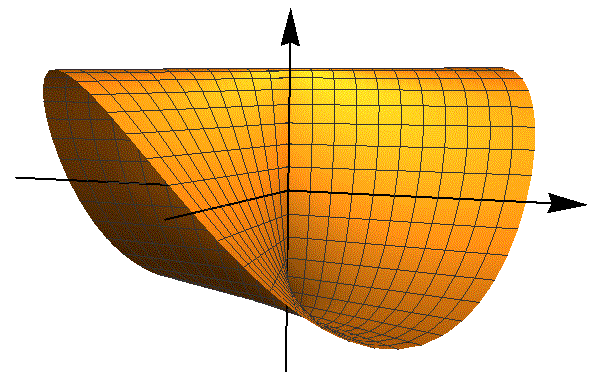
- f*(r,θ) = r sin(3θ), a linear function of t on each line (x,y) = (at,bt), but not differentiable at (x,y) = (0,0), the "crinkle" at (0,0) ruling out any good tangent plane.
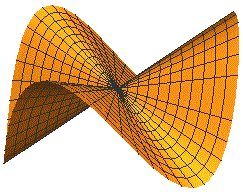
- f*(r,θ) = sin(2θ),
a function constant on each radial line (x,y) = (at,bt),
but not continuous at (x,y) = (0,0).
1. Given (x,y,z), the radius from the z-axis is r = √(x2+y2), and the radius from the origin is the hypotenuse of the right triangle with vertices (0,0,0), (x,y,0), (x,y,z):ρ = √(r2+z2) = √(x2+y2+z2). The turn of (x,y,z) from the xz-plane is the same as the turn of (x,y,0) from the x-axis:θ = arccos(x⁄√(x2+y2)) = arcsin(y⁄√(x2+y2)) = arctan(y⁄x). The tilt of (x,y,z) from the z-axis is φ, satisfying z = ρ cos(φ) and r = ρ sin(φ), so thatφ = arccos(z⁄√(x2+y2+z2)) = arcsin(√(x2+y2)⁄√(x2+y2+z2)) = arctan(√(x2+y2)⁄z). Therefore:
(ρ,θ,φ) = Sph−1(x,y,z) = (√(x2+y2+z2, arccos(x⁄√(x2+y2)), arccos(z⁄√(x2+y2+z2)) ), assuming 0 ≤ arccos(t) ≤ π and y ≥ 0, 0 ≤ θ ≤ π. For general y, we should replace the above θ by sgn(y) θ, where sgn(y) = +1 for y ≥ 0 and sgn(y) = −1 for y < 0.2a. f*(r,θ) = sin(2θ) = 2 sin(θ)cos(θ) = 2(r sin(θ))(r cos(θ))⁄r2 , corresponding to f(x,y) = 2xy⁄(x2+y2). Note that f(ta,tb) = 2ab⁄(a2+b2). Thus, although the function is identically zero along the x- and y-axes, it has a different constant value on each radial line of approach (ta,tb) as t→0; it has an essential discontinuity at (x,y) = (0,0).
2b. f*(r,θ) = r sin(3θ) = r sin(θ)cos(2θ) + r cos(θ)sin(2θ) = 3r cos2(θ)sin(θ) − r sin3(θ) = 3(r cos(θ))2(r sin(θ))−(r sin(θ))3⁄r2 , corresponding to f(x,y) = y(3x2−y2)⁄(x2+y2). Note that f(ta,tb) = b(3a2−b2)⁄(a2+b2) t. Thus, although the function has gradient ∇f(0,0) = (∂f⁄∂x(0,0),∂f⁄∂y(0,0)) = (0,−1), the linear approximation L(h1,h2) ≈ f(0,0) + ∇f(0,0)•(h1,h2) = −h2 is not valid on each radial line of approach (h1, h2) = (ta,tb) as t→0. The function is non-differentiable at (x,y) = (0,0).
- 3/23 Recitation 10: Zoo of parametric curves, surfaces, and solids (WHW 7).
- 3/24 Lect 28. More 3D parametrizations
- 3/27−4/5 ADD Lect 29−33. ⊞ Error analysis with δ-ε & little-o notation.
- Traditional delta-epsilon: limx→a f(x) = L,
also written f(x)→L as x→a:
any desired output error tolerance |f(x)−L| < ε
can be guaranteed by a sufficiently small input error |x−a| < δ. - Order class of function q(h) with q(h)→0 as h→0:
o(q(h)) = { err(h) with err(h)⁄q(h) → 0 as h→0 }
Set of error functions which become tiny relative to q(h),
even as h and q(h) get smaller & smaller - Approx with error bound: f(h) ∈ g(h) + o(q(h)) as h→0
means: f(h) = g(h) + err(h), error term err(h) = f(h) − g(h)
err(h) ∈ o(q(h)), much smaller than q(h)
Notation: f(h) = g(h) + o(q(h)), where "=" really means "∈" - Ex: limx→a f(x) = L
⇔ f(a+h) = L + o(1) as h→0
i.e. absolute error f(a+h) − L = err(h) = err(h)⁄1 → 0 as x = a+h → a - Ex: Geometric series
1⁄(1−h) =
1 + h + h2 + o(h2)
Proof: Error term err(h) = 1⁄(1−h) − (1+h+h2) = (1−1+h3)⁄(1−h) = h3⁄(1−h)
has err(h)⁄h2 = h⁄(1−h) → 0⁄1 = 0 as h→0; thus err(h) ∈ o(h2). - Definition: Function f : R → R is continuous at a whenever:
f(a+h) = f(a) + o(1) as h→0, i.e. limx→a f(x) = f(a) - Definition: Function f : R → R has derivative f '(a) whenever:
f(a+h) = f(a) + f '(a)h + o(h) as h→0
Linear approx error is small relative to window size h
Equivalent to traditional defn f '(a) = limh→0 (f(a+h)−f(a))⁄h - Combining errors: o(h) + o(h) = o(h)
If two functions lie in o(h), then their sum also lies in o(h).
Proof: If err1(h)⁄h → 0 and err2(h)⁄h → 0, then (err1(h) + err2(h))⁄h → 0,
since |(err1(h) + err2(h))⁄h| ≤ |err1(h)⁄h| + |err2(h)⁄h|
using Triangle Inequality |x+y| ≤ |x|+|y| - Combining errors:
- o(q(h)) + o(q(h)) = o(q(h))
- C o(q(h)) = o(Cq(h)) = o(q(h))
- o(h) o(q(h)) = h o(q(h)) = o(h q(h))
- o(g1(h)) ⊂ o(g2(h))
whenever g1(h) ≤ g2(h) for |h| < c
Ex: o(h2) ⊂ o(h) ⊂ o(√h)
- Product Rule: Given f,g : R→R,
and their product k(x) = f(x)g(x).
If f '(a) and g'(a) exist, then k'(a) exists, and k'(a) = f '(a)g(a) + f(a)g'(a).
Proof: Given f(a+h) = f(a) + f '(a)h + o(h), g(a+h) = g(a) + g'(a)h + o(h),
k(a+h) = (f(a) + f '(a)h + o(h))(g(a) + g'(a)h + o(h))
= f(a)g(a) + (f '(a)g(a) + f(a)g'(a)) h + err(h)
with error term err(h) = (g(a)+g'(a)h+o(h)+f(a)+f '(a)h+o(h)) o(h)
The factor (g(a)+g'(a)h+o(h)+f(a)+f '(a)h+o(h)) can be made
smaller than a constant C = |g(a)|+|g'(a)|+1+|f(a)|+|f '(a)|+1 when |h| < 1,
so err(h) ∈ C o(h) = o(h). Thus, the coefficient of h is the derivative k'(a). - Quotient error: If q(h)→0 as h→0,
then 1⁄(1−q(h))
= 1 + q(h) + o(q(h)) as h→0.
Proof: err(h) = 1⁄(1−q(h)) − (1+q(h)) = 1−(1−q(h)2)⁄1−q(h)
So: err(h)⁄q(h) = q(h)2⁄(1−q(h))q(h) = q(h)⁄(1−q(h)) → 0⁄(1−0) = 0 - Discover Quotient Formula: Derivative is slope in linear approximation
f(a+h)⁄g(a+h) = (f(a)+f '(a)h+o(h))⁄(g(a)+g '(a)h+o(h))
= (f(a)+f '(a)h+o(h))⁄g(a)(1−q(h)) for q(h) = − g'(a)h⁄g(a) − o(h)⁄g(a) = − g'(a)h⁄g(a) + o(h)
= 1⁄g(a) (f(a) + f '(a)h + o(h))(1 + q(h) + o(q(h))) = 1⁄g(a) (f(a) + f '(a)h + o(h))(1 − g'(a)h⁄g(a) + o(h))
= f(a)⁄g(a) + (f '(a)⁄g(a) − f(a)⁄g(a)2)h + o(h)
Thus k(x) = f(x)⁄g(x) has derivative at x = a equal to the linear coefficient above: k'(a) = f '(a)⁄g(a) − f(a)⁄g(a)2.
HW: Limit proofs WHW 8- 3/29 Lect 30. ADD ⊞ Vector inequalities
- Cauchy-Schwartz Inequality: u•v ≤ |u| |v|
0 ≤ (u−tv)•(u−tv) = u•u − 2t u•v + v•v
Min dist from u to ℓ(t) = tv when u−tv ⊥ v, set t = u•v⁄v•v - Triangle Inequality: |u+v| ≤ |u| + |v|; also |a−c| ≤ |a−b| + |b−c|
- 3/31 Recitation 11. Limit proofs WHW 8
- ADD ⊞ Differentiation and properties of the derivative
Reading: [MT] Ch 2.3 Differentiation. Ch 2.4 Paths and Curves. Ch 2.5 Properties of the Derivative.⊞ Solutions.
HW: From Marsden & Tromba- Find the following limits lim(x,y)→(0,0) f(x,y), if they exist.
Hints:
- Freely use known facts about one-dimensional limits, such as L'Hopital's Rule.
- Ignore points where f(x,y) is undefined: we only care whether the defined values approach a limit.
- If we can write f(x,y) = g(h(x,y)), where g(t) is a one-variable function, the limit can be reduced to computing lim(x,y)→(a,b) h(x,y) = L, then limt→L g(t).
- To show a limit does not exist, find two curves (x(t), y(t)) such that f(x(t), y(t)) approaches different values as (x(t), y(t)) → (0,0).
- (p 103 #9) f(x,y) = (exy − 1)⁄y
- (p 103 #9) f(x,y) = (cos(xy) − 1)⁄x2y2
- (p 103 #6) f(x,y) = xy3⁄x2+y6 (Examine (x(t), y(t)) = (t,0) and (t3, t).)
- (p 103 #10) f(x,y) = (x−y)2⁄x2+y2
- (p 115 #7) Consider the tangent plane P of the graph z = f(x,y) = ex−y above the point (x,y) = (1,1).
- Find an equation for P of the form z = a + bx + cy. Hint: Write the graph of the affine approximation to f(x,y) near (x,y) = (1,1), and simplify.
- Find a vector q orthogonal to the plane P (that is, orthogonal to any vector between two points of P). Hint: Write the equation for P in the form (x,y,z) • q = d. Why is this q orthogonal to P?
- (p 115 #16) Use an affine approximation for the function f(x,y,z) = (x2 + y2 + z2)1/2 to find an accurate esimate of the number: = ((4.01)2 + (3.98)2 + (2.02)2)1/2
- (p 124 #24) Consider the exponential spiral given
by: c(t) = (et cos(t), et sin(t)).
Show that the angle between the radial vector c(t)
and the velocity vector c'(t) is constant for all t.
This is why a moth flies in a spiral path around a flame: it is trying to navigate in a straight line by keeping the moon or a star at a constant angle in its field of vision. - (p 133 #13) Suppose a duck is swimming in the circular path c(t) = (cos(t), sin(t)), and the water temperature is given by T(x,y) = x2ey − xy3. Find dT⁄dt in two ways: by the Chain Rule for T(c(t)), and by writing out the formula for f(t) = T(c(t)) and directly differentiating.
- (p. 142 #4) You are walking on a hillside in the shape of the graph z = y cos(πx) − x cos(πy) + 10, standing at the point (2,1,13). Find an xy-vector direction you can walk so as to stay at the same level, a vector pointing along a contour. (How is this related to the uphill direction?)
- Consider the function f : R3 → R given by f(x,y,z) = x2 + 2y2 + 3z2.
- Describe the level surface S ⊂ R3 defined by f(x,y,z) = d, for a given constant d. (The level surface of a three-variable function is the analog of the level curve (contour) of a two-variable function.)
Hint: Consider the points with x2 + y2 + z2 = d, and modify the y- and z-coordinates to get f(x,y,z) = d. - Find the equation of the tangent plane to the surface f(x,y,z) = 13 at the point (1,0,2).
Hint: How does the level surface relate to the gradient vector ∇f(1,0,2), the direction of fastest increase of f? See M&T p. 139.
- Describe the level surface S ⊂ R3 defined by f(x,y,z) = d, for a given constant d. (The level surface of a three-variable function is the analog of the level curve (contour) of a two-variable function.)
- Theorem: Consider the function f : R3 → R with the level surface S = {(x,y,z) with f(x,y,z) = d}. Suppose
c(t) = (x(t), y(t), z(t)) is a curve contained in the surface S,
with c(0) = (a,b,c). Then the tangent vector c'(0)
is orthogonal to the gradient ∇f(a,b,c).
Thus, the level surface S is orthogonal to the gradient.
Prove this Theorem by applying the Chain Rule to f(c(t)).
Answers to odd-numbered problems are in M&T pp 502−506.
1a. f(x,y) = (exy − 1)⁄y = x (exy − 1)⁄xy = x (et − 1)⁄t , where t = xy. Since limt→0 (et − 1)⁄t = 1 by L'Hopital's Rule, we have lim(x,y)→(0,0) f(x,y) = (0)(1) = 0.
1b. Again taking t = xy and using L'Hopital twice gives lim(x,y)→(0,0) f(x,y) = (cos(t) − 1)⁄t2 = −½.
1c. Consider f(t,0) = 0, and f(t3, t) = t6⁄2t6 = ½. Thus no matter how close (x,y) is to (0,0), there are values of f(x,y) equal to 0, and others equal to ½, so f(x,y) does not approach a single limit value.
1d. We take f(t,t) = 0, and f(t, −t) = (2t)2⁄2t2 = 2, so again f(x,y) does not approach a single limit value as (x,y) → (0,0).
2a. For f(x,y) = ex−y, we have: ∂f⁄∂x|(x,y)=(1,1) = 1, and ∂f⁄∂y|(x,y)=(1,1) = −1, so the affine approximation is:
f(x,y) ≈ f(1,1) + ∂f⁄∂x (x−1) + ∂f⁄∂y (y−1) ≈ 1 + (x−1) − (y−1) ≈ 1 + x − y and the tangent plane is: z = 1 + x − y.
2b. The equation of P can be written as: −x + y + z = 1, i.e. (x,y,z) • (−1, 1, 1) = 1. Thus q = (−1, 1, 1) is orthogonal to the plane. Indeed, any two points v, v' on the plane satisfy v • q = v' • q = 1 so the vector v −v' between them, a vector parallel to the plane, has (v−v') • q = 1−1 = 0.
3. For (x,y,z) = (4.01, 3.98, 2.02) near (4,4,2), we have the affine linear approximation f(x,y,z) ≈ f(4,4,2) + ∇f(4,4,2) • (x−4, y−4, z−2) ≈ 6 + (2⁄3, 2⁄3, 1⁄3) • (x−4, y−4, z−2) = 6 + 2⁄3(x−4) + 2⁄3(y−4) + 1⁄3(z−4) = 6 + 2⁄3(0.01) + 2⁄3(−0.02) + 1⁄3(0.02).
4. The curve c(t) = et (cos(t), sin(t)) has derivative (velocity vector, tangent vector) given by the product rule:
c'(t) = (et)' (cos(t), sin(t)) + et (cos(t), sin(t))'
= et (cos(t)−sin(t), sin(t)+cos(t)),and we have |c(t)| = et, and |c'(t)| = et √2. A constant angle between c(t) and c'(t) would mean a constant dot product between the corresponding unit vectors:
cos θcc' = c⁄|c| • c'⁄|c'|
= (cos(t), sin(t)) • 1⁄√2 (cos(t)−sin(t), sin(t)+cos(t)) = 1⁄√2 .Thus θcc' = ±π⁄4 .
The moth would go inward along the path c(−t) with tangent −c'(−t), and it would see the flame at the origin in the direction −c(−t), which would give the same constant angle π⁄4 .5. For a function T(x,y) and a curve c(t) = (x(t), y(t)), the Chain Rule says:
dT⁄dt = d⁄dt T(c(t)) = ∇T(c(t)) • c'(t) = ∂T⁄∂x dx⁄dt + ∂T⁄∂y dy⁄dt . Plugging in the given functions to this formula gives the same result as first plugging in to get f(t) = T(c(t)), and then using the one-variable Chain Rule to compute f '(t).
6. In the graph, z = f(x,y), the gradient ∇f(a,b) in the xy-plane points in the uphill direction from (a,b), which is always orthogonal to the contour curve (level curve) C = {(x,y) with f(x,y) = f(a,b)}. Thus, the orthogonal vector ∇f(a,b)⊥ points along the C at (a,b). Note: ∇f(a,b) has a unique orthogonal direction because it is a vector in the plane R2. (A three-dimensional vector has a whole plane of orthogonal vectors.)
7a. The points (x,y,z) with x2 + y2 + z2 = d form the sphere with radius √d from the origin. Squeezing these points to (x, y⁄√2, z⁄√3) gives the solutions to f(x,y,z) = d, namely the level surface S. Thus S is an ellipsoid: a sphere flattened by a factor of 1⁄√2 in the y direction, and by 1⁄√3 in the z direction.
7b. The gradient ∇f(a,b,c) ∈ R3 points in the direction of fastest increase of f(x,y,z), starting from (a,b,c). This is orthogonal to the directions of no increase, namely the tangents to the level surface. (Thinking of f(x,y,z) as temperature, the gradient points in the hottest direction, which is orthogonal to the directions of constant temperature.)
The plane orthogonal to q and passing through the point p is given by v = (x,y,z) satisfying q • (v−p) = 0, or equivalently q • v = q • p. Thus, the equation of the tangent plane to S is given by:
∇f(a,b,c) • (x,y,z) = ∇f(a,b,c) • (a,b,c) 2ax + 4by + 6cz = 2a2 + 4b2 + 6c2.
For (a,b,c) = (1,0,2), this is 2x + 12z = 26.
8. Theorem: If a curve c(t) = (x(t),y(t),z(t)) goes along a level surface of the function f(x,y,z), then the tangent c'(t) is orthogonal to the gradient ∇f(c(t)).
Proof: By hypothesis, we assume f(c(t)) = a for all t and some constant a. Differentiating the left side by the multivariable Chain Rule gives:
d⁄dt f(c(t)) = d⁄dt( a ) ∇f(c(t)) • c'(t) = 0.
This confirms that the gradient is orthogonal to the tangent, as desired.
- Extra 3: ADD ⊞ Derivative rules for vector fields
Expected product rules:- ∇(f g) = (∇f) g + f (∇g)
- ∇•(f F) = (∇f) F + f (∇•F)
- ∇×(f F) = (∇f) F + f (∇×F)
- ∇•(F×G)
=
(∇•F)×G
−
F×(∇•G)
Graded exterior derivative product rule for F×G = ω∧η - ∇(F•G), no nice rule
- ∇×(F×G), no nice rule
- curl grad f = ∇×∇f = 0
- div curl F = ∇•(∇×F) = 0
- Laplacian ∇2f = div grad f = ∇•∇f = ∂2f⁄∂x2 + ∂2f⁄∂y2 + ∂2f⁄∂z2
- Vector Laplacian:
∇2F
= grad div F − curl curl F
= ∇(∇•F) −
∇×(∇×F)
∇2(Fx, Fy, Fz) = (∇2Fx, ∇2Fy, ∇2Fz)
- 4/6 Recitation 12. Review Taylor Series (Math 133)
- 4/7 & 9 ADD Lect 34 & 35. ⊞ Taylor series for f(x,y).
⊞ Soln- Higher derivatives; equality of mixed partials:
∂2f⁄∂x∂y
=
∂2f⁄∂y∂x
provided both second deriv functions are continuous at (x,y) = (a,b) - Proof of Taylor's Theorem with remainder bound.
Repeated integration by parts of
f(a+h) = f(a) + ∫aa+h f '(t) dt = f(a) − ∫aa+h f '(t)(a+h−t)' dt
gives integral form:f(a+h) = f(a) + f '(a)h + f "(a)⁄2! h2 + · · · + f (k)(a)⁄k! hk + Rk(a,h), with remainder Rk(a,h) = 1⁄k! ∫aa+h f(k+1)(t) (a+h−t)k dt.
Thus, |Rk(a,h)| ≤ M |h|k+1⁄k!, where |f(k+1)(t)| ≤ M for t ∈ [a,a+h]. - Taylor Formula for f : R2 → R
f(a+h1,b+h2) = ∑i,j≥0 1⁄i!j! ∂fi+j⁄∂ix∂jy(a,b) h1i h2j
f(x,y) = ∑i,j≥0 1⁄i!j! ∂fi+j⁄∂ix∂jy(a,b) (x−a)i(y−b)j
Warning: Coefficients are constants involving (a,b), not functions of (x,y) - Quadratic term in Taylor approx given by Hessian matrix:
f(a+h) = f(a) + [Dfa]•h + 1⁄2 h•[Hfa]•hT + o(|h|2)
where h is 1×2 row-vector, [Hfa] is 2×2, hT is 2×1 column-vector
Equality of mixed partials ⇒ Hessian [Hf] is a symmetric matrix[Hfa] = ∂2f⁄∂x2(a) ∂2f⁄∂x∂y(a) ∂2f⁄∂y∂x(a) ∂2f⁄∂y2(a)
HW:- Consider an iron bar marked with the
position coordinate x ≥ 0,
and let f(x,t) denote the temperature of position x at time t.
The Heat Equation is a partial differential equation
(i.e. a differential equation involving partial derivatives)
which models the flow of heat in the bar: the temperature f(x,t) must satisfy:
∂f⁄∂t = ∂2f⁄∂x2
Problem: Show that f(x,y) = 1⁄√t exp(− x2⁄4t) is a solution to the Heat Equation. Graph some slices z = f(x,t) above t = 0.1, 0.5, 1.0, 2.0 to see how the heat dissipates from a point-source at x = 0. - (Ch 3.1 p 157 #18) For f(x,y,z) = z exy + x2yz3, verify that:
∂3f⁄∂x∂y∂z = ∂3f⁄∂z∂y∂x
- Let f(x,y) = cos(xy).
- Give the quadratic Taylor approximation of f(x,y) centered
at (x,y) = (0,0),
f(h1,h2) ≈ c00 + c10 h1 + c01 h2 + 1⁄2(c20 h12 + c11 h1 h2 + c02 h22) for explicit constants c00,...,c02.
Note: error term is o(|h2|) = o(h12+h22) as (h1,h2) → (0,0) - Use the infinite Taylor series for cos(t) at t = 0 to find the full Taylor series of f(x,y) at (x,y) = (0,0).
- Give the quadratic Taylor approximation of f(x,y) centered
at (x,y) = (0,0),
- (Ch 3.2 p 166 #11) Find the second-order Taylor polynomial (quadratic approximation) at (x,y) = (½π, 1) for the function:
f(x,y) = sin(xy) − 3x2 log(y) + 1. - (Ch 3.3 p 182 #5, 9, 19) Find the critical points of the following
functions, and use the Hessian to classify them as maximum, minimum, saddle,
or degenerate.
e1+x2−y2 , cos(x2+y2)
1⁄3 x3 + 1⁄3 y3 − 1⁄2 x2 − 5⁄2 y2 + 6y + 10.
Verify your conclusions by inspecting the contour plots or graphs of these functions. (This is the easiest way to classify the critical points, but it is only possible for two variables.) - The Positive-Definiteness Criterion (Lemma 2, p. 174−176) says that,
if we have a quadratic function defined by
a Hessian matrix:
q(x,y) = [x,y] • a b b c • [x,y]T = ax2 + 2bxy + cy2,
then q(x,y) is positive-definite, meaning q(0,0) = 0 and q(x,y) > 0 for (x,y) ≠ (0,0), whenever a > 0 and det(H) = ad − bc > 0.
Prove this by completing the square to get:q(x,y) = a(x + b⁄a y)2 + (ac−b2)⁄a y2.
For what a,b,c is this always positive?
1. See M&T p. 156, Example 6.
3a. cos(h1h2) = 1 + o(h12+h22), since all the first and second partial derivatives become zero for (x,y) = (0,0). In fact, the first non-zero term is 1⁄2 h12h22.
3b. Using cos(t) = ∑n≥0 (−1)n⁄(2n)! t2n gives: cos(h1h2) = ∑n≥0 (−1)n⁄(2n)! h12nh22n
4. See p. 509.
5. See p. 510. Correction for #19: For f(x,y) = 1⁄3 x3 + 1⁄3 y3 − 1⁄2 x2 − 5⁄2 y2 + 6y + 10, the critical points are classified as:
(0,3) saddle, (1,2) saddle, (0,2) max, (1,3) min.
6. See p. 175.
- 4/12 Lect 36. ADD ⊞ Hessians, Second Derivative Test.
Reading & HW: [MT] Ch 3.3, including odd exercises p. 182, especially #13, 17, 25, 27, 31, 35. Solutions p. 510.- Extra 4. ADD ⊞ Constrained extrema, Lagrange multipliers.
Reading: [MT] Ch 3.4⊞ Solutions
HW:- Let f(x,y) = x2 + xy + y2 + x + y.
- Find the critical points of f(x,y), and classify them using the Hessian. Determine the maximum and minimum values of f(x,y) on R2.
- Find the extrema (max/min) points of f(x,y) constrained to the curve g(x,y) = x2 + y2 = 1. Use Lagrange multipliers to reduce the problem to a system of equations in variables x, y, λ: g(x,y) = 1, ∇f(x,y) = λ∇g(x,y). Finally, determine which of the local extrema is the absolute max and min.
- Redo part (a) with a parametric description of the curve S, given by c(t) = (sin(t), cos(t)) for 0 ≤ t ≤ 2π. That is, find each local extremal point t = a of the one-variable function h(t) = f(c(t)), then take c(a) as a constrained extremal point of f(x,y).
- Use the Chain Rule to explain why the equation h'(t) = 0 in part (b) gives a minimum point (x0,y0) = c(a) where ∇f(x0,y0) is parallel to ∇g(x0,y0), as in part (b). Hint: Use the Chain Rule on the equation g(c(t)) = 1 for all t.
- Using the previous parts, find the absolute max and min points of f(x,y) on the disk x2 + y2 ≤ 1. (Consider the interior region and the boundary circle separately.)
- (Redo Lect 6 #3.) Consider a rectangular bin having a bottom but no top, and three sides with the fourth side open. Assuming it has volume 1, find the values of (x,y,z), the length, width and height, which will minimize the total surface area of the three sides and bottom. That is, minimize the area function f(x,y,z) constrained to the level surface S given by the volume function g(x,y,z) = 1; use Lagrange multipliers. (We did this in HW 1/13 #5, by parametrizing the surface S as the graph z = 1/xy, and minimizing f(x,y,1/xy) on the region x,y > 0.)
1a. The critical points are defined by ∇f(x,y) = (2x+y+1, x+2y+1) = (0,0). Solving this linear system of equations gives (x,y) = (−⅓, −⅓). The Hessian is:
Hf(x,y) = 2 1 1 2 ,
which is the same at the critical point: H = Hf(−⅓, −⅓). The leading principal minors det H1 = 2 and det H2 = (2)(2)−(1)(1) = 3 are both positive, so H is positive definite, and f has a local minimum (hole) at this point, which must be the absolute minimum point. There is clearly no absolute maximum, since f(x,y) → ∞ as |(x,y)| → ∞.1b. We solve ∇f(x,y) = λ ∇g(x,y) and g(x,y) = 1. That is:
2x + y + 1 = 2λx, x + 2y + 1 = 2λy, x2 + y2 = 1. Clearly λ = 0 is not a solution, since this would mean ∇f(x,y) = (0,0), giving the critical point we found in part (a), which does not lie on x2 + y2 = 1. Thus, we may divide the first two equations, giving (2x+y+1)⁄x+2y+1 = x⁄y . Cross-multiplying gives y2 − x2 + y − x = 0, which factors as (y−x)(y+x+1) = 0, giving solutions y = x or y = −x−1.
If y = x, the equation x2 + y2 = 1 gives (x,y) = ±(1⁄√2, 1⁄√2) .
If y = −x−1, the equation x2 + y2 = 1 gives (x,y) = (0, −1) or (−1, 0)
Evaluating f(x,y) on these 4 critical points gives:f(1⁄√2, 1⁄√2) ≈ 2.9, f(−1⁄√2, 1⁄√2) ≈ 0.1, f(0, −1) = f(−1, 0) = 0.
Thus, the last two are the constrained absolute minimum points of f(x,y), and the first is the constrained absolute maximum point.1c. To find the critical points of:
h(t) = cos2(t) + cos(t) sin(t) + sin2(t) + cos(t) + sin(t)
= 1 + cos(t) sin(t) + cos(t) + sin(t),
we solve h'(t) = −sin2 + cos2(t) − sin(t) + cos(t) = 0. We can rewrite this as: −1 + 2cos2(t) + cos(t) = ±√(1−cos2(t)). Substituting x = cos(t), we have: 2x2 + x − 1 = √(1−x2), which leads to: x(x−1)(2x2+1) = 0, giving the same (x,y) = (cos(t), sin(t)) as in part (a).1d. We show how minimizing f(x,y) over the parametrized constraint curve c(t) = (cos(t), sin(t)) leads to the Lagrange Multiplier method, in which we consider the curve as a contour of g(x,y) = x2 + y2.
To minimize h(t) = f(c(t)), we solve 0 = h'(t) = ∇f(c(t)) • c'(t). For a solution t = a with c(a) = (x0,y0), we have ∇f(x0,y0) orthogonal to c'(a), the tangent direction of the circle S at (x0,y0).
On the other hand, the circle is defined by g(x,y) = x2 + y2 = 1, so we have g(c(t)) = 1. Differentiating this and using the Chain Rule gives: ∇g(c(t)) • c'(t) for all t, including t = a, so that ∇g(x0,y0) is also orthogonal to the tangent direction c'(a). Since both ∇f(x0,y0) and ∇g(x0,y0) are orthogonal to the same direction in R2, they must be parallel.1e. Evaluate f(x,y) both at the critical points found in part (a), and at the constrained extrema found in part (b) or (c). The largest/smallest of these gives the absolute max/min of f(x,y) within the disk. This is the two-dimensional version of finding the max/min of a single-variable function f(x) on an interval x ∈ [a,b] by finding critical points of f(x) inside the interval, then comparing to the endpoint values f(a), f(b).
Answer: the absolute minimum is at the interior critical point (−⅓, −⅓); the absolute maximum is at the boundary point (1⁄√2, 1⁄√2).2. Letting x,y,z be the side-lengths of the rectangular bin missing the top and front, the volume is g(x,y,z) = xyz = 1, with ∇g(x,y,z) = (yz, xz, xy). The surface area of the four sides is f(x,y,z) = xy + yz + 2xz, with ∇f(x,y,z) = (y+2z, x+z, y+2x). The Lagrange Multiplier method gives equations ∇f(x,y,z) = λ ∇g(x,y,z) and g(x,y,z) = 1, solved for variables x,y,z > 0, and λ:
y + 2z = λyz, x + z = λxz, y + 2x = λxy, xyz = 1.
Note that these equations are symmetric in x and z. If λ = 0, we get x = y = z = 0, which is excluded. Since x,y,z,λ ≠ 0, we can divide the first two equations to get y + 2z⁄x + z = yz⁄xz , and cross-multiplying implies 2x = y. Similarly 2z = y, so the last equation gives y3⁄4 = 1, and (x,y,z) = (2−1/3, 22/3, 2−1/3), agreeing with the method in our previous HW.- 4/13 Recitation 13. ADD ⊞ Constrained max/min problems.
Reading: [MT] Ch 3.3, 3.4. WHW 9 due 4/17.
Note: You can get Mathematica for free, though you can probably make do with Wolfram Alpha.- 4/14 Lect 37. ⊞ Line integrals, potential functions. Arclength.
Reading: [MT] Ch 7.2, odd ex p. 373; review Lect 11, 12 on line integral.⊞ Soln
[MT] Ch 4.2, odd ex p. 234; review Lect 14 on arclength.
HW:- Consider the vector field F(x,y,z) = (−x,−y,1).
- Make a rough sketch and verbal description of the arrows of F.
- Find a potential function f(x,y,z) with ∇f = F, by evaluating a line integral ∮ F(c)•dc over the straight line c from (0,0,0) to (a,b,c).
- Redo the above line integral over the curve c = (at, bt2, ct3) for t ∈ [0,1].
- Write an integral to compute the arclength of the curve c = (t, t2, t3) for t ∈ [0,1]. Get a numerical approximation from Wolfram Alpha.
- Consider the vector field F(x,y,z) = (−y,x,1).
- Make a rough sketch and verbal description of the arrows of F.
- Try to find a potential function f(x,y,z) with ∇f = F, by evaluating a line integral ∮ F(c)•dc over the straight line c(t) = (at,bt,ct) from (0,0,0) to (a,b,c). Check to see if the resulting function really has the desired gradient.
- Redo the above line integral over the curve c(t) = (at2, bt2, ct2) for t ∈ [0,1]. This is the same straight line, but traversed at a different speed. We say that this is a reparametrization of the original c(t) = (at,bt,ct).
- Try to express intuitively why the vector field is not conservative. (Compare to the two-variable case from Lect 13 and WHW 5.
1a. The vector field F(x,y,z) = (−x,−y,1) points in toward the z-axis and tilts upward. Nearer the z-axis, the vectors get shorter and tilt up more, pointing straight up along the axis itself.

1b. Using the Gradient Theorem, f(a,b,c) − f(0,0,0) = ∮ F(c)•dc = ∫10 F(at,bt,ct) • (at,bt,ct)' dt = ∫10 (−at,−bt,1) • (a,b,c) dt = ∫10 −a2t − b2t + c dt = −½a2t2 − ½b2t2 + ct |1t=0 = −½a2 − ½b2 + c. Setting the constant of integration as f(0,0,0) = 0, we get f(x,y,z) = −½x2 − ½y2 + z, which indeed gives ∇f(x,y,z) = (−x,−y,1) = F(x,y,z).
1c. f(a,b,c) = ∫10 F(at, bt2, ct3) • (at, bt2, ct3)' dt = ∫10 (−at, −bt2, 1)•(a, 2bt, 3ct2) dt = ∫10 −a2t − 2b2t3 + 3ct2 dt = −1⁄2a2t2 − 2⁄4b2t4 + ct3 |1t=0 = −½a2 − ½b2 + c, giving the same f(x,y,z) = −½x2 − ½y2 + z as before. This is expected because of the Gradient Theorem, which guarantees that a gradient vector field is path-independent, depending only on the enpoints of the path of integration.
1d. L = ∮ |dc| = ∫10 |c'(t)| dt = ∫10 |(1, 2t, 3t2)| dt = ∫10 √(1 + 4t2 + 9t4) dt ≈ 1.86 , slightly longer than the straight-line path with length |(1,1,1)| = √3 ≈ 1.73 .
2a. The vector field F(x,y,z) = (−y,x,1) rotates around the z-axis (with right-handed orientation) and tilts upward. Nearer the z-axis, the vectors get shorter and tilt up more, pointing straight up along the axis itself.
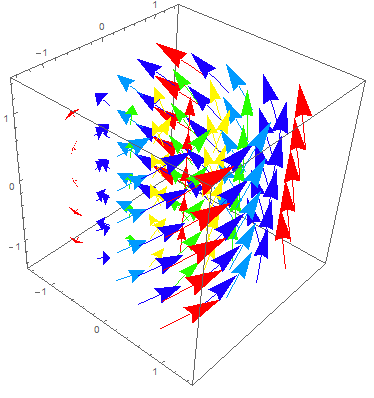
2b. F(c)•dc = ∫10 F(at,bt,ct) • (at,bt,ct)' dt = ∫10 (−bt,at,1) • (a,b,c) dt = ∫10 −bat + abt + c dt = ct |1t=0 = c. Thus f(x,y,z) = z gives ∇f(x,y,z) = (0,0,1), which is not F(x,y,z) = (−y,x,1). Thus, F cannot be a conservative vector field: there is no potential function.
2c. ∫10 F(at2, bt2, ct2) • (at2, bt2, ct2)' dt = ∫10 (−bt2, at2, 1)•(2at,2bt,2ct) dt = ∫10 2ct dt = ct2|1t=0 = c. This gives the same function f(x,y,z) = z as in part (b).
In fact, even if the vector field is non-conservative, and the line integral changes upon changing the path between fixed endpoints, nevertheless the line integral is unchanged upon reparametrizing the same curve. We say that line integrals are always independent of parametrization, even if they are not path-independent.2d. The vector field is not conservative because its vortex pattern has non-zero circulation, and thus gives different line integrals along the two halves of a loop. In the next lecture, we will define curl F, and see it is non-zero.
- 4/17 Lect 38. ⊞ Curl in 3 dim. Conservative vector fields.
⊞ Soln- Geometric meaning of line integral ∮ F(c)•dc :
How strongly F pulls along curve c
Negative if F pulls against direction of c - Physical meaning of line integral:
Work done by force F in moving particle along c
= negative of work done by particle moving along c against force F - If F is conservative, the work done by F
between two points
is the increase of potential between the points, independent of path.
Equivalent to zero circulation: line integral of F around any closed loop is zero. - Vector field F(x,y,z) = (p(x,y,z), q(x,y,z), r(x,y,z))
3-dim curl of F is vector of 2-dim curls of projections of F
curl F = (curlyz(q,r), −curlxz(p,r), curlxy(p,q))
= (∂r⁄∂y−∂q⁄∂z , ∂p⁄∂z−∂r⁄∂x , ∂q⁄∂x−∂p⁄∂y)
= ∇×F = (∂⁄∂x , ∂⁄∂y , ∂⁄∂z) × (p, q, r) - Rate of circulation of F in plane
pependicular to a unit vector v is (curl F) • v
Maximum rate of circulation is |curl F| in direction v = curl F⁄|curl F| - Direction of curl F(a,b,c) = axis of rotation
of multi-directional paddlewheel
with center fixed at (a,b,c), under the flow F
Length |curl F(a,b,c)| = strength of rotation - If F is conservative, having zero circulation, then rate of circulation is zero in all directions, curl F = 0
HW: [MT] Exercises p. 259 #13−20, 21(b), 22(a), 23(b), 29−35.- For the two vector fields in Lect 37 HW #1,2, compute the curl and visually verify the geometric meaning.
1. Using the determinant formula, curl(−x,−y,1) = (0,0,0). This makes sense from the picture, since for any small rectangle in a coordinate plane, F is either perpendicular to it, or pushes along opposite sides equally, making zero circulation near every point.
2. We have curl(−y,x,1) = (0,0,2), which matches the rotation of F around the z-axis in the picture. Also, I can use the right-hand rule to determine the polarity of the rotation axis: if I curl my fingers in the direction of rotation, my thumb points upward in the positive z-direction, agreeing with curl F = +2k.
- 4/19 Lect 39. ⊞ Area of a parametrized surface.
⊞ Soln- Parameter region S* ⊂ R2
for surface S ⊂ R3
Parametrization P : S* → S, P(u,v) = (x(u,v), y(u,v), z(u,v)) - Find stretching factor of P(u,v) near a point (u,v) = (a,b)
Same as stretching factor of linear approx
DP(a,b) = [∂P⁄∂u | ∂P⁄∂v ] Jacobian matrix 3×2
with column vector ∂P⁄∂u = (∂x⁄∂u, ∂y⁄∂u, ∂z⁄∂u), similar ∂P⁄∂v
Linear mapping DP(a,b) : R2 → R2 stretches unit square
to parallelogram in R3 spanned by ∂P⁄∂u , ∂P⁄∂v
Area of parallelogram spanned by a, b is length |a×b| = |a||b|sin(θab)
Stretching factor is: |∂P⁄∂u × ∂P⁄∂v| - Area = limit of sum of areas of small parallelograms in S
Area(S) = ∬S* |∂P⁄∂u×∂P⁄∂v| du dv
HW:- Consider the sadddle surface given by the graph z = x2 − y2 above the unit square
(x,y) ∈ [0,1] × [0,1]; that is
0 ≤ x ≤ 1 and 0 ≤ y ≤ 1.
- Find a parametrization P : S* → S. Hint: What parameter variables control the position of a point on S?
- Find the Jacobian matrix dP(u,v), and the stretching factor |∂P⁄∂u×∂P⁄∂v|.
- Set up a double integral to evaluate the area. Use Wolfram Alpha to find numerical approximation.
- Find the lengths of the edge curves of S, above the x- and y-axes. (Parametrize the curves and compute the length L = ∮ |dc|.) How does the area compare to the product of the edge-lengths, and to the area of the parameter region S*?
- Write and simplify the area integrals for
- A general graph z = g(x,y) for (x,y) in a plane region D ∈ R2
- A general surface of revolution, rotating a curve y = f(x), for x ∈ [a,b], around the x-axis. (Assume f(x) ≥ 0.)
- Compute the areas of:
- The sphere of radius r
- The torus with core radius R, sectional radius r (see Lect 27).
- Review of cross product. Let a = (1,2,−1),
b = (1,0,1).
- Compute a×b
- Verify the defining property of cross product: det(a,b,v) = (a×b) • v.
- Verify that a×b is orthogonal to a, b.
- Verify that |a×b| = |a| |b| sin(θab), and that this is the area of the parallelogram (actually a rectangle) spanned by a, b.
1. The parametrization P(u,v) = (u, v, u2−v2) gives A = ∫10∫10 √(1+4x2+4x2) dx dy ≈ 1.86 . The edge above the x-axis is c(t) = (0, t, −t2), with length ∫10√(1+4t2) dt ≈ 1.48. The other edge curve has the same length, and their product is 1.492 ≈ 2.19 , bigger than the actual area, which is in turn bigger than 1, the parameter region area.
- 4/21 Lect 40. ⊞ Surface flux integrals.
- Surface S parametrized by P(u,v) for (u,v) ∈ S*
Tangent vectors ∂P⁄∂u , ∂P⁄∂v pointing along u,v grid lines of S
Normal vector n(u,v) = ∂P⁄∂u × ∂P⁄∂v , perpendicular to S pointing toward the "positive" side - Flux of vector field F across S:
net flow of F from negative to positive side
of S
∬S F • dn = ∬S* F(P(u,v)) • n(u,v) du dv Justification: Flux = ∬S F • n⁄|n| |n| du dv, where:
F • n⁄|n| = component of flow perpendicular to S (i.e. across surface S)
|n| = |∂P⁄∂u×∂P⁄∂v| = area stretching factor of parameterization P(u,v) - Ex: S = unit hemisphere x2+y2+z2 = 1 , x ≥ 0
Parametrize: P(φ,θ) = (sin(φ)cos(θ), sin(φ)sin(θ), cos(φ)) for 0 ≤ φ ≤ π , −π⁄2 ≤ θ ≤ π⁄2
Normal vector: n = ∂P⁄∂φ×∂P⁄∂θ = (sin2(φ)cos(θ), sin2(φ)sin(θ), sin(φ)cos(φ)), points outward
Vector field F(x,y,z) = (0,0,z+1), pointing upward on S, getting longer as you go up
Net flow is positive: weak inflow of F through bottom of S, stronger outflow through top
Compute: net flow of F through S = ∬S F • dn = ∬S* F(P(u,v)) • n(u,v) du dv
= ∬S* F(sin(φ)cos(θ), sin(φ)sin(θ), cos(φ)) • (sin2(φ)cos(θ), sin2(φ)sin(θ), sin(φ)cos(φ)) du dv
= ∬S* (0, 0, cos(φ)−1) • (sin2(φ)cos(θ), sin2(φ)sin(θ), sin(φ)cos(φ)) du dv
= ∫ −π/2 π/2 ∫ 0 π (cos(φ)−1) sin(φ) cos(φ) dφ dθ = 2⁄3
- 4/24 Lect 41. ⊞ Curl Theorem in 3 dimensions (Stokes Theorem).
⊞ Soln- The total circulation of vector field F
around a closed loop c is equal to
the total rate of circulation on a surface S whose boundary (∂S) is c
which is equal to the flux of curl F through S∮ F(c) • dc = ∬S curl F • dn, where c = ∂S Do not confuse the two different vector fields F on the left side and curl F on the right! - Justification:
rate of circulation of F pependicular to a unit vector v is (curl F) • v
Rate of circulation of F parallel to S (perpendicular to n) is (curl F) • n⁄|n|
Stretching factor of parametrization is |n|
Integral of rate of circulation is: ∬S* (curl F) • n⁄|n| |n| du dv = ∬S F • dn
HW:- Let S = hemisphere x2+y2+z2 = 1, x ≥ 0, from Lect 40 example,
and take F(x,y,z) = (0, 0, y(z+1)).
- Parametrize S by P(u,v) with P : S* → S, and find its normal vector n(u,v).
- Compute curl F.
- Compute the flux integral of curl F through S: that is ∬S curl F • dn = ∬S* F(P(u,v)) • (∂P⁄∂u×∂P⁄∂v) du dv.
- Parametrize the circular boundary of S by c(t), and compute its tangent vector c'(t).
- Compute the circulation of F around c, that is ∮ F(c) • dc, and verify that it gives the same answer as the double integral (c).
1a. The spherical coordinate mapping and its normal vector function are given in the Lect 40 example: P(φ,θ) = (sin(φ)cos(θ), sin(φ)sin(θ), cos(φ)) for 0 ≤ φ ≤ π , −π⁄2 ≤ θ ≤ π⁄2 . Normal vector: n = ∂P⁄∂φ×∂P⁄∂θ = (sin2(φ)cos(θ), sin2(φ)sin(θ), sin(φ)cos(φ))
1b. For F(x,y,z) = (0, 0, y(z+1)), different from the Lect 40 example, we have:
curl F(x,y,z) = (∂⁄∂y(y(z+1)) − ∂⁄∂z(0), −∂⁄∂x(y(z+1)) + ∂⁄∂z(0), ∂⁄∂x(0) − ∂⁄∂y(0)) = (z+1, 0, 0). 1c. ∬S curl F • dn
= ∫ −π/2 π/2 ∫ 0 π curl F(sin(φ)cos(θ), sin(φ)sin(θ), cos(φ)) • n(φ,θ) dφ dθ
= ∫ −π/2 π/2 ∫ 0 π (cos(φ)+1, 0, 0) • (sin2(φ)cos(θ), sin2(φ)sin(θ), sin(φ)cos(φ)) dφ dθ
= ∫ −π/2 π/2 ∫ 0 π (cos(φ)+1) sin2(φ) cos(θ) dφ dθ
= (∫ −π/2 π/2 cos(θ) dθ) (∫ 0 π (cos(φ)+1) sin2(φ) dφ) = (2)(π⁄2) = π.1d. The vertical boundary circle ∂S, with equations x = 0 and y2+z2 = 1, is given parametrically by c(t) = (0, cos(t), sin(t)) for 0 ≤ t ≤ 2π. Note that in curling the fingers of my right hand around c, my thumb points along the positive x-axis, which is the positive direction for S. The tangent vector is c'(t) = (0, −sin(t), cos(t)).
1e. ∮ F(c) • dc = ∫02π F(0, cos(t), sin(t)) • (0, cos(t), sin(t))' dt
= ∫02π (0, 0, cos(t)(sin(t)+1)) • (0, −sin(t), cos(t)) dt
= ∫02π cos2(t)(sin(t)+1) dt = π.
This agrees with part (c), as it must by the Curl Theorem.- 4/27 Recitation 15. ⊞ Curl and Divergence Theorem examples.
⊞ Soln- Divergence: For vector field F(x,y,z)
= (p(x,y,z), q(x,y,z), r(x,y,z))
div F(x,y,z) = ∂p⁄∂x + ∂q⁄∂y + ∂r⁄∂z = ∇•F
Geometric meaning: rate of flux of F out of a small box near point (x,y,z)
relative to volume Δx Δy Δz. - Divergence Theorem (Gauss Theorem):
Solid region R,
boundary surface S = ∂R, vect field F
Flux of F out of S equals integral of rate of flux over the region R inside S.
∬S F • dn = ∭R div F dx dy dz
HW:- Curl Theorem.
Consider the tilted ellipse surface S
along the plane z = x+1 and inside the cylinder
x2 + y2 ≤ 1.
Also let F(x,y,z) = (−y,x,z).
- Parametrize S and its boundary curve c. Hint: First write the x- and y-coordinates of P(u,v) = (x(u,v), y(u,v), z(u,v)), then find z.
- Find the normal vector n(u,v) for S, and the tangent vector c'(t).
- Compute the total circulation of F around c.
- Compute the flux of curl F across S. By the Curl Theorem, this should the same as the circulation of F around the boundary curve in part (c).
- Divergence Theorem.
Consider the solid region R under the above plane
z = x+1, above the yz-plane, and inside the cylinder
x2 + y2 ≤ 1,
the shape of a wedge cut out of a tree-trunk:
R = {(x,y,z) | x2 + y2 ≤ 1 , 0 ≤ z ≤ x+1}. Again let F(x,y,z) = (−y,x,z).- Parametrize R and its three boundary surfaces, the top S1, side S2, and bottom S3. (The top is the same ellipse as in #1.)
- Compute the stretching factor det[DQ(u,v,w)] of the parametrization Q(u,v,w) of region R.
- Compute the normal vectors n(u,v) for S1, S2, S3. You might have to take negative of a normal to make sure it points out from R.
- Compute the total flux of F across the three surfaces.
- Compute the integral of div F on R. By the Divergence Theorem, this should the same as the flux of F across the boundary surfaces in part (d).
1a. Cylindrical coorinates: P(r,θ) = (r cos(θ), r sin(θ), r cos(θ) + 1) for 0 ≤ r ≤ 1 and 0 ≤ θ ≤ 2π. The boundary is: c(t) = (cos(t), sin(t), cos(t)+1) for 0 ≤ t ≤ 2π.1b. n(r,θ) = ∂P⁄∂r × ∂P⁄∂r = (cos(θ), sin(θ), cos(θ)) × (−r sin(θ), r cos(θ), −r sin(θ)) = (−r, 0, r). The normal vector function is so simple because S lies in a plane orthogonal to (−1, 0, 1). The length |n| is the stretching factor of the parametrization: the grid boxes of P have size proportional to the radius r.
The tangent vector of the curve is: c'(t) = (−sin(t), cos(t), −sin(t)).
1c. ∮ F(c) • dc = ∫02π F(cos(t), sin(t), cos(t)+1) • (cos(t), sin(t), cos(t)+1)' dt = ∫02π (−sin(t), cos(t), cos(t)+1) • (−sin(t), cos(t), −sin(t)) dt • (cos(t), sin(t), cos(t)+1)' dt = 2π.
1d. We have curl F = (0,0,2), meaning that near every point, F primarily rotates around a vertical axis. The flux of the curl through S is:
∬S F × dn = ∫01 ∫02π (0,0,2) × (−r, 0, r) dθ dr = ∫01 4πr dr = 2π, which agrees with part (c), confirming the Curl Theorem in this case.2a. R is parametrized in cylindrical coordinates by Q(r,θ,z) = (r cos(θ), r sin(θ), z) over the parameter region:
R* = {(x,y,z) | 0 ≤ r ≤ 1 , 0 ≤ θ ≤ 2π , 0 ≤ z ≤ r cos(θ) + 1}. Here the z-range is defined by floor and ceiling functions depending on the previous variables r, θ.The top surface S1 is the same as S from #1; let us call its function P1(r,θ). The side surface S2 is defined by P2(θ,z) = (cos(θ), sin(θ), z) over S2* defined by 0 ≤ θ ≤ 2π and 0 ≤ z ≤ cos(θ)+1. The bottom surface S3 is the unit disk P3(r,θ) = (r cos(θ), r sin(θ) over S3* defined by 0 ≤ r ≤ 1 and 0 ≤ θ ≤ 2π.
2b. The stretching factor of Q(r,θ,z) is the determinant of its Jacobian matrix, i.e. the volume of the parallelopiped spanned by the gridline tangent vectors ∂Q⁄∂r, ∂Q⁄∂θ, ∂Q⁄∂z. This works out to det[DQ] = r, the same as for polar coordinates, since the z direction is not stretched at all.
2c. The normal vector of S1 is dn1 = (−r, 0, r), which correctly points upward (outward from R). The normal vector of S2 is dn2 = (cos(θ), sin(θ), 0), which points outward. The normal vector of S3 seems to be (cos(θ), sin(θ), 0) × (−r sin(θ), r cos(θ), 0) = (0, 0, r), but this points upward into R, so we must use its outward-pointing negative: n3 = (0, 0, −r).
2d. The total flux of F over the top surface is: ∬S2 F • dn2 = ∬S1* F(P1(r, θ)) • n1(r,θ) dr dθ = ∫01 ∫02π (−r sin(θ), r cos(θ);, r cos(θ) + 1) • (−r, 0, r) dr dθ = π.
From drawing R and F, we can see that F is parallel to the surface along S2 and S3, so it has no flux through these surfaces. This can be confirmed by calculating ∬S2 F • dn2 = ∬S3 F • dn3 = 0. Therefore the total flux over the surface ∂R = S1 ∪ S2 ∪ S3 is π + 0 + 0 = π.
2e. We have div F = ∂⁄∂x(−y) + ∂⁄∂y(x) + ∂⁄∂z(z) = 1. That is, F has a constant rate of flux from every point, due to the smaller inflow at the bottom of a small box than the outflow at the top.
Thus ∭R div F dx dy dz = ∭R* 1 det[DQ] dz dθ dr = ∫01 ∫02π ∫0r cos(θ)+1 r dz dθ dr = π, which agrees with (d), confirming the Divergence Theorem in this case.- 4/28 Final Review. ⊞ Syllabus
Final Exam Monday May 1, 2017, 3:00-5:00, in our usual classroom Wells A-322.- Geometric objects
- Vectors v = (x1,..., xn) ∈ Rn,
with addition, subtraction, scalar multiplication
Dot product: u•v = |u| |v| cos θuv
Cross product for v = (x,y,z): (u×v) • w = det(u,v,w), |u×v| = |u| |v| sin θuv - Curve C ⊂ Rn parametrized by c : R → Rn, c(t) over t ∈ [a,b], c(t) = (x1(t),..., xn(t))
- Region R ⊂ Rn
(plane or solid) with boundary ∂R,
points (x1,..., xn) ∈ R defined by:
- Simple region (floor/ceiling):
Plane: a ≤ x ≤ b, c(x) ≤ y ≤ d(x)
Space: a1 ≤ x ≤ b1, a2(x) ≤ y ≤ b2(x), a3(x,y) ≤ z ≤ b3(x,y)
General: a1 ≤ x1 ≤ b1, a2(x1) ≤ x2 ≤ b2(x1), a3(x1,x2) ≤ x3 ≤ b3(x1,x2), . . . - Coordinate parameter function P : Rn → Rn
over simple parameter region u ∈ R*
P(u1,...,un) = (x1(u1,...,un), . . . , xn(u1,...,un)) - Inequality f(x1,..., xn) ≤ c, with boundary contour f(x1,..., xn) = c
- Simple region (floor/ceiling):
- Surface S ⊂ R3
with boundary curve ∂S, defined by:
- Parameter function P : R2 → R3,
P(u,v) = (x(u,v), y(u,v), z(u,v))
over simple parameter region (u,v) ∈ S* - Contour equation f(x,y,z) = c, cut off by inequalities g(x,y,z) ≤ a.
- Parameter function P : R2 → R3,
P(u,v) = (x(u,v), y(u,v), z(u,v))
- Vectors v = (x1,..., xn) ∈ Rn,
with addition, subtraction, scalar multiplication
- Functions
- Scalar function f : Rn → R, number at each point (e.g. height, temperature, potential energy)
- Vector field F : Rn → Rn, arrow at each point (flow velocity, force)
- General parameter function P : Rn → Rm
- Derivative operations
- Nabla ∇ = (∂⁄∂x1 , ∂⁄∂x2 , ...)
- Partial derivative ∂f⁄∂xi , grad f(x1,...,xn) = ∇f
= ∂f⁄∂x1 +
· · · + ∂f⁄∂xn
Linear approximation: f(a+h) = f(a) + ∇f(a)•h + o(|h|)
Directional derivative ∂f⁄∂v = ∇f • v for |v| = 1 - Divergence div F = ∇ • F = ∂f1⁄∂x1 + · · · + ∂fn⁄∂xn for F = (f1,..., fn)
- Planar curl (F) = curl(p,q) = ∂q⁄∂x − ∂p⁄∂y, spatial curl F = ∇ × F
- Tangent vectors from parameter functions: c'(t) or ∂P⁄∂u1 , ... , ∂P⁄∂un
- Total derivative linear function DPa : Rn → Rm, P(a+h) = P(a) + DPa(h) + o(|h|)
Jacobian matrix [DPa] = [∂P⁄∂u1 | ... | ∂P⁄∂un ], (m rows) × (n columns) - Derivative of combination: Product Rules, Chain Rule.
- Quadratic Taylor series approximation of f:
- Hessian, n×n matrix H = [ ∂2f⁄∂xi∂xj(a) ]
- f(a+h) ≈ f(a) + ∇f(a)•h
+ 1⁄2htr•H•h + o(|h|2)
for n×1 column vector h and 1×n row vector htr
- Integral operations
- Arclength ∫C |dc| = ∫ab |c'(t)| dt
- Line integral ∮C F • dc
= ∫ F(c(t)) • c'(t) dt, work done by F pulling along c;
Circulation of F around a closed loop c. - Size of a region
- Planar area ∫∫R dA = ∫∫R* |det[DP]| du dv
- Spatial volume ∫∫∫R dV = ∫∫∫R* |det[DP]| du dv dw.
- Surface area ∫∫S dA = ∫∫S* |dn| = ∫∫S* |∂P⁄∂u×∂P⁄∂v| du dv, mass for density f, surface area for f = 1
- Flux integral: net flow of F across boundary,
in direction of right-hand normal n
- Planar ∮C F • dn = ∫ab F(c(t)) • (−c'(t)⊥) dt
- Spatial ∫∫S F • dn = ∫∫S* F(P(u,v)) • (∂P⁄∂u×∂P⁄∂v) du dv
- Fundamental Theorems of Calculus
- Gradient Theorem: The integral of the rate of change of f along C is equal to the total change of f between the ends: ∮C ∇f • dc = f(b) − f(a), for C from a to b.
- Curl Theorem (Stokes): The integral of the rate of rotation of F over a plane region or a surface is equal to the total rotation of F around the boundary.
- Planar ∫∫R curl F dA = ∮∂R F • dc
- Spatial ∫∫S curl F • dn = ∮∂S F • dc
- Divergence Theorem (Gauss): the integral of the rate of outflow of F over a region is equal to the total net outflow of F across the boundary.
- Planar ∫∫R div F dA = ∮∂R F • dn
- Spatial ∫∫∫R div F dV = ∫∫∂R F • dn
- Potential Theorem: The following conditions are equivalent for a vector field F:
- Conservative: There is a potential function f with ∇f = F.
In this case, f(a) = f(0) + ∮C F • dc for any curve C from 0 to a. - Path independent: ∮C1 F • dc1 = ∮C2 F • dc2 for any curves C1, C2 between the same endpoints.
- Zero circulation: Around any closed loop C, ∮C F • dc = 0.
- Irrotational: curl F(v) = 0 at all v
- Conservative: There is a potential function f with ∇f = F.
- Max/min of f : Rn → R over region R
- Critical point inside R: solve ∇f(v) = 0, for v ∈ R
- Constrained critical point on boundary ∂R:
Define ∂R as contour g(v) = c: solve ∇f(v) = λ ∇g(v) for Lagrange multiplier λ ∈ R and v ∈ ∂R,
Parametrize ∂R by P(u), solve ∇f(P(u)) = 0. - Miscellaneous points where ∇f or ∇g is undefined
- Choose largest and smallest f(v) for v from previous parts: the absolute maximum and minimum points are among these
- Second-derivative test (optional) for
critical point ∇f(v) = 0,
using Hessian H
- if H is positive-definite (all upper-left det > 0), then v is a local minimum
- if H is negative-definite (−H is positive-definite), then v is a local maximum
- if H is not pos/neg definite, then v is a saddle or stationary point
⊞ Problems I: Vector algebra, vector fields, potential, Jacobian derivative⊞ Solutions- Vector algebra. Consider the plane containing
(endpoints of) the vectors
a = (0,1,1), b = (1,1,0), c = (2,2,2).
- Find a parametric equation P(u,v) = (x(u,v), y(u,v), z(u,v)) for the plane.
- Find an equation for the plane as a level surface: ax + by + cz = d. (You will need a normal direction vector n, orthogonal to the directions along the plane.)
- Find the area of the triangle △abc, which is half the area of an appropriate parallelogram.
- Find the distance from the origin to the above plane. (Take a vector from the origin to the plane, and project it to the normal direction n.)
- Find the volume of the tetrahedron with vertices 0,a,b,c as 1⁄3 the area of the base triangle in part (c), times the height from part (d).
- Find the above tetrahedron volume another way, as 1⁄6 the volume of the parallelopiped spanned by edges a,b,c.
- Line integrals. Consider the vector field F(x,y) = (2x, 1).
- Sketch the field F, plotting sample vectors at grid points.
- Does it look like F is the gradient field (uphill vectors) of a potential function, i.e. F = ∇f? Sketch the contour lines and graph of this hypothetical f(x,y).
- Review the arguments from WHW 5 that F is conservative (having a potential function) if and only if it is irrotational (zero curl).
- Gradient Theorem: F = ∇f ⇒ f(c(1)) = f(c(0)) + ∮F(c)•dc is path independent (depends only on endpoints).
- ∮F path independent ⇔ F has zero circulation (∮F = 0 on any closed loop)
- Curl Theorem: F has zero circulatiion ⇐ curl F = 0 everywhere.
- Recall the pictorial meaning of curl F, why curl(0,x) = 1, curl(y,0) = −1, and curl(p,q) = ∂q⁄∂x − ∂p⁄∂y .
- Compute curl F.
- Compute f(a,b) = ∮ F(c)•dc = ∫10 F(c(t))•c'(t) dt for the straight line c(t) = (ta,tb) from (0,0) to (a,b). Compare to (b) above.
- Linear mappings and matrices
- Let R0 : R2 → R2 be the 1⁄4 counterclockwise rotation. Write its 2×2 matrix [ R0 ] = [ R0(i) | R0(j) ].
- In R3, compute the 3×3 matrix of a 1⁄4 rotation Rz around the z-axis, and similarly Rx around the x-axis.
- Multiply matrices to calculate the composite mapping: [Rz∘ Rx] = [ Rz ] • [ Rx ].
- Picture Rz∘ Rx by its effect on the unit vectors i, j, k, and describe it as a rotation.
- Consider the mapping f :
R2 → R3
defined by f(v) = (|v|, |v−i|,
|v−j|), recording the distances from v
to the origin and the two coordinate vectors.
- Find the Jacobian matrix of f at c = (½, 0), and write the affine linear approximation for f(x,y) near this point.
- Explain the form of the Jacobian geometrically: how could you have approximately predicted [ Df(c) ] without computing?
- For g(x,y,z) = x+y+z, use the Chain Rule compute the Jacobian matrix of
g∘f, and check that ∇(g∘f)(v) =
v⁄|v| +
v−i⁄|v−i| +
v−j⁄|v−j|.
Extra Credit: Show the sum of distances g(f(v)) is minimized when the three vectors v, v−i, v−j are all 120° from each other.
1a. Subtracting any two points on the plane P gives a direction along (parallel to) the plane, for example c− a = (2,1,1) and c− b = (1,1,2). To get to any point on the plane, move in these two directions from a base point c:
p(s,t) = (2,2,2) + s (2,1,1) + t (1,1,2) = (2+2s+t, 2+s+t, 2+s+2t). 1b. A cross product u×w has direction orthogonal to u and w, and length |u| |w| sin θuw. Thus, we get a normal vector, orthogonal to P, as: n = (2,1,1) × (1,1,2) = (1,−3,1).
Now, for any point v = (x,y,z) on P, the direction from c to v is orthogonal to n:(v−c) • n = 0 ⇔ v • n = c • n ⇔ x−3y+z = 2 1c. The area of a triangle with side lengths u,w enclosing angle θ is ½uw sin θ. Our triangle has side vectors u = c−a and w = c−b, so the area is half the length of the cross product n = u×w from in part (b): area(△abc) = ½|n| = |(1,−3,1)| = ½√11.
1d. To get a vector m from the origin directly to the plane P, take any vector from the origin to P, such as c, and project it to the normal direction n orthogonal to P. The length of this projection is c dotted with the unit normal vector n⁄|n|:
|m| = | c • n⁄|n| | = |c•n|⁄|n| = 2⁄√11 1e. We can think of the tetrahedron as a cone (or pyramid) whose base is △abc and whose altitude is the vector m. The volume of any cone is ⅓ the base area times the height, which we know from parts (c) and (d), so the volume of our tetrahedron is: 1⁄3(√11⁄2)(2⁄√11) = 1⁄3 .
1f. The signed volume of the parallelpiped with edge vectors a, b, c is the determinant of the matrix of these three vectors (written as columns or rows: det(0,1,1; 1,1,0; 2,2,2) = −2, so the absolute volume is 2. The volume of a tetrahedron is 1⁄6 of this, namely 1⁄3 as before.
2a. The vector F(x,y) = (2x,1) depends only on x, and gives the same vector everywhere on a vertical line y = c: a vector pointing upward and away from the y-axis. Wolfram Alpha gives:



First step. Assume F = ∇f for some potential function f. Gradient Theorem: The line integral of the rate of increase of f along a curve is the total increase along the curve: ∮ ∇f(c) • dc = f(c(1)) − f(c(0)). We can then compute f(a,b) by taking the line integral of ∇f(x,y) from a base point (0,0) to (a,b). This line integral depends only on the endpoints (0,0) and (a,b), and is independent of how c(t) travels between them.
Second step. Suppose F is path indepenent. Given two paths c1, c2 between two points, we can follow the first path out and the second one back to get a closed curve c. Since the line integrals along c1 and c2 are equal, their difference, the line integral around c, is zero. That is, the vector field is irrotational, having zero line integral around any closed curve.
Third step. Curl Theorem: The double integral of the rate of rotation of F over a region R is equal to the total rotation of F around the boundary of R. If F is irrotational, having zero total rotation around any closed curve, this means the rate of rotation at every point must be zero: curl F(x,y) = 0 everywhere.
2d. See HW 1/20 #1. For F(x,y) = (p(x,y), q(x,y)), the curl F(x,y) = ∂q⁄∂x − ∂p⁄∂y measures how strongly a small paddlewheel at (x,y) would be turned by a fluid flowing with velocity F. A left-to-right increase in the vertical component of F leads to a positive (couterclockwise) curl, hence the term ∂q⁄∂x; a bottom-to-top increase in the horizontal component of F leads to a negative (clockwise) curl, hence the term −∂p⁄∂y.
2e. curl F = ∂⁄∂x(1) − ∂⁄∂y(2x) = 0. Thus F is irrotational, and must have a potential function f.
2f. We compute the potential function f(x,y) at (x,y) = (a,b) as the line integral of F(x,y) = (2x, 1) along the straight-line path c(t) = (at, bt) for 0 ≤ t ≤ 1:
f(a,b) = ∮ F(c) • dc = ∮ F(c(t)) • c'(t) dt = ∮01 F(at, bt) • (at, bt)' dt = ∫01 (2at,1) • (a,b) dt = ∫01 2a2t + b dt = a2 + b.
Thus, f(x,y) = x2 + y, and we can verify that ∇f = F.3a. The quarter-turn ℓ0 takes i to j = (0,1), and j to −i = (−1,0). The corresponding matrix of column-vectors is:
[ ℓ0 ] = 0 −1 1 0 3b. The z-axis quarter-rotation takes i to j, j to −i, and k to itself. These output vectors are the column vectors of the matrix; and similarly for the x-axis quarter-rotation. (Note: we are using the right-handed rotation, in which the thumb points along the positive axis of rotation, and the fingers curl in the rotation direction.)
[ ℓz ] = 0 −1 0 1 0 0 0 0 1 [ ℓx ] = 1 0 0 0 0 −1 0 1 0 3c. Multiplying the above gives the matrix of composite linear mapping ℓz(ℓx(v)):
[ ℓz ∘ ℓx ] = 0 0 1 1 0 0 0 1 0 3d. The columns of the above matrix are the outputs of the coordinate vectors: the mapping takes i → j → k → i. That is, the equilateral triangle with corners at i,j,k is rotated around its center ⅓(i+j+k) = (⅓,⅓,⅓). This means the linear mapping is a 120° rotation around the axis (⅓,⅓,⅓), or equivalently the axis (1,1,1). Note that composing in the other order, ℓx ∘ ℓz, gives a 120° rotation around a different axis.
4a. The Jacobian at (x,y) = (½, 0) of:
f(x,y) = ( (x2+y2)1/2, ((x−1)2+y2)1/2, (x2+(y−1)2)1/2 )
is:[ Df(½, 0) ] = x⁄(x2+y2)1/2 y⁄(x2+y2)1/2 (x−1)⁄((x−1)2+y2)1/2 y⁄((x−1)2+y2)1/2 x⁄(x2+(y−1)2)1/2 (y−1)⁄(x2+(y−1)2)1/2 = 1 0 −1 0 1⁄√3 −2⁄√3 4b. The point (x,y) = (½, 0) is on the line between 0 and i. We can predict the first column of the Jacobian by seeing that moving along the x-axis will have exactly opposite effects on the distances to 0 and i, which accounts for the +1 and −1; while it increases the distance to j at a positive rate, accounting for the bottom entry. As for the second column, moving vertically will affect the distances to 0 and i only tangentially (quadratically), so the first two rows are zero; while the last row is negative, since the vertical motion decreases the distance to j.
4c. The derivative of g(x,y,z) = x+y+z is the row-vector gradient: ∇g(x,y,z) = [1 1 1]. Multiplying a 1×3 matrix by a 3×2 matrix gives a 1×2 matrix, whch is the gradient of g(f(x,y)).
⊞ Problems II: Parametrization, max/min, divergence and flux⊞ Solutions.-
These problems refer to the solid region R inside the
tilted cone
(x−z)2 + y2 ≤ z2, above z = 0, and below the plane
z = 2 − ½x.
- Parametrize R by "conical coordinates".
- Start by parametrizing the top ellipse using polar coordinates with respect to its major and minor axis vectors (from the center to the extreme points), then scale each point (x,y,z) on the ellipse by a parameter s, getting (sx, sy, sz) for 0 ≤ s ≤ 1.
- Use the above parametrization to compute the volume and surface area of R. (Add the areas of ellipse and cone.)
- Let f(x,y,z) = (x-1)2 + y2 + z2, the square distance of (x,y,z) from (1,0,0).
- From the picture, estimate the critical and constrained critical points of f on R and ∂R.
- Find the critical points by solving ∇f(v) = 0 for v ∈ R.
- Find the constrained critical points by solving ∇f(v) = λ ∇g(v), for a scalar λ and v ∈ ∂R, where g(x,y,z) = (x−z)2 + y2 − z2 (lower surface contour) or g(x,y,z) = 2 − ½x − z (upper surface countour).
- Find the critical points on the edge-curve between the surfaces by parametrizing it as c(t) and solving f(c(t))' = 0.
- Determine the max and min points and values of f on R.
- For the above f, let F = ∇f.
- Sketch this vector field.
- Find div F and curl F, and explain why the answers are expected.
- Determine the integral of div F over R.
- Determine the flux of F through ∂R. Explain why the result is the same as the previous integral.
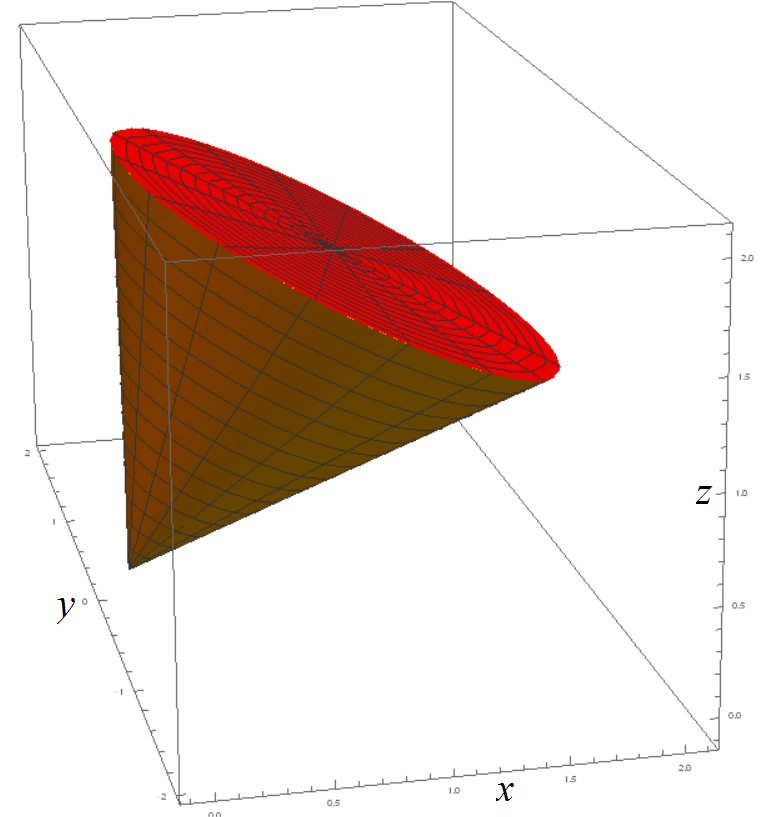 1a. The axis vectors of the ellipse are:
1a. The axis vectors of the ellipse are:a = (4⁄3,4⁄3,4⁄3) − (4⁄3,0,4⁄3) = (0,4⁄3,0), b = (2,0,0) − (4⁄3,0,4⁄3) = (2⁄3,0,−4⁄3). Then:P(r,t,s) = s ( (4⁄3,0,4⁄3) + r cos(t) a + r sin(t) b ) = (4⁄3 s + 2⁄3 s r sin(t), 4⁄3 s r cos(t), 4⁄3 − 2⁄3 s r sin(t)). - Extra 5: ⊞ Vector potential: reversing curl F
- Smooth manifold M with basepoint po
- Deformation retraction r : M×[0,1] → M, (p,t) ↦ r(p,t)
with:
r|M×0 = id, r|M×1 = po, r|po×[0,1] = po - Chain homotopy K : Ωi(M) → Ωi−1(M), K(ω) = η
ηp(v1,...,vi−1) = ∫10 ωr(p,t)(∂r⁄∂t(p,t), Dr(p,t)(v1),...,Dr(p,t)(vi−1)) dt with d K − K d = id on Ωi for i > 0 - Poincare Lemma: closed ⇔ exact, Hi(M) = 0 for i > 0.
Proof: Given dω = 0, get ω = d(Kω) − K(dω) = dη. - K is adjoint to the cone operator K^ on singular chains:
(i−1)-simplex σ goes to i-simplex K^(σ) by cone-ing σ to po via r(p,t).
- Deformation retraction r : M×[0,1] → M, (p,t) ↦ r(p,t)
with:
- M = Rn, r(p,t) = tp
- K(f dxj1···dxji)p
=
∑ik=1 (−1)k−1
(∫10 ti−1 f(tp) dt)
dxj1···
dxjk···dxji - n = 3, p = (x,y,z)
- Vect field B = (Bx, By, Bz) = Bz dx dy − By dx dz + Bx dy dz ∈ Ω2
- Vect field A = (Ax, Ay, Az) = Ax dx + Ay dy + Az dz ∈ Ω1
- Given B with dB = div B = 0,
find A with curl A = dA = B :
A = K(B) = [∫10 (By(tp) tz − Bz(tp) ty) dt] dx − [∫10 (Bx(tp) tz − Bz(tp) tx) dt] dy + [∫10 (Bx(tp) ty − By(tp) tx) dt] dz - Can also take r(p,t) shrinking one dimension at a time (coordinate axis paths to origin), cf. [MT] Ch 8.4 Ex #20, p 461.
- K(f dxj1···dxji)p
=
∑ik=1 (−1)k−1
(∫10 ti−1 f(tp) dt)
dxj1···
- Summary for R3
- f −grad→ F −curl→ G −div→ g
- grad f = F, K : Ω1 → Ω0, f(p) = (∫10 F(tp) dt) • p
- curl F = G, K : Ω2 → Ω1, F(p) = (∫10 t G(tp) dt) × p
- div G = g,
K : Ω3 → Ω2,
G(p) = (∫10 t2 g(tp) dt) p*
p* = (x,y,z)* = (z,−y, x)
- Key examples
- Curl of rotational field = axial field:
curl (−y,x,0) = (0,0,2)
curl 1⁄x2+y2 (−y,x,0) = 0 except for (0,0,1) times delta-function of z-axis - Curl of concentrated axial field = rotational field: curl (0,0,1⁄x2+y2) = −2⁄x2+y2 (−y,x,0)
- Curl of rotational field = axial field:
curl (−y,x,0) = (0,0,2)
- Extra 6: ⊞ Maxwell's Equations, Electromagnetism.
- Electric field E = E(x,y,z;t)
= (Ex, Ey, Ez)
Magnetic field B = B(x,y,z;t) = (Bx, By, Bz) - Lorentz force law: particle with charge q, velocity v has F = q(E + v×B)
E pushes charges, B deflects moving charges - Maxwell Equations: charge density ρ, current density J
Name Differential Integral Description (A) Gauss Law div E = ρ ∯S E•dn = ∫∫∫R ρ dV, S=∂R Electric flux out of closed surface equals charge enclosed (B) No Magnetic Monopoles div B = 0 ∯S B•dn = 0 No magnetic flux out of closed surface (C) Faraday Law curl E = −dB⁄dt ∮C E•dc = −d⁄dt ∫∫S B•dn, C=∂S Voltage induced around closed loop equals negative rate of change of enclosed magnetic flux (D) Ampere Law curl B = J + dE⁄dt ∮C B•dc = ∫∫S J•dn + d⁄dt ∫∫S E•dn, C=∂S Magnetic field around closed loop equals enclosed current plus displacement current (rate of change of enclosed electric flux) - Physical examples
- Gauss Law: Static charge attracts objects, makes hair repel & stand on end
- Faraday Law: Two rings with same axis, AC current in one ring induces voltage E around other ring
Changing E around one ring ⇒ changing axial B ⇒ E curling around other ring - Ampere Law: Current-bearing wires attract (if parallel currents), repel (if opposite currents).
Current in one wire ⇒ B through other wire ⇒ moving charge in other wire deflected - Ampere Law: Current J equivalent to displacement current dE⁄dt
Parallel capacitor plates discharging through a connecting wire
Effect on B is same for flux of J and of decreasing E between plates
- Static solutions: dE⁄dt = dB⁄dt = 0
- curl E = 0 ⇒ E = −grad φ for electric potential energy φ
div B = 0 ⇒ B = curl A for magnetic vector potential A -
Renormalization: Replace A by A + ∇ψ ⇒
Coulomb gauge div A = 0
Poisson eqn ∇2ψ = −div A, Poisson integral ψ(p) = −∫∫∫ div A⁄4π|p−u|2 dVu - Point charge: E(p)
=
p⁄|p|3
=
p̂⁄|p|2 ,
φ(p) =
1⁄|p| , B = 0
div E = 0, but delta function at (0,0,0) - Line charge, unit density along ℓ:
E(p) = p⊥ℓ⁄2π|p⊥ℓ|2 = p̂⊥ℓ⁄2π|p⊥ℓ| , φ(p) = −1⁄2π log |p⊥ℓ|, B = 0
div E = 0, but unit linear density delta function on z-axis. - Line current, unit along ẑ:
B(x,y,z) = (−y,x,0)⁄2π(x2+y2) , A(x,y,z) = (0, 0, −1⁄4π log(x2+y2)), E = 0
curl B = 0, but ẑ-valued delta function on z-axis - Thin solenoid (current rotating around z-axis cylinder): E = 0
B = 0, but (0,0,1)-valued delta function on z-axis, A(x,y,z) = (−y,x,0)⁄2π(x2+y2) - Electric dipole with axis ẑ: B = 0
- E = limε→0 (Eεẑ − E−εẑ)⁄2ε , scaled limit of converging point-charges
- E(x,y,z) =
(3xz, 3yz, 2z2−x2−y2)⁄(x2+y2+z2)5/2
- φ(p) = ẑ•p⁄|p|2 = ẑ•p̂⁄|p|
- Magnetic dipole with axis ẑ: E = 0
- B = limcircuit→0 (B of xy-plane circuit)⁄(area enclosed), scaled limit of unit current around small xy-loop
- B(x,y,z) =
(3xz, 3yz, 2z2−x2−y2)⁄(x2+y2+z2)5/2
- A(p) = ẑ×p⁄|p|2 = ẑ×p̂⁄|p|
- Maxwell eqns reduce to Poisson eqn: ∇2φ = −ρ , ∇2A = −J
- General static solutions: Poisson integral of fundamental point-charge solution
- Electrostatic:
E(p) =
1⁄4π
∫∫∫u ρ(u) (p−u)⁄|p−u|3 dVu
φ(p) = 1⁄4π ∫∫∫u ρ(u)⁄|p−u| dVu , B = 0 - Magnetostatic:
B(p) =
1⁄4π
∫∫∫u J(u) × (p−u)⁄|p−u|3 dVu
A(p) = 1⁄4π ∫∫∫u J(u)⁄|p−u| dVu , E = 0 - Biot-Savart: steady current I along loop C = u(t)
B(p) = −I⁄4π ∮C (p−u)⁄|p−u|3 × du
A(p) = I⁄4π ∮C 1⁄|p−u| du , E = 0
- Electrostatic:
E(p) =
1⁄4π
∫∫∫u ρ(u) (p−u)⁄|p−u|3 dVu
- Consider the conformal mapping f(z) = z2,
f(v+iu) = (v2−u2) + (2vu)i,
with inverse function:
g(w) = √w = √(r cos(θ) + i r sin(θ)) = √r cos(θ⁄2) + √r sin(θ⁄2), g(x+iy) = v + iu = 1⁄2sgn(y)√(x+√(x2+y2)) + 1⁄2√(−x+√(x2+y2)). In electrostatics, if we take the ray with u = 0 to be a side view of a half-plane of uniform negative charge, then u(x,y) is the electric potential energy, and E = −∇u(x,y) = −∇v(x,y)⊥ is the corresponding electric field.
- curl E = 0 ⇒ E = −grad φ for electric potential energy φ
- Reduce Maxwell equations to wave equations
- (B) ∇•B = 0 ⇔ B = ∇×A for some A
- (C) 0 = ∇×E + ∂B⁄∂t = ∇×(E + ∂A⁄∂t) ⇔ E + ∂A⁄∂t = −∇φ for some φ
- (A) ρ =
∇•E =
∇•(−∇φ −
∂A⁄∂t)
=
−∇2φ −
∂⁄∂t(∇•A)
⇔ ∇2φ − ∂2φ⁄∂t2 = −ρ − ∂⁄∂t(∇•A + ∂φ⁄∂t) - (D) J =
∇×B −
∂E⁄∂t
=
∇×(∇×A) −
∂⁄∂t(∂A⁄∂t + ∇φ)
= ∇(∇•A) − ∇2A + ∂2A⁄∂t2 + ∂⁄∂t∇φ
⇔ ∇2A − ∂2A⁄∂t2 = −J + ∇(∇•A + ∂φ⁄∂t) - Gauge shift: A = Ao + ∇ψ,
φ = φo − ∂ψ⁄∂t
Then: ∇×A = B, −∇φ = E + ∂A⁄∂t ⇔ ∇×Ao = B, −∇φo = E + ∂Ao⁄∂t
Lorenz gauge: solve inhomogeneous wave eq
∇2ψ − ∂2ψ⁄∂t2 = −∇Ao − ∂φo⁄∂t ⇔ ∇•A + ∂φ⁄∂t = 0 - Conclusion: Maxwell eqns reduce to inhomogeneous wave eqns
∇2φ − ∂2φ⁄∂t2 = −ρ , ∇2A − ∂2A⁄∂t2 = −J
- Free space solutions: Feynmann II-20, ρ = 0 , J = 0
-
∇2A = ∂A⁄∂t ⇒
∇2B = ∂B⁄∂t
∇2φ = ∂φ⁄∂t ⇒ ∇2E = ∂E⁄∂t - Linear wave:
E = E(x,t) = (0, f1(x−t) + g1(x+t), f2(x−t) + g2(x+t)) ,
B = B(x,t) = (0,−f2(x−t) + g2(x+t), f1(x−t) − g1(x+t)) - General solution is superposition of this type along x,y,z directions
- Spherical waves: E = E(r,t) = 1⁄r (F(r−t) + G(r+t))
for r = √x²+y²+z²
Physical solutions move outward only, so G = 0
-
∇2A = ∂A⁄∂t ⇒
∇2B = ∂B⁄∂t
- Poisson integrals for dynamic potentials
- φ(p) = 1⁄4π ∫∫∫u ρ(u,t')⁄|p−u| dVu
- A(p) = 1⁄4π ∫∫∫u J(u,t')⁄|p−u| dVu
- Retarded time variable: t' = t − |p−u|
Meaning: a charge in position u at time t only affects position p after time |p−u| -
We have taken speed of light c = 1; in general
t' = t − 1⁄c |p−u|
∇2φ − 1⁄c2 ∂2φ⁄∂t2 = −ρ , ∇2A − 1⁄c2 ∂2A⁄∂t2 = −1⁄c2 J
OLD ASSIGNMENTS
- ⊞ 2/15−17: Lect 15−16. Matrix multiplication and Chain Rule for general functions
Class notes.Solutions
HW:- For each of the linear mappings
ℓ : R2 → R2 below,
find the matrix [ ℓ ] =
[ ℓ(i) | ℓ(j) ] .
- r1(x,y) = (−x,y), reflection across the y-axis.
- r2(x,y) = (y,x), reflection across the line y = x.
- The composite mapping r1 ∘ r2, doing r1 after r2. Do this both from the definition r1(r2(x,y)), and by multiplying the matrices from (a) and (b).
- The opposite composition r1 ∘ r2. Is composition (and matrix multiplication) a commutative operation?
- Rθ , rotation by angle θ counterclockwise.
- Rα ∘ Rβ , the composite of rotating by angle β, then by α.
- Geometry tells us the result of part (f) must be the same as Rα+β. Equate the two matrices to prove the angle sum identities in trigonometry.
- Suppose we are given some mappings
f : R2 →
R2, c : R
→ R2, and
g : R2 → R.
- Form all possible compositions between these functions, in which the output of one must be a suitable input for the other. In each case, write out the Chain Rule for functions of the given dimensions, specifying the entries of the product Jacobian matrix.
- Now suppose the functions are defined by:
f(x,y) = ex2+y2 (x,y), c(t) = (t cos(t), t sin(t)), g(x,y) = x2 + y2. Examine the graphs of a couple of the possible compositions, and try to make sense of them. Check the Chain Rule in by evaluating the composition directly and finding its derivative; then computing the product of Jacobian matrices, and comparing.
- ⊞ Notes 2/15: Matrix multiplication, Chain Rule for general functions
- Given two linear functions ℓ : Rn → Rm and k : Rm → Rp, we can form their composition or chain, the function k ∘ ℓ : Rn → Rp given by (k ∘ ℓ)(v) = k(ℓ(v)); that is, the output of ℓ becomes the input of k.
- According to our general rule for linear mappings,
the p×n matrix of the composition is:
[ k ∘ ℓ ] = [ k(ℓ(e1)) | . . . | k(ℓ(en)) ]
= [ [k]•[ℓ(e1)] | . . . | [k]•[ℓ(en)] ] .That is, we multiply matrix [ k ] by each of the column-vectors of [ ℓ ].
- To express the composition of linear functions,
we generalize the definition of matrix multiplication:
p×m matrix K times m×n matrix L is p×n matrix K • L:
K • L = K • [ ℓ1 | . . . | ℓn ] = [ K• ℓ1 | . . . | K• ℓn ] . That is, we multiply K by each column vector of L. To compute this most conveniently, we take all dot products between the rows of K and the columns of L:
K • L = − r1 − ⋮ − rp − • | ℓ1 | . . . | ℓn | = r1• ℓ1 . . . r1• ℓn ⋮ ⋮ rp• ℓ1 . . . rp• ℓn .
With this definition, we evidently have:[ k ∘ ℓ ] = [ k ] • [ ℓ ] .
- Given two arbitrary functions g : Rn → Rm
and f : Rm → Rp,
we can again form their composition, the function
f ∘ g : Rn → Rp given by (f ∘ g)(v) = f(g(v)).
The most general form of the Chain Rule states that
the derivative function of the composition is the composition of derivative functions:
D(f∘g)c = Dfg(c) ∘ Dgc . In terms of Jacobian matrices, this means:
[ D(f∘g)c ] = [ Dfg(c) ] • [ Dgc ] .
The Chain Rule for single-variable functions is just the case where n = m = p = 1, namely: (f∘g)'(c) = f '(g(c)) g'(c); and all other forms of the Chain Rule are also special cases.
- ⊞ 3/14: Lect 21. 4 Curves, arclength, vector fields, div, curl, acceleration, Newton's 2nd Law.
Reading: M&T pp. 217−255.⊞ Solutions
HW:- Div and curl for three dimensions.
- Defining the symbolic vector ∇ = (∂⁄∂x , ∂⁄∂y , ∂⁄∂z), explain why we may write div F = ∇ • F and curl F = ∇ × F as a device for remembering the formulas for div and curl.
- If a three-dimensional vector field is a lifting of a two-dimensional one, with formula F(x,y,z) = (F1(x,y), F2(x,y), 0), explain how the three-dimensional curl F relates to the two-dimensional curl (F1, F2). What is the axis of rotation?
- Consider a general radial vector field F : R3 → R3 given by F(v) = g(r) v, where g(r) is a scalar function of the radius r = |v| = √(x2 + y2 + z2).
- Compute the divergence div F(x,y,z), in terms of the derivative g'(r). Hint: Write out F(x,y,z), take the partial derivatives, and add.
- Compute the divergence for the unit-length radial vector field F(v) = 1⁄r v. Explain why the net outflow of F from a polar-coordinate box is positive, even though the vectors have constant length.
- Prove that div F = 0 everywhere if and only if g(r) = c⁄r3 for c a constant, so that |F(v)| is proportional to the inverse-square radius 1⁄r2 .
- Prove that any radial vector field has curl F = (0,0,0) everywhere.
- Prove that div curl F = 0 everywhere, for any three-dimensional vector field F.
- Suppose a particle moves along a circular orbit
of radius R around the origin, given by the formula:
c(t) = ( R cos(S⁄R t), R sin(S⁄R t) ), where S is a constant.- Show that the particle is moving with constant speed S.
- Now suppose the particle is moving in an inverse-square force field F(v) = a⁄r3 v, and obeying Newton's 2nd Law: F(c(t)) = m c''(t). Show that the orbital speed must be inversely proportional to the square root of the radius: S = b⁄√R for a constant b independent of R and S.
- Prove Kepler's Third Law of Planetary Orbits: the square of the period (the time for one full orbit) is proportional to the cube of the radius.
- Find the arclength of one turn of the helix (screw curve) c(t) = (cos(t), sin(t), t).
1a. Considering a derivative operator like ∂⁄∂x as a "scalar", we can "multiply" it by a scalar function f(x,y,z) to give the partial derivative ∂⁄∂x f(x,y,z). Then taking the dot product of the "vector" ∇ = (∂⁄∂x , ∂⁄∂y , ∂⁄∂z) with a vector field F = (F1, F2, F3) gives the formula for the divergence:
∇ • F = ∂⁄∂x F1 + ∂⁄∂y F2 + ∂⁄∂z F3 = div F.
We can similarly compute the cross product ∇ × F = curl F.1b. We have curl F = curl (F1(x,y), F2(x,y), 0) = (0, 0, ∂⁄∂x F2 − ∂⁄∂y F1) = (curl (F1, F2)) k. That is, the axis of rotation is vertical, and the strength of the rotation at (x,y,z) is the same as the strength of the two-dimensional vector field at (x,y).
2a. We can compute divergence this by taking partial derivatives of each component in:
F(x,y,z) = ( g(√(x2+y2+z2)) x , g(√(x2+y2+z2)) y , g(√(x2+y2+z2)) z).
Alternatively, we can use a product rule for the divergence of f F, the scalar multiple of F : R3 → R3 by f : R3 → R;div(f F) = ∇ • (f F) = ∇f • F + f ∇ • F .
This is easy to verify (see p. 255 #7). Then for v = (x,y,z) and r = √(x2+y2+z2), we have:div F = ∇ • (g(r) v) = ∇(g(r)) • v + g(r) ∇ • v
= g'(r) ∇(r) • v + g(r) ∇ • v = g'(r) v⁄r • v + 3 g(r) = r g'(r) + 3 g(r).
2b. We have: div 1⁄r v = − r⁄r2 + 3⁄r = 2⁄r . A polar coordinate box has an inflow of F across its short inner edge (a circular arc), an outflow of F across its long outer edge, and no flow across its radial side edges. Thus, we clearly should have a positive net outflow, and hence positive divergence.2c. To find when div g(r) v = r g'(r) + 3 g(r) = 0, we must solve the separable differential equation: r dg⁄dr = −3g. That is, ∫ dg⁄g = −3 ∫ dr⁄r , which means log(g) = −3 log(r) + C, so that g(r) = exp(−3 log(r) + C) = c⁄r3 . Thus F(v) = c⁄r3 v, a radial vector field with magnitude proportional to the inverse-square of the radius.
2d. As in part (a), we can compute component by component, or use p. 255 #10 to get:
curl F = ∇ × (g(r) v) = ∇(g(r)) × v + g(r) ∇ × v = g'(r) v⁄r × v + g(r) ∇ × v = 0,
since v × v = 0 and ∇ × v = (∂⁄∂x , ∂⁄∂y , ∂⁄∂z) × (x,y,z) = 0.3. The formula div curl F = ∇ • (∇ × F) = 0 follows from the same algebra that proves u • (u × v) = 0 for any vectors u, v ∈ R3. You can check it by brute-force computation.
4. See p. 220−221.
5. The arclength is: ∫ |c'(t)| dt = ∫02π √(x'(t)2+ y'(t)2+z'(t)2) dt = ∫02π √(sin2(t)+ cos2(t)+1) dt = 2π√2.
- ⊞ 3/17: Recitation problems: vector fields, div and curl.
HW: For each vector field below, I have drawn its flow lines (curves following the arrows). For each field:- From the picture, estimate the div and curl of the field.
- Give a vector field formula which approximates the given flow lines.
- Compute the div and curl of your formula, and compare with your prediction.
- Two roughly vertical streams along the positive and negative z-axis; as they approach the xy-plane, they flatten out until they become roughly horizontal.
- A tornado with helical or spiral-helical flow lines around the z-axis.
- ⊞ 3/16−18: Lect 24−25. 5 Double and triple integrals.
HW:⊞ Solutions- Let F : R3 → R3
be a differentiable vector field, and f : R3 → R a scalar function. Compute and simplify the following
second derivatives.
- curl grad f = ∇ × (∇f)
- div curl F = ∇ • (∇ × F)
- div grad f = ∇ • (∇f). This is called the Laplacian of f, usually denoted ∇2f.
- (p. 270 #7) A vertical cylinder of radius r (representing a tree trunk)
has a wedge W lying above the xy-plane
and below the plane through the y-axis at angle θ from horizontal.
- Find the volume of the wedge as the double integral ∬ f(x,y) dA. Interpret the inner integral as an area. Hint: Compute the integral in the most advantageous order, dA = dy dx or dx dy.
- Write the above volume a triple integral ∫∫∫ dz dy dx, specifying W as the points (x,y,z) with a1 ≤ x ≤ a2, b1(x) ≤ y ≤ b2(x), c1(x,y) ≤ z ≤ c2(x,y).
- Write the above triple integral in five other ways corresponding to dV = dz dx dy = dy dz dx = dy dx dz = dx dz dy = dx dy dz.
- In class, we proved Fubini's Theorem using the
Integral Mean Value Theorem: The average of a continuous function over an interval is equal to some value of the function inside the interval:
1⁄(b−a) ∫ba f(x) dx = f(c) for some c ∈ (a,b).
Prove this from the usual Mean Value Theorem for the derivative of the function F(x) = ∫xa f(t) dt. - Consider the circular cylinder
C1 consisting of the points within distance 1 from the x-axis;
and similarly C2 for the y-axis.
Now define the solid S = C1 ∩ C2,
the region inside both cylinders.
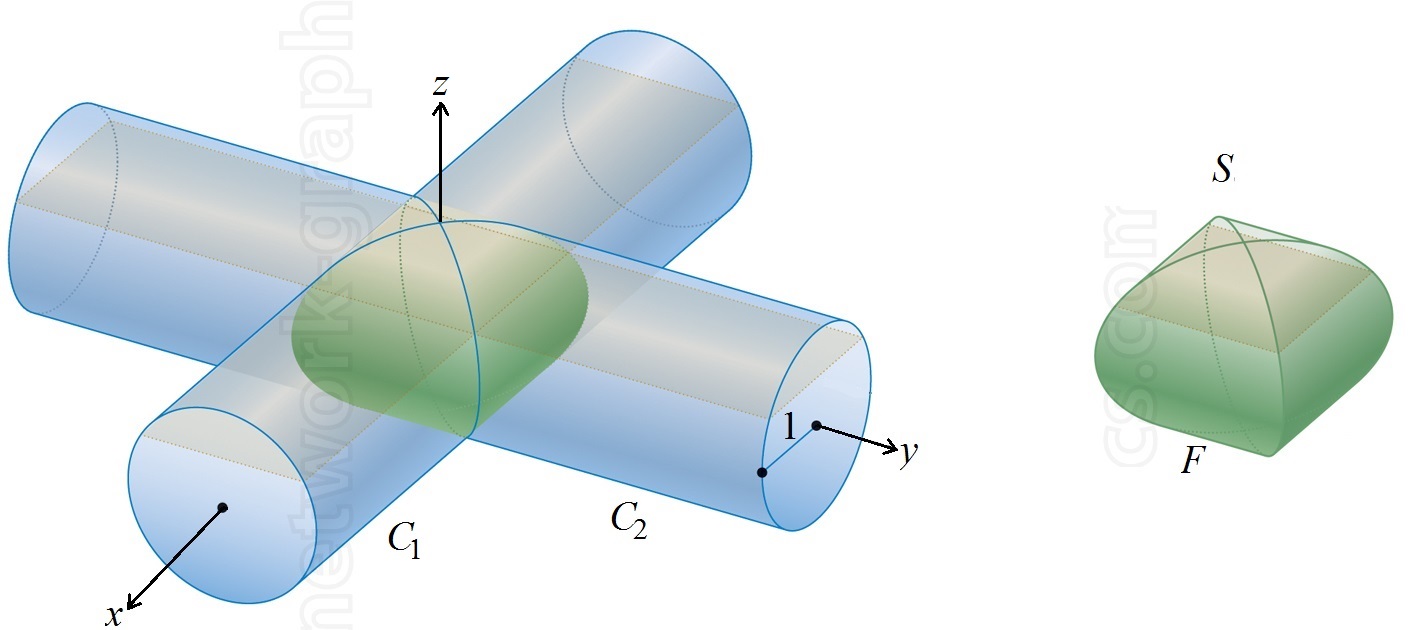
- Give equations for the two cylinders, and describe S by inequalities of the
form:
a1 ≤ z ≤ a2
b1(z) ≤ y ≤ b2(z)
c1(z,y) ≤ x ≤ c2(z,y)
Hint: The xy-shadow of S is the largest horizontal cross-section. Find the level z = c of this cross-section, and plug z = c into the equations. - Find the volume of S by evaluating a triple integral.
- Give equations for the two cylinders, and describe S by inequalities of the
form:
- Define the solid S as the region above the surface z = x2 − 2
and under z = 2 − y2.
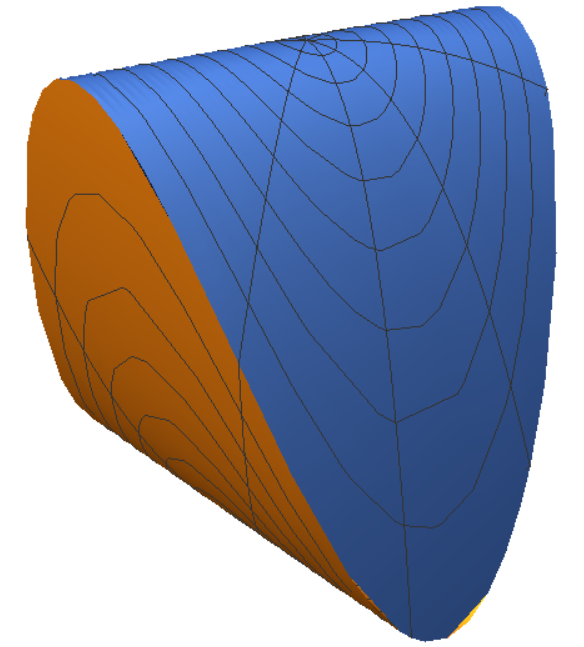
- Describe the boundary curve where the two surfaces meet, first by equations in x,y,z; then give it as a parametrized curve c(t).
- Find the most coordinate convenient plane where we can project the solid S, and describe its shadow. Set up and evaluate the triple integral giving the volume of S.
1. See the identities on p. 255.
1a. curl grad f = (0,0,0) for any function, which you can check from the definitions, coordinate-by-coordinate.
1b. div curl F = 0.
1c. div grad f = ∂2f⁄∂x2 + ∂2f⁄∂y2 + ∂2f⁄∂z2 .
2a. See picture on p. 270 #7. The wedge is defined by x2 + y2 ≤ r and 0 ≤ z ≤ mx, where m = tan θ. Writing the xy-shadow in y-simple form: -r ≤ x ≤ r, √−(r2−x2) ≤ y ≤ (r2−x2); and also 0 ≤ z ≤ mx. The volume integral becomes:
∫r0 ∫√(r2−x2) −√(r2−x2) mx dy dx = 2⁄3 mr3. The inner integral is the area of the rectangular vertical cross-section of the solid in the plane y = c, where c is a fixed value of x.
3. See notes on More Integral Applications, last page, from Math 132.
- ADD ⊞ 3/21: Lect 26. 6.3 Applications of Integrals.
See the Weekly HW due 3/25 below.⊞ Solutions
HW:- Represent a wire curving through the plane by a parametrized curve C = c(t) = (x(t), y(t)) for t0 ≤ t ≤ t1, with density function δ(t), given for example in grams per centimeter. Give a formula for the x- and y-coordinates of the center of gravity of C, in terms of a line integral over C. Hint: Find the average of x(t) and of y(t), wieghted by the density.
- Consider a triangular plate T in the plane with uniform density,
and with corners (0,0), (a, 0), (b1, b2), where a,b2 > 0.
- Find the center of gravity if the weight is concentrated in uniform amounts at the three corners.
- Find the center of gravity if the weight is uniformly distributed over the area of the plate.
- Find the center of gravity, assuming the weight is uniformly concentrated on the boundary lines of the triangle.
1. Repeating the definition of center of gravity as the average value of each coordinate x,y, weighted by mass = density × length along the curve c(t), we get:
x = 1⁄L ∮ x(t) δ(t) |dc| = 1⁄L ∫ x(t) δ(t) |c'(t)| dt,
y = 1⁄L ∮ y(t) δ(t) |dc| = 1⁄L ∫ y(t) δ(t) |c'(t)| dt,where L = ∫ δ(t) |c'(t)| dt is the arclength.
2a. The center of gravity of the three corners is the average of their vectors: ⅓((0,0) + (a, 0) + (b1, b2)) = (⅓a + ⅓b1, ⅓b2).
2b. The triangular region is bounded by lines y = 0, y = b2⁄b1 x, y = b2⁄(b1−a) (x−a). This can be split into two adjacent y-simple triangles corresponding to the two different floor-lines (for b1 > a) or ceiling-lines (for b1 < a). However, since one side of the triangle is the x-axis, the whole triangle is an x-simple region: 0 ≤ y ≤ b2, b1⁄b2 y ≤ x ≤ (b1−a)⁄b2 y + a. The double integrals 1⁄A (∬R x dA, ∬R y dA), where the area is A = ½ab2, give the same answer as in part (a).
2c. Splitting the line integral over the three line segments gives:
(x, y) = ½(a|a| + b|b| + (a+b)|a−b|) ⁄ (|a| + |b| + |a−b|), which is definitely different from parts (a), (b).
- ⊞ 3/23−3/25: Lect 27−28. 6.2 Change of variable formula. #2b center of grav of cone
See the Weekly HW due 3/25.⊞ Solutions
HW:- Gaussian integral
I =
∫
−∞
∞
e−x2 dx.
The integrand e−x2
is the
or bell-curve or normal distribution
which gives the relative probability of a
random variable x, assuming x has expectation value zero. (For example, x could be the height
of a randomly chosen woman.)
To make this a true probability distribution, we must scale it so that the total probability (the integral) is equal to one. That is, we must divide by the value of the integral I, but this is difficult to compute since e−x2 has no elementary anti-derivative. We outline an amazing solution using double integrals and change of coordinates.- Compute the double integral of e−(x2+y2) over the disk x2 + y2 ≤ R2, for a fixed radius R, and find the limit as R → ∞. Use polar coordinates.
- Show that the integral of e−(x2+y2) over the rectangle [−R,R]×[−R,R] is equal to ( ∫ −R R e−x2)2 dx.
- Compare the integral in (a) with that in (b), letting R → ∞, and compute the original integral I.
- Spherical coordinates
- Compute a Jacobian determinant to show that the volume form for spherical coordinates is: dx dy dz = ρ2 sin(φ) dρ dθ dφ. (I miswrote this formula in class.)
- Re-do our example from class, finding the center of gravity of the solid inside the unit sphere x2 + y2 ≤ 1 and the cone x2 + y2 ≤ z2, z ≥ 0.
- p. 348 #15: Use an appropriate change of variables to compute the integral
∬B exp((y−x)⁄(y+x)) dx dy over the triangle B
with vertices (0,0), (1,0), (0,1).
- Consider the change of variables transformation (s,t) = T(x,y) = (y−x, y+x).
Find its matrix [T], and verify that:
s t = [T] • x y - Find the image region B* = T(B): this is a triangle with vertices T(0,0), T(1,0), T(0,1).
- Given (s,t) = (y−x, y+x), solve the two linear equations to get x,y in terms of s,t. Use this to write the inverse transformation U = T−1 with (x,y) = U(s,t). Write the matrix [U] and verify that [U]•[T] = I, the identity matrix. Also B = U(B*).
- Write the Change of Variables formula for our integral, transforming it by U to (s,t) variables over B*.
- Evaluate the integral.
- Consider the change of variables transformation (s,t) = T(x,y) = (y−x, y+x).
Find its matrix [T], and verify that:
- Routine practice from M&T.
- p. 304 #15(a,b). Do with rectangular coordinates, then again with polar.
- p. 305 #25. Do with rectangular coordinates, then again with coordinates (s,t) defined by (x,y) = s (1,0) + t (2,1).
- p. 305 #27, 37.
- Review of vector fields, grad, div, curl.
Consider the vector field F = (−y, x, 0)
and a scalar function of the form f(x,y,z) = f(z) depending only on z.
- Describe F in words and sketch, and make a guess at its divergence and curl, based on their geometric meanings.
- Do the same for the product f F, that is, the vector field G(x,y,z) = f(z) F(x,y,z).
- Compute div F and curl F and compare with your guesses. Also compute grad f = ∇ f.
- Write the general product formulas for curl f F and div f F, and apply them to our case.
1. See M&T p. 332.
2a. See p. 325.
2b. S has an edge-curve with z2 = r2, and r2 + z2 = 1, hence r = z = 1⁄√2. Thus S is defined by: −1⁄√2 ≤ x ≤ 1⁄√2, −√(1⁄2−x2) ≤ y ≤ √(1⁄2−x2), √(x2+y2) ≤ z ≤ √(1−x2−y2). Under spherical coordinates, this pulls back to the box S* defined by 0 ≤ ρ ≤ 1, 0 ≤ θ ≤ 2π, 0 ≤ φ ≤ π⁄4. Hence the volume is:
V = ∭S dz dy dx = ∭S* ρ2 sin(φ) dρ dθ dφ
= (∫01 ρ2 dρ) (∫02π dθ) (∫0π⁄4 sin(φ) dφ) = (1⁄3)(2π)(1−1⁄√2) = π⁄3(1−1⁄√2).
Because of symmetry, the center of gravity must have x = y = 0, and:z = 1⁄V ∭S z dz dy dx = 1⁄V ∭S* ρ cos(φ) ρ2 sin(φ) dρ dθ dφ
= 1⁄V (∫01 ρ3 dρ) (∫02π dθ) (∫0π⁄4 cos(φ)sin(φ) dφ)
= 1⁄V (1⁄4)(2π)(1⁄4) = 3⁄16 (2+√2) ≈ 0.64 .
This somewhat above the middle of the cone, which is reasonable.3a. [T] = −1 1 1 1 3b. B* is the triangle with vertices (s,t) = (0,0), (−1,1), (1,1), given by 0 ≤ t ≤ 1, −t ≤ s ≤ t.
3c. (x,y) = (−½s + ½t , ½s + ½t). [U] = [T]−1 = −½ ½ ½ ½
This is indeed the inverse of [T], since: [U] • [T] = −½ ½ ½ ½ • −1 1 1 1 = 1 0 0 1 . 3d,e. We have U(B*) = B, one-to-one and onto. Since U is linear, it is its own derivative at every point: DU(s,t) = U, and |∂(x,y)⁄∂(s,t)| = det[U] = ½ . Also y−x = s, y+x = t. Thus:
∬B exp((y−x)⁄(y+x)) dx dy = ∬B* exp(s⁄t) |∂(x,y)⁄∂(s,t)| ds dt = 1⁄2 ∫01 ∫t−t es/t ds dt
= 1⁄2 ∫01 ∫t−t es/t ds dt = 1⁄4 (e−e−1).
4. See pp. 519−5205a. F = (−y, x, 1) is the velocity field of a right-handed rotation of space around the z-axis (i.e. right thumb along the z-axis, fingers curling toward the rotation). The velocity grows in proportion to the xy-radius.
The divergence is the net outflow from a small region around a given point, per unit volume enclosed. Taking the region to be a small cylindrical-coordinate box, the inflow on one side equals the outflow on the other, and div F = 0.
The curl is the right-handed axis of the rotation induced on a small paddlewheel floating in the flow of F near a given point, with magnitude equal to the force of rotation. This is clearly along the z-direction, with positive magnitude.5b. The product f F = f(z)(−y, x, 0) scales the speed of rotation for each horizontal plane. Thus, if f(z) = z, we could picture f F as a tornado, rotating slowly close to the ground, and faster and faster high up. (Below the xy-plane, the rotation would be reversed.) This would still have zero divergence, but the curl would be complicated by the shearing forces between horizontal layers, which depend on ∂f⁄∂z.
5c.
div F = ∇ • F = ∂⁄∂x(−y) + ∂⁄∂y(x) + ∂⁄∂z(0) = 0. curl F = ∇ × F = det
= 2k = (0,0,2).i j k ∂⁄∂x ∂⁄∂y ∂⁄∂z −y x 0 These are what we guessed.
5d. Any product formula is of the form: Δ(f∗g) = (Δf)∗g + f∗(Δg), where each Δ is some type of derivative and each ∗ some type of product. In our cases, there is only one type of derivative and one type of product which will make sense at each place in the formula, keeping in mind that: gradient takes a scalar function to a vector field, div takes a vector field to a scalar function, and curl takes a vector field to a vector field:
div f F = ∇ • (f F) = ∇f • F + (f) ∇•F Again, these are consistent with our guesses.
= (0, 0, ∂f⁄∂z) • (−y, x, 0) + f(z) 0 = 0.curl f F = ∇ × (f F) = ∇f × F + (f) ∇×F
= (0, 0, ∂f⁄∂z) × (−y, x, 0) + f(z) (0, 0, 2) = (−x ∂f⁄∂z , −y ∂f⁄∂z , 2 f(z)).- ⊞ 4/1: Triple integrals exercise sheets. (Apollonian mentioned in New Lect 7)
HW:⊞ Solutions- Triple integrals, especially #13, 19.
- Spherical and cylindrical integrals, especially #10, 29.
- Change of variables, especially #12.
- Numerical answers
Ch 16-9. #12. Consider the region R bounded by the four circles:x2 + y2 = 2x, x2 + y2 = 6x, x2 + y2 = 2y, x2 + y2 = 8y.
This region is adapted to a coordinate system called the Apollonian or inversion coordinates, whose coordinate grid curves are circles centered on the x-axis or the y-axis, all of which pass through the origin.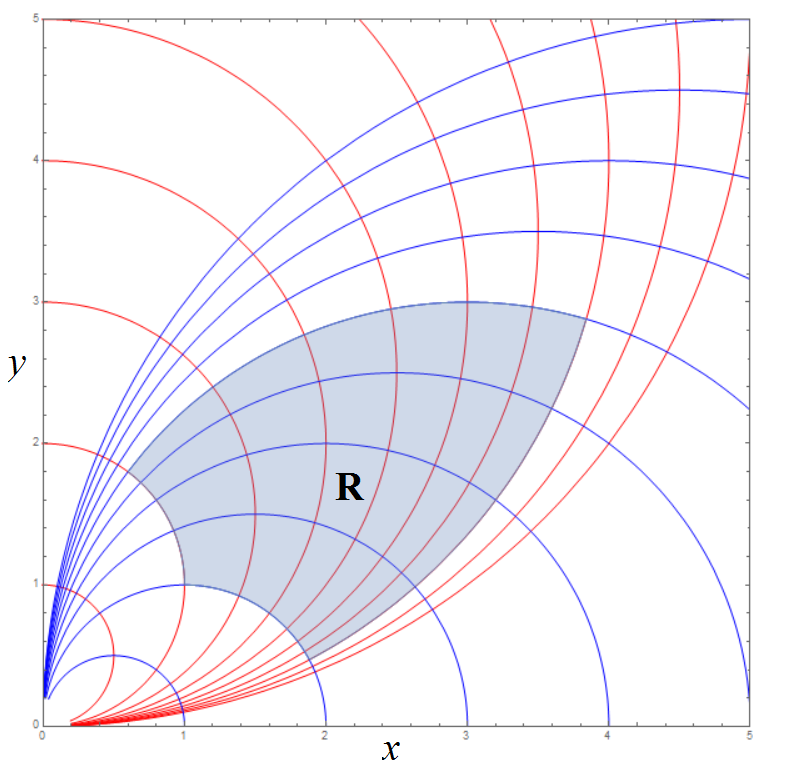
(x,y) = T(u,v) = (2u⁄(u2+v2) , 2v⁄(u2+v2)).
This is a kind of "reflection" across the circle of radius √2 ; T takes a point (u,v) with radius r to a point (x,y) with the same polar angle and radius 2⁄r. That is, T switches the inside and outside of the circle, with the origin going to infinity.- Write the boundary circles of R in the form (x−a)2 + (y−b)2 = r2 to show they are indeed Apollonian grid circles. (Hint: Complete the square.)
- Show that the line u = c in the (u,v)-plane corresponds to the circle (x−a)2 + y2 = a2 in the (x,y)-plane, where a = 1⁄c; and similarly, the line v = c corresponds to the circle x2 + (y−a)2 = a2. In the picture above, identify the blue circles as u = c and the red circles as v = c, for appropriate constants.
- Parametrize the region R as the points T(u,v) for a1 ≤ u ≤ a2 , b1 ≤ v ≤ b2 , for appropriate constants.
- Compute the Jacobian matrix [DT(u,v)] and its determinant |det[DT(u,v)]| = |∂(x,y)⁄∂(u,v)|, as it is written in the Change of Variables Formula.
- Use Change of Variables to rewrite the following integral in uv coordinates: ∬R 1⁄(x2+y2)2 dx dy.
- Verify that the inversion mapping T is its own inverse: that is, if (x,y) = T(u,v), then the variables u,v satisfy the equation (u,v) = T(x,y).
16-6 #13. The solid bounded by planes y + z = 4, y = 0, z = 0, and the parabolic cylinder y = 4−x2.
First examine the boundary surfaces involving only x,y: the back wall y = 0, and the curving front wall y = 4−x2. Next consider the roughly horizontal surfaces involving z: the floor z = 0 and the slanted ceiling z = 4−x.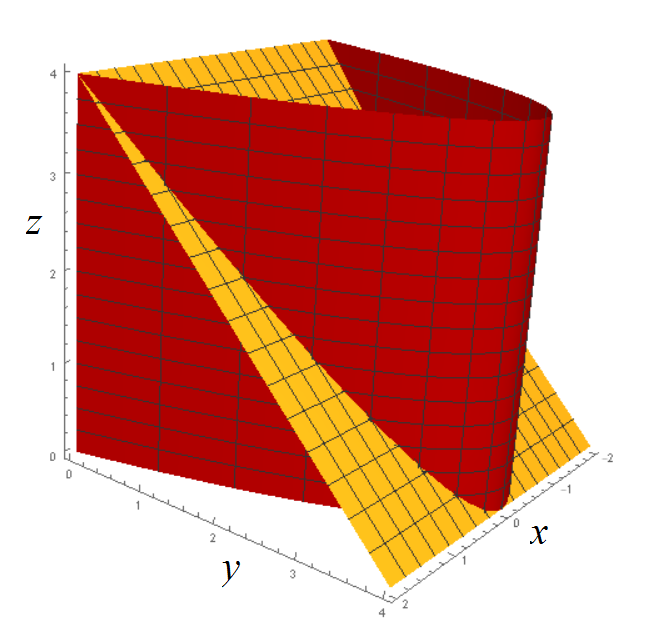
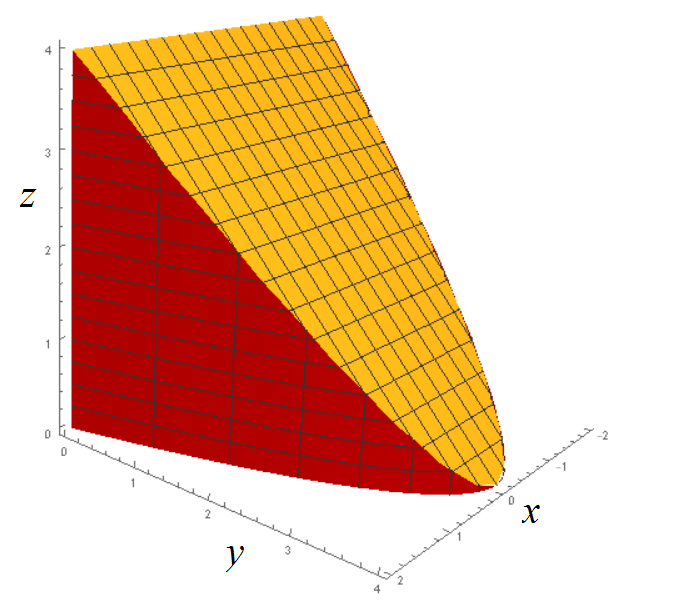
16-6 #19. The solid bounded by planes x + y + z = 2 and x = 0, and the parabolic cylinders y = z2 and z = y2.
First examine the boundary surfaces involving only y,z: the parabolic cylinders cutting each other in a squashed cylinder. Next consider the surfaces involving x: x = 0 and x = 2 − y − z, which cut off the ends of the squashed cylinder.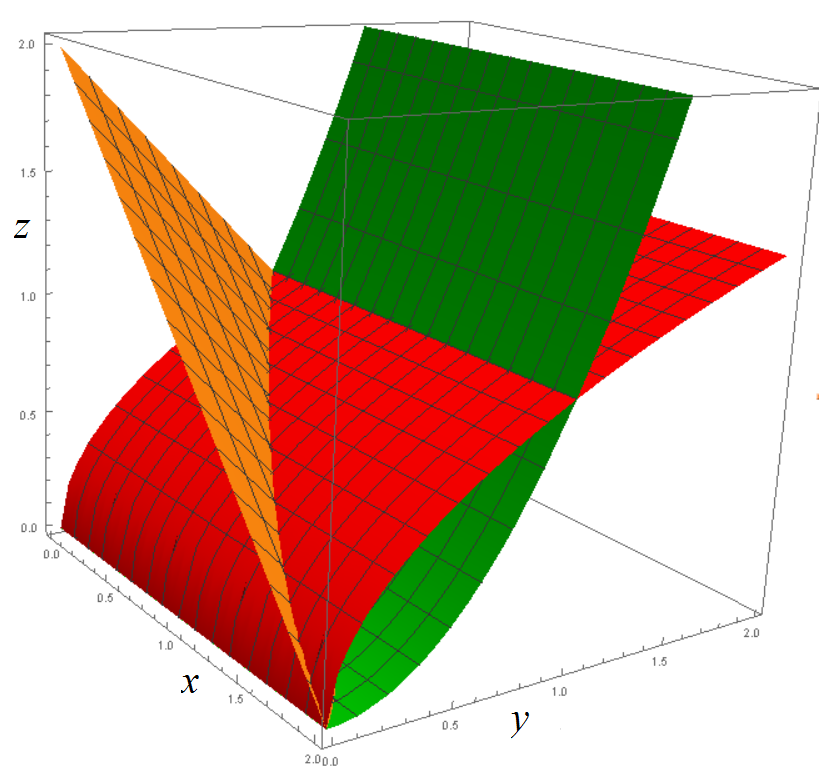
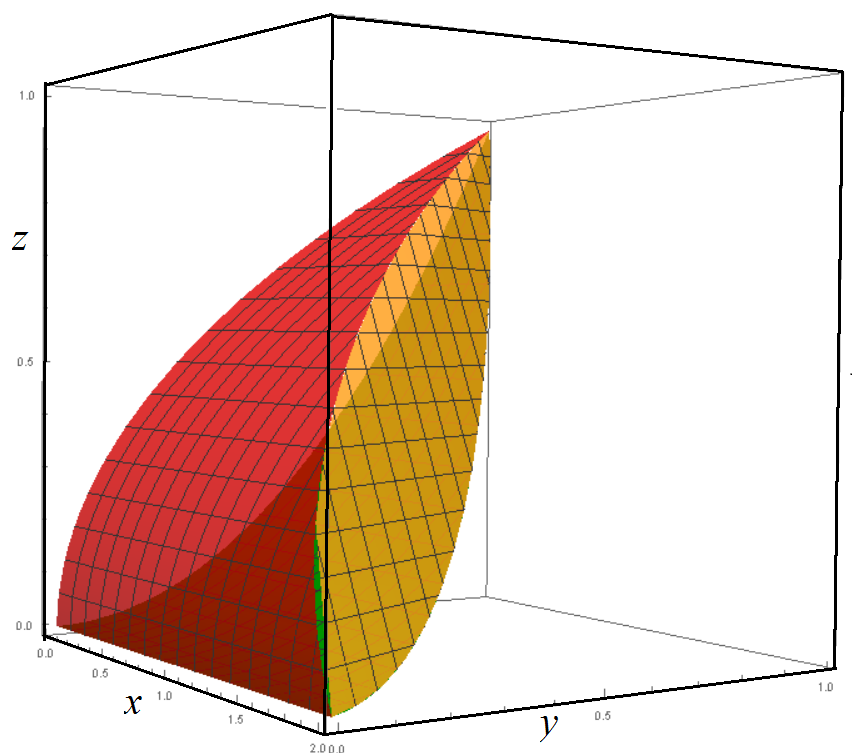
16-9 #12(a). The equation x2 + y2 = 2ax is equivalent to (x−a)2 + y2 = a2, a circle centered at (a,0) with radius a, so that the circle contains the origin. The first two circles have centers (1,0) and (3,0), and similarly the second two have centers (0,1) and (0,4).
12(b). The line u = c is parametrized by (c,t) for t ∈ R, which corresponds to (x,y) = T(c,t). It is easy to verify that x = 2c⁄(c2+t2) and y = 2t⁄(c2+t2) satisfy x2 + y2 = 2⁄c x, which is equivalent to the circle equation. Similarly for v = c.
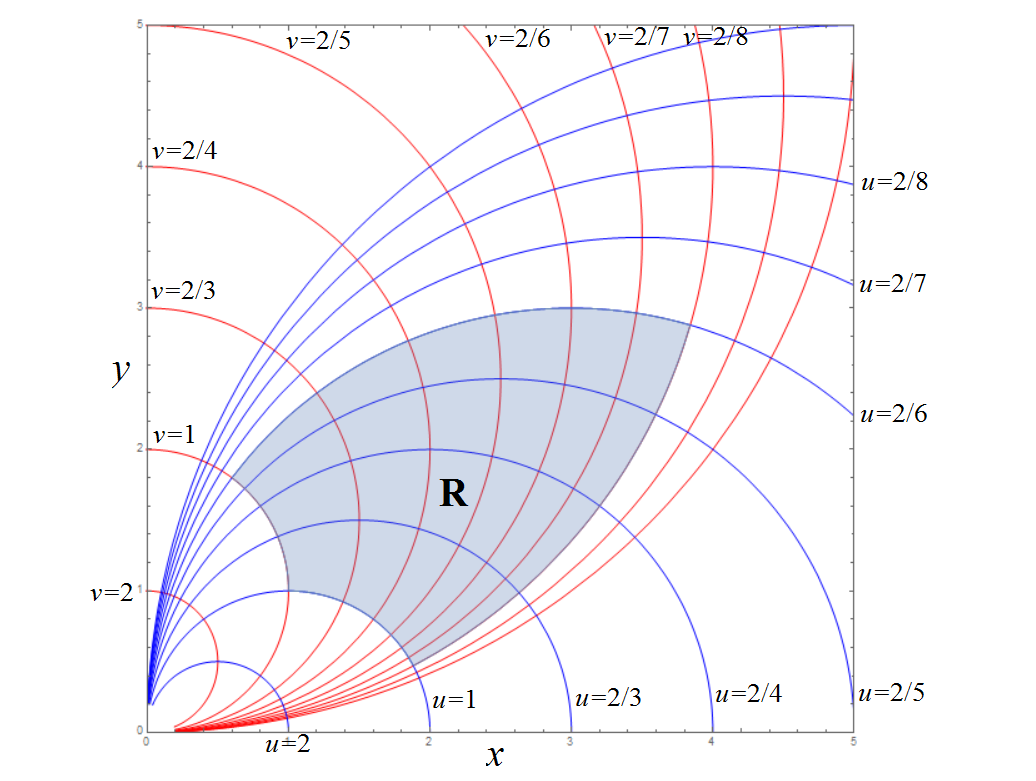
12(c). From the picture, we see R = { (x,y) = T(u,v) for 1⁄3 ≤ u ≤ 1 , 1⁄4 ≤ v ≤ 1 }
12(d). You can do this with Wolfram Alpha by pasting partial results into a scratch file, then pasting back into W|A. Result: the Jacobian determinant (streching factor) is |−4⁄(u2+v2)2| = 4⁄(u2+v2)2 .
12(e). The integral reduces to ∫1⅓ ∫1¼ (u2+v2)2 4⁄(u2+v2)2 dv du = 2.
12(f). Use W|A to solve the system of equations x = 2u⁄(u2+v2) and y = 2v⁄(u2+v2) for the variables u,v. Keep in mind that the equations are symmetric upon switching u,v and simultaneously switching x,y, so a solution for u can be switched into a solution for v.
Note: This is also evident from the polar description of T as an inversion across a circle of radius √2. Furthermore, we can write T as a conjugate inversion in the plane of complex numbers. That is, we let (x,y) correspond to the complex variable z = x + iy with conjugate z = x − iy; then T(x,y) corresponds to the mapping z ↦ 2⁄z = 2z⁄zz.- ⊞ 4/4−4/8: Lect 33−35. 7 Line & path integrals, parametric surface & flux integrals.
Work out as much algbra as you can by hand, but for really complicated expressions, use a computer tool like Wolfram Alpha. (For complicated operations, save partial results as plaintext in a file, then copy into a new W|A page.) Here is a tool for parametric surface plots.⊞ Solutions
HW:- We consider a torus or donut surface
with a core circle of radius R in the xy-plane,
surrounded by vertical sectional circles
of radius r ≤ R with centers on the core circle.

T(r,θ,φ) = (x,y,z) If we fix the sectional radius r, we get a toric surface parametrized by: T(θ,φ) = T(r,θ,φ).= R (cos(θ), sin(θ), 0) + r cos(φ) (cos(θ), sin(θ), 0) + (0, 0, r sin(φ)).
- Explain the geometric effect of each term in the formula for T.
- Find the 3×3 Jacobian derivative matrix:
[DT] = | ∂T⁄∂r | | ∂T⁄∂θ | | ∂T⁄∂φ | .
Also, find the Jacobian determinant det[DT], which is the stretching factor |∂(x,y,z)⁄|∂(r,θ,φ)| in the Change of Variables Formula. This is best done by computer.
Answer: |∂(x,y,z)⁄|∂(r,θ,φ)| = r(R + r cos(φ)). - Fix constant radius values r ≤ R,
and compute the 2×3 Jacobian matrix
[DT] = [ ∂T⁄∂θ |
∂T⁄∂φ ].
Its column vectors
∂T⁄∂θ ,
∂T⁄∂φ
span the tangent space of the torus at the point T(θ,φ).
Also find the normal vector, the cross product
n = ∂T⁄∂θ ×
∂T⁄∂φ
and its length |n|.
Check your answer for (θ,φ) = (0,π⁄4), for which n should have slope 1 in the xz-plane.
Hint: These are the same vectors you found in part (a) for T. Also, n = ∂T⁄∂r , so |n| is the same as the previous stretching factor. - For the solid torus with given r ≤ R,
use the Area Formula to find its surface area,
and the Change of Variables Formula to find its volume.
Answer: Area = 4π2rR, Volume = 2π2r2R .
- Explain the geometric effect of each term in the following
parametric formula for the ram's horn surface:
T(θ,φ) = 20 (cos(θ), sin(θ), 0) + (0, 0, 10 θ) + θ cos(φ) (cos(θ), sin(θ), 0) + (0, 0, θ sin(φ)).
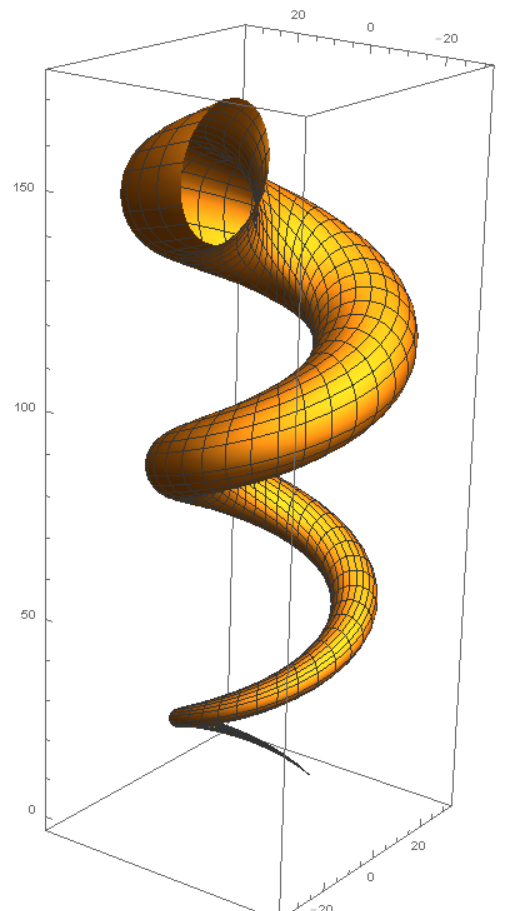
- Specialize the Area Formula to the following cases:
- Graph surface z = f(x,y). Hint: Parametrize by (x,y) coordinates.
- Surface of revolution z = g(√(x2+y2)). Hint: Parametrize by (r,θ) coordinates.
- Check your answer in (b) by applying it to the section of a right circular cone with height a and base radius b: this surface has equation z = a⁄b √(x2+y2). We can unroll the surface to get a circular sector with radius √(a2+b2) and outer circumference 2πb, and we can find its area without calculus.
- Consider the helicoid surface S (M&T p 386) parametrized by:
P(u,v) = (u cos(v), u sin(v), v) over the
parameter rectangle
S* = {(u,v) with 0 ≤ u ≤ 1, 0 ≤ v ≤ 2π}.
- Find the area A = ∬S* |∂P⁄∂u × ∂P⁄∂v| du dv
- For a typical point such as P(1,0), sketch the tangent vectors ∂P⁄∂u , ∂P⁄∂v and use the right-hand rule to estimate the normal vector n = ∂P⁄∂u × ∂P⁄∂v: does n point up or down? What would be the normal vector corresponding to the switched parametrization Q(u,v) = P(v,u)?
- Sketch the vector field F(x,y,z) = (0,y,1) by plotting arrows in the yz-plane. Geometrically estimate the flux of F through the helicoid S: remember that this depends on the component of F parallel to n.
- Compute the flux integral ∬S* F(P(u,v)) • (∂P⁄∂u × ∂P⁄∂v) du dv
- Work out for yourself some of the Examples in the book,
before looking at the solutions. Especially:
- 7.2 Ex 1, 2, 8, p 360.
- 7.3 Ex 3, p 380.
- 7.5 Ex 1, 2, 3, p 394.
- 7.6 Ex 1, 4, p 401. Exercise 1, p 411.
1a. Consider the torus parametrization:
T(r,θ,φ) = R (cos(θ), sin(θ), 0) + r cos(φ) (cos(θ), sin(θ), 0) + (0, 0, r sin(φ)). The first term parametrizes the core circle of radius R in the xy-plane by the angle θ, similar to the usual polar coordinate mapping. On a vertical circle of radius r, a radial vector tilted by angle φ from horizontal has horizontal component r cos(φ) and vertical component r sin(φ). This horizontal component should be in direction (cos(θ), sin(θ), 0), giving the second term, and the vertical component should be in direction (0, 0, 1), giving the third term.1b. The Jacobian derivative matrix is:
[DT] = cos(φ) cos(θ) cos(φ) sin(θ) sin(φ) −sin(θ)(r cos(φ)+R) cos(θ)(r cos(φ)+R) 0 −r sin(φ) cos(θ) −r sin(φ) sin(θ) r cos(φ) .
The Jacobian determinant simplifies to: det[DT] = r(R + r cos(φ)).
W|A can compute this if you input the above 3×3 matrix in the format {{a,b,c},{d,e,f},{g,h,i}}. The determinant remains the same if you transpose rows and columns.1c. The tangent vectors ∂T⁄∂θ , ∂T⁄∂φ of T(θ,φ) are the same as the corresponding derivatives of T(r,θ,φ): the last two columns of the Jacobian matrix in part (b). The normal vector is:
n = ∂T⁄∂θ × ∂T⁄∂φ = r (R + r cos(φ)) (cos(φ) cos(θ), cos(φ) sin(θ), sin(φ)).
This is a scalar times the unit vector (cos(φ) cos(θ), cos(φ) sin(θ), sin(φ)), which happens to be the same as ∂T⁄∂r : that is, the radial derivative vector of T is the unit orthogonal to the other two derivative vectors, which is evident from the geometry. Therefore the length of the cross product is the same as the determinant in part (b): |n| = r (R + r cos(φ)).1d. The area of the torus is:
A = ∫02π∫02π r (R + r cos(φ)) dφ dθ
= [2π r (Rφ + r sin(φ))]2πφ=0 = 4π2rR.
We temporarily denote the fixed sectional radius by r0, so that the solid torus has 0 ≤ r ≤ r0. Then the volume is:V = ∫0r0∫02π∫02π r (R + r cos(φ)) dφ dθ dr
= ∫0r0 A(r) dr = ∫0r0 4π2rR dr = 2π2r02R .
The replacing r0 with r, we get V = 2π2r2R .
Note that A(r) = d⁄drV(r). This is clear from the ∫ A(r) dr in the calculation, which comes about because of the unit orthogonality of the radial coordinate descibed in part (c). Geometrically, this means that an increment of Δr produces a layer of uniform thickness Δr over the toric surface, so that the rate of change of volume is the area.2. Ram's horn surface:
T(θ,φ) = 20 (cos(θ), sin(θ), 0) + (0, 0, 10 θ) + θ cos(φ) (cos(θ), sin(θ), 0) + (0, 0, θ sin(φ)).
The first term produces a horizontal motion controlled by angle θ around a circle of radius 20; the second term produces a uniform upward motion along with the horizontal turning; and these two combine to trace a helix or corkscrew curve which is the core of the ram's horn. From this core, we move along a vertical sectional circle controlled by parameter φ, similarly to 1(a) above; but the radius of this sectional circle is equal to θ, becoming wider as we trace around the helix.3a. The graph z = f(x,y) is parametrized by T(x,y) = (x, y, f(x,y)), giving stretching factor:
|∂T⁄∂x × ∂T⁄∂y| = |(1, 0, ∂f⁄∂x) × (0, 1, ∂f⁄∂y)|
= |(−∂f⁄∂x ,−∂f⁄∂y , 1)| = √(1 + (∂f⁄∂x)2 + (∂f⁄∂y)2).
The area is:A = ∬ √(1 + (∂f⁄∂x)2 + (∂f⁄∂y)2) dx dy.
This will usually be over some finite region (x,y) ∈ R* in the xy-plane.3b. The surface of revolution z = g(√(x2+y2) is parametrized by the cylindrical coordinate mapping T(r,θ) = (r cos(θ), r sin(θ), g(r)), giving stretching factor:
|∂T⁄∂r × ∂T⁄∂θ| = |(cos(θ), sin(θ), g'(r)) × (−r sin(θ), r cos(θ), 0)|
= |r (cos(θ) g'(r) , sin(θ) g'(r) , 1)| = r √(1 + g'(r)2) .
The area is:A = ∬ r √(1 + g'(r)2) dr dθ
Again, this is over a parameter region (r, θ) ∈ R*.3c. The right circlular cone with height a and base radius b has a vertex-to-rim radius of ρ = √(a2+b2), and a rim circumference C = 2πb. We can unroll the lateral surface into a sector of a circle of radius ρ, with circular arc C. The area A of a sector is proportional to its circular arc, so C⁄2πρ = A⁄πρ2 . That is: A = πb√(a2+b2).
The cone is parametrized by T(r,θ) = (r cos(θ), r sin(θ), a⁄b r) for 0 ≤ r ≤ b and 0 ≤ θ ≤ 2π. The formula of part (b) becomes:
A = ∬ r √(1 + g'(r)2) dr dθ = ∫02π ∫0b r √(1 + (a⁄b)2) dr dθ
= [ 2π√(1 + (a⁄b)2) r2⁄2 ]r=0b = πb√(a2+b2).
4a. For the area of the helicoid P(u,v) = (u cos(v), u sin(v), v) for 0 ≤ u ≤ 1 and 0 ≤ v ≤ 2π, see M&T p. 387. Answer: π(√2 + log(1+√2)) ≈ 7.2 .4b. For P(u,v) = (u cos(v), u sin(v), v) at (u,v) = (1,0), we have:
∂P⁄∂u = (cos(v), sin(v), 0) = (1,0,0)
∂P⁄∂v = (−u sin(v), u cos(v), 1) = (0, 1, 1).
If I point my index finger along the first vector (radially along the x-axis) and my middle finger along the second vector (up the ramp in the y-direction), then my thumb points upward and back along the y-direction: n = (1,0,0) × (0,1,1) = (0,−1,1). Similarly, the normal vector at any point points upward.If we changed the parametrization to Q(u,v) = P(v,u), switching the roles of (u,v), we would get the opposite cross product ∂Q⁄∂u × ∂Q⁄∂v = (0,1,1) × (1,0,0) = (0,1,−1) pointing downward.
4c. The vector field F(x,y,z) = (0,y,1) is independent of x, and is illustrated by its picture in the yz-plane:
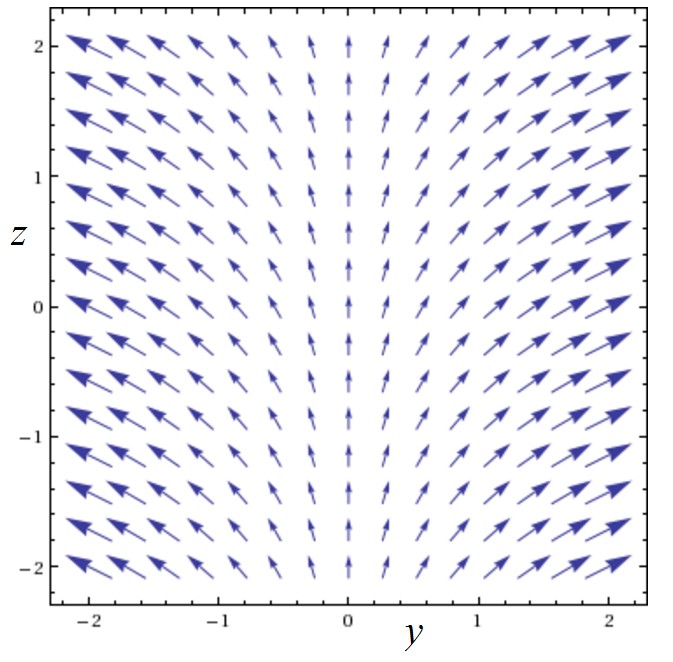
4d. The flux integral is:
∬ F(P(u,v)) • (∂P⁄∂u × ∂P⁄∂v) du dv
= ∫02π ∫01 F(u cos(v), u sin(v), v) • ((cos(v), sin(v), 0) × (−u sin(v), u cos(v), 1)) du dv
= ∫02π ∫01 (0, u sin(v), 1) • (sin(v), −cos(v), u) du dv
= ∫02π ∫01 −u sin(v) cos(v) + u du dv = π ≈ 3.1 .This is consistent with our geometric estimate.
5. Examples are worked out in the text. Answers for odd-numbered exercises are on p. 526.
- ⊞ 4/11−4/13: Lect 36−37. 8.1 Green's Theorem (with proof)
⊞ Solutions- Consider a vector field F in the plane R2, a simple plane region R, and the curve c which is the counterclockwise boundary of R. (For more general R, possibly with holes, the boundary curves should be oriented so that the region is on the left as you traverse each curve.)
- In coordinates, we write
F(x,y) = (P(x,y), Q(x,y)) and c(t) = (x(t), y(t)).
We can write a line integral as:
∮ F • dc = ∮c (P dx + Q dy) = ∫ P(x(t), y(t)) x'(t) dt + ∫ Q(x(t), y(t)) y'(t) dt.
- Curl Theorem (Green-Stokes Theorem):
The integral of the rate of rotation over R
is equal to the total rotation around the boundary of R:
∬R curl(F) dy dx = ∮ F(c) • dc.
In coordinates: ∬R (∂Q⁄∂x − ∂P⁄∂y) dy dx = ∮c (P dx + Q dy).
- Divergence Theorem (Green-Gauss Theorem):
The integral of the rate of outflow over R
is equal to the total net outflow across the boundary of R:
∬R div(F) dy dx = ∮ F(c) • dn,
where n is the outward-pointing normal to c, meaning dn = (−c')⊥ dt = (y'(t), −x'(t)) dt.
In coordinates: ∬R (∂P⁄∂x + ∂Q⁄∂y) dy dx = ∮c (P dy − Q dx). - The two coordinate equations are equivalent to each other. In the first equation, we replace F = (P, Q) by F⊥ = (−Q, P) to obtain the second equation.
- Go through our proof of the Curl Theorem for the specific
case of the vector field F(x,y) = (x+1, xy) and the y-simple
region R = {(x,y) with −1 ≤ x ≤ 1,
0 ≤ y ≤ 1+x2}.

- First, compute the two sides of the Curl Theorem as directly as possible, and check equality.
- Starting our proof requires regions
which are both x-simple and y-simple (see M&T p. 283).
Split R into two such regions
R = R1 ∪ R2, joined along a common boundary line.
Hint: As an inverse for y = x2 + 1, use the function b(y) = √(y−1) for y ≥ 1, b(y) = 0 for y ≤ 1. - Simplify ∬Ri (∂Q⁄∂x − ∂P⁄∂y) dy dx for each simple region R1, R2. Rather than computing out all the integrals and derivatives, consider the terms ∬Ri ∂Q⁄∂x dx dy and −∬Ri ∂P⁄∂y dy dx separately, and use the one-variable Fundamental Theorem of Calculus.
- Rewrite the above terms of the line integrals ∮ci F • dci = ∮ci P dx + ∮ci Q dy, where c1, c2 are the boundaries of the two regions.
- Explain why the sum of the line integrals for the two boundaries is equal to the line integral for the boundary of R. (What happens to the integral over the extra line between the regions?)
- Give a proof of the Divergence Theorem by mimicking our proof of the Curl Theorem. (As discussed above, the Curl Theorem implies the Divergence Theorem by simply substituting F⊥ for F. Nevertheless, prove the second theorem without assuming the first.)
- If F is a vector field with curl(F) = 1 for
all (x,y), then the Curl Theorem says that the area of the region
R is equal to the line integral of F over the boundary
curve of R.
- Let F = ½(−y, x), and let R be the region given in polar coordinates by r ≤ f(θ), for some function f. Use the Curl Theorem to give a simple formula for the area of R. Obtain the same formula directly using the polar change of variables.
- M&T p. 437 #13. Find the area under one arch of the cycloid curve (x,y) = (t−sin(t), 1−cos(t)) by computing the line integral of: F(x,y) = (0, x); or (−y,0); or ½(−y, x). Which vector field gives the simplest computation?
1a. From the picture of F(x,y) = (x+1, xy), we can see that curl(F) > 0 on the whole region. Also, F • c' is positive on the left, bottom, and right boundaries of R, while it is moderately negative on the top boundary (oriented right-to-left); thus the total rotation around the boundary should be positive.
Computing the left side of the Curl Theorem, with curl(F) = y − 0:
∬R curl(F) dy dx = ∫−11 ∫01+x2 y dy dx = ∫−11 ½(1+x2)2 dx = 28⁄15 .
Computing the right side of the Curl Theorem for the four counter-clockwise boundary curves of R:
Notice that we parametrized the left boundary curve as c4(t) = (−1, t) from the top corner t = 2 to the bottom corner t = 0, giving reversed limits of integration ∫20. (Similarly with the top curve.)∮ F • dc = ∫−11 F(t,0) • (t,0)' dt + ∫02 F(1,t) • (1,t)' dt + ∫1−1 F(t,1+t2) • (t,1+t2)' dt + ∫20 F(−1,t) • (−1,t)' dt = ∫−11 (t+1,0) • (1,0) dt + ∫02 (2,t) • (0,1) dt + ∫1−1 (t+1,t+t3) • (1,2t) dt + ∫20 (0,−t) • (0,1) dt = 2 + 2 − 62⁄15 + 2 = 28⁄15. 1b. Split the region along the y-axis so that each half is doubly simple, with no vertical or horizontal bays or dents:
R1 = {(x,y) with 0 ≤ x ≤ 1, 0 ≤ y ≤ 1+x2} = {(x,y) with 0 ≤ y ≤ 2, b(y) ≤ x ≤ 1}, where b(y) = √(y−1) for y ≥ 1 and b(y) = 0 for y ≤ 1.R2 = {(x,y) with −1 ≤ x ≤ 0, 0 ≤ y ≤ 1+x2} = {(x,y) with 0 ≤ y ≤ 2, −1 ≤ x ≤ −b(y)},
1c. For the region R1, and F = (P,Q) = (x+1, xy), the curl integral is:
We have a similar computation for R2. 1d. The line integral over the boundary curve c1 = (x(t), y(t)) is:∬R1 curl(F) dy dx = ∬R1 (∂Q⁄∂x − ∂P⁄∂y) dy dx = ∫ y=0 2 ∫ x=b(y) 1 ∂⁄∂x(xy) dx dy − ∫ x=0 1 ∫ y=0 x2+1 ∂⁄∂y(x+1) dy dx = ∫ y=0 2 [xy]x=b(y) x=1 dy − ∫ x=0 1 [x+1]y=0 x2+1 dx = ∫ y=0 2 1y − b(y)y dy − ∫ x=0 1 (x+1) − (x+1) dx. = ∫ y=0 2 Q(1,y) − Q(b(y),y) dy − ∫ x=0 1 P(x,x2+1) − P(x,0) dx. ∮ F • dc1 = ∮ (P(c1),0) • dc1+ ∮ (0,Q(c)) • dc1 For the P-term, we parametrize the boundary of R1 by four segments consistent with its y-simple description:
= ∫ P(x(t),y(t)) x'(t) dt + ∫ Q(x(t),y(t)) y'(t).(x(t),y(t)) = (t,0), (1,t), (t,t2+1), (0,t), the last two traveled in reverse. For the Q-term, we parametrize the same boundary consistently with the x-simple description:(x(t),y(t)) = (t,0), (1,t), (t,b(t)), with the last traveled in reverse. Then we may compute:
The vertical and horizontal terms containing (1)' and (0)' all vanish, and the remaining four terms match those at the end of 1(c).∮ (P(c1),0) • dc1+ ∮ (0,Q(c)) • dc1 = ∫01 P(t,0) (t)' + ∫02 P(1,t) (1)' + ∫10 P(t,t2+1) (t)' dt + ∫10 P(0,t) (0)' dt + ∫01 Q(t,0) (0)' + ∫02 Q(1,t) (t)' + ∫20 Q(t,b(t)) (t)' dt.
This proves the Curl Theorem for region R1, and the proof for R2 is similar. 1e. Assume we know the Curl Theorem for the two regions R1 and R2. Adding the double integrals on the left side of the Theorem for R1 and R2, we clearly get the double integral over R. Adding the line integrals along the two boundary curves, we get the line integral over the boundary of R, plus the line integral along the boundary line separating the subregions, taken twice in opposite directions, which cancel out. The left side equals the right side over the whole region R. 3a. For F = ½(−y,x), we easily calculate curl F = 1, so the left side of the Curl Theorem gives the area of the region. The right side is the line integral of F along the boundary curve given by (r,θ) = (f(t),t), namely c(t) = (f(t)cos(t), f(t)sin(t)):∮ F(c) • dc = ∫t=02π ½(−f(t)sin(t), f(t)cos(t)) • (f(t)cos(t), f(t)sin(t))' dt = ∫t=02π ½ f(t)2 dt. This can also be obtained from parametrizing R by the polar coordinate map T(r,θ) = (r cos(θ), r sin(θ)) for (r,θ) in the parameter region defined by 0 ≤ θ ≤ 2π, 0 ≤ r ≤ f(θ); then using the Change of Variables formula.- ⊞ 4/28: Recitation problems: solids, volume and surface area.
HW: For each solid below, determine:- Volume using rectangular coordinates (taking an appropriate order of integration)
- Volume using a cylindrical (or elliptic cylindrical) parametrization
- Surface area using any convenient parametrization.
- The solid built above the a unit circle in the xy-plane
from square slices on the line segments defined by x = a, a^2 + y^2 ≤ 1.
Hint: This solid is an intersection of a vertical circular cylinder and a horizontal parabolic cylinnder: its surface can be constructed out of paper. - The "pillow" solid whose slice at height z is the ellipse (x⁄z2−1)2 + y2 ≤ 1.
- Weekly Homework to hand in, usually on Fridays.
-
⊞
WHW 1 due 1/13: Thales' Theorem.
Thales' Theorem in geometry states that if you inscribe a triangle in a half-circle, with one side of the triangle equal to the diameter of the circle, then the angle opposite that side is a right angle. Prove this by vector algebra.
- Here is a model proof for HW 1 #3 above.
- State the proposition to be proved, clearly formulating the hypothesis (the setup or "if" part which is assumed), and the conclusion (the payoff or "then" part to be deduced).
- Start the proof by translating the geometric terms in the hypothesis into vector language. Taking the center of the circle to be the origin, consider the three vertices as endpoints of vectors. Determine the vectors along the relevant sides of the triangle from the vertex opposite the diameter. There is no need to use coordinates: the proof is much cleaner if you keep vectors as letters, not (x,y).
- Use the dot product to test whether the conclusion is true. Carefully expand using the known properties of the dot product, such as commutativity and the distributive law.
- Finally, translate the algebraic conclusion back into geometric language to clinch the conclusion.
- While constructing the proof, you may work forwards from the hypothesis and backwards from the conclusion, hoping to meet in the middle. But in the final draft, you must work only forwards, making each deduction clear.
- You may include a suggestive drawing, but your argument should be readable without it.
- You may turn in hand-written papers, but the best tool to present mathematics is TeX, which you can download free.
-
⊞
WHW 2 due 1/20: Graph landscape
Invent a function f : R2 → R whose graph z = f(x,y) makes an interesting landscape.
- To start exploring, graph the one-variable bump functions g(r) = 1⁄(1+r2) , 1⁄(1+|r|) , e−r2 (Wolfram|Alpha: plot e^(-r^2) for r=-2.5 to 2.5). Turn each of these into a mountain by taking its surface of revolution around the vertical axis, namely the graph of the two-variable function f(x,y) = g(√(x2+y2)) (W|A: plot3d 1/(1+sqrt(x^2+y^2)) for x = -2 to 2 and y = -2 to 2). Experiment with other g(r).
- More techniques:
- A long ridge with a given cross-section: z = g(x) or g(y). What is going on with: f(x,y) = exp(−(y−sin(x))2)?
- Experiment with the effect of taking f(x−a, y−b) and f(ax, bx) for some constants a,b.
- Superimpose several mountains and valleys by adding and subtracting such functions.
- Try multiplying functions: exp(−x2−y2) ∗ sin(x) scales the waves of f(x,y) = sin(x) by the bump function exp(−x2−y2).
- Taking the square root of a positive function produces cusps at the zero points: egg-crate function f(x,y) = −√(2−cos(x)−cos(y)).
- Adding functions like f(x,y) = g(x) + h(y) can be visualized by drawing the backbone z = g(x), then hanging perpendiuclar copies of z = h(y) along the backbone, with the copy above a given line x = c being raised by g(c).
- Find the (x,y) window which best shows the
interesting features of your function.
In addition to the graph, take the contour plot
and gradient vector field. It is probably best to draw the gradient vectors by hand onto the contour plot: remember that the closer the contours, the longer the gradient (since its length is the uphill slope). - Once you have your function, locate its critical points,
which are the flat points on its graph.
These are the values (x,y) where ∇f(x,y) = (df⁄dx,df⁄dy) = (0,0). (W|A will solve the equations for you most of the time.)
Classify each as a min (valley like z = x2+y2),
max (hill like −x2−y2)
or saddle (like x2−y2),
or possibly a ditch or ridge (like ±x2).
Note how each of these looks on the countour plot
and gradient field. - You might want to pay $6 for a month of Wolfram|Alpha Pro, which makes W|A work a good deal better (for example, it accepts long inputs).
Turn in:
- For your most interesting-looking function f(x,y), a printout of the graph, countour plot
and gradient vector field(copy and paste the W|A images). - A clear description of how you built up the formula for your function f(x,y) from its basic elements. You should be able to explain how each part of the formula controls some feature of the picture, not just "I tried this formula at random, and the computer drew that picture, I don't know why."
- Location and classification of the critical points. (At least give approximate location if solving the equations is too difficult.)
-
⊞
WHW 3 due 1/27: Optimizing a sawmill.
- Assignment
- Gradient Flow spreadsheet from Recitation 3.
-
⊞
WHW 4 due 2/10: Curl = rate of rotation.
- NEXT TIME: Use Mean Value Theorem for Integrals:
- Prove MVT for Int from usual MVT for Deriv & 1st Fund Thm
- Approximate ∫0Δx p(x+t,y+Δy) − p(x+t,y) dt by (Δx−0) p(x+c,y+Δy) − p(x+c,y)
- Use derivative MVT: difference quotient = ∂p⁄∂y(x+c,y+d), take Δx,Δy→0
- Also prove path-indep ⇒ conservative, because d/dy of ∮ F along horiz-then-vert path is q, d/dx along vert-then-horiz path is p.
- Also prove any line integral indep of parametrization
limΔx,Δy → 0 1⁄ΔxΔy ∮ F(cΔxΔy) • dcΔxΔy = ∂q⁄∂x(x,y) − ∂p⁄∂y(x,y) , where cΔxΔy(t) is the curve which traces around a rectangle from (x,y) to (x+Δx, y) to (x+Δx, y+Δy) to (x, y+Δy) and back to (x,y).
- To evaluate the left side, use the computational definition of line integral: ∮ F(c) dc = ∫sr F(c(t)) • c'(t) dt, where the curve's parameter goes through the interval s ≤ t ≤ r.
- Get your preliminary answer in terms of certain antiderivative functions: P(x,y) with ∂P⁄∂x = p(x,y), and Q(x,y) with ∂Q⁄∂y = q(x,y). What does the First Fundamental Theorem of Calculus say about these?
- After you evaluate the line integral, take the limit as Δx → 0, then Δy → 0, or perhaps in the other order.
- You might need the fact that partial derivatives commute: ∂⁄∂x ∂⁄∂y f(x,y) = ∂⁄∂y ∂⁄∂x f(x,y), so it does not matter which derivative you take first.
-
⊞
WHW 5 due 2/20: Conservative Vector Field Theorem.
All of the following conditions are equivalent:
- F is conservative: there is a potential function f with F = ∇f.
- F is path independent: the line integral between two fixed points is the same for any choice of path between them: for any paths c1, c2 with c1(0) = c2(0) = (a,b) and c1(1) = c2(1) = (c,d), we have ∮ F(c1)•dc1 = ∮ F(c2)•dc2 .
- F has zero circulation: its line integral around any loop is zero: if c(t) for 0 ≤ t ≤ 1 is a closed curve with c(0) = c(1), then ∮ F(c)•dc = 0.
- F is irrotational: curl F(x,y) = 0 at all (x,y).
Hints:- State the theorem at the beginning, briefly: you don't need to include definitions of your terms.
- In each section of the proof, start by stating the hypothesis (the setup assumed) and end by stating the conclusion deduced.
- (i) ⇒ (ii): You may assume the Gradient Theorem from HW 2/3.
- (ii) ⇒ (iii): For a curve c(t) with 0 ≤ t ≤ 1, and its reverse curve c−(t) = c(1−t), use 1-variable substitution to show that ∮ F(c−)•dc− = −∮ F(c)•dc. Then, for a given loop, cut it into two paths from the beginning point to the half-way point.
- (iii) ⇒ (iv): You may assume the limit definiton of curl F which you proved in WHW 4.
- (iv) ⇒ (iii): You may assume the Curl Theorem (Green's Theorem for Circulation), which we will prove in Friday's lecture. That is, the circulation of F around a loop is equal to the total rate of circulation
enclosed by the loop; for a closed curve c which forms the counterclockwise boundary of a region D, we have:
∮ F(c)•dc = ∬D curl F(x,y) dx dy. Note: This proves (iii) only for curves which bound a region D, but you may ignore more complicated curves (such as self-intersecting ones). - (iii) ⇒ (ii): Easy converse of (ii) ⇒ (iii).
- (ii) ⇒ (i): Here you need a real argument. Assuming that the line integral of F = (p,q) from (0,0) to (x,y) is a function f(x,y) depending only on (x,y), not on the path chosen, you need to show that ∂f⁄∂x(a,b) = p(a,b) and ∂f⁄∂y(a,b) = q(a,b). For the first, choose to compute f(a,b) along the path going straight from (0,0) to (a,0) to (a,b). Use the 1-variable First Fundamental Theorem of Calculus, similarly to WHW 4.
- Some of these were outlined in HW 2/6 and 2/8.
-
⊞
WHW 6 due 3/17: Algebra of cross products and determinants
In abstract algebra, we consider not only the familiar arithmetic operations, but more general operations on more general types of "numbers", such as sum or cross product of vectors. We can do algebra as soon as the operation obeys some basic properties:
- Associative: (a ∗ b) ∗ c = a ∗ (b ∗ c)
- Identity Element: A special element e operates with no effect on any a: e ∗ a = a ∗ e = a.
- Inverses: For any a, there is some b which cancels it: a ∗ b = b ∗ a = e.
- Commutative: a ∗ b = b ∗ a.
- Distributive: We can define an extra operation ⊕ with:
a ∗ (b ⊕ b') = a∗b ⊕ a∗b' ,
(a ⊕ a') ∗ b = a∗b ⊕ a'∗b .
- Let A = Rn be the set of vectors
such as a = (a1,...,an).
Show that the addition operation
a ∗ b = a + b
obeys each property (i)−(iv).
(Don't worry about (v).)
Hint: Each property follows from the corresponding property of addtion on the real numbers R, which we take for granted. - Determine whether the cross product operation
a ∗ b = a × b
on R3 obeys each property (i)−(v).
Hints:- To show that a property such as commutativity fails, it is enough to provide a single counterexample with a × b ≠ b × a.
- To show that there is no identity element e, you must show that no possible element of R3 operates trivially on every vector.
- To show that a property does hold, you may use the known properties of det(u,v,w), the 3×3 determinant .
- Continuing #2, show that cross product obeys
these alternative properties, known as Lie algebra properties:
- iv'. Anti-commutative: a × b = − b × a
- v'. Jacobi identity: a × (b × c) = (a × b) × c + b × (a × c).
- Extra Credit: The min-plus or tropical algebra is
defined on A = R ∪ {∞}, where ∞ is a formal symbol
thought of as positive infinity.
It has operations:
- a ∗ b = a + b, usual addition of real numbers, with a ∗ ∞ = ∞ ∗ a = ∞.
- a ⊕ b = min(a,b), the smaller of the two numbers, with a ⊕ ∞ = a.
Show that ⊕ obeys all but one of properties (i)−(iv), and ∗ obeys all of (i)−(v).
Can you define a tropical algebra structure on vectors in An?
-
⊞
WHW 7 due 3/24: Parametric curves & surfaces.
For each surface S:
- Write a parametric formula P(t,s) = (x(t,s),y(t,s),z(t,s)) over a parameter region S* in the (t,s)-plane.
- Print out a picture of the surface. (Plotting software: Mathematica, Zweig, Desmos, URI.)
- First, a curve: the helix (corkscrew, spring) coiling around the z-axis, above the xy unit circle
- Tube surface at distance r from the helix. Hint: Use Frenet frame from Lect 27.
- Helical staircase, consisting of horizontal rays from z-axis to helix
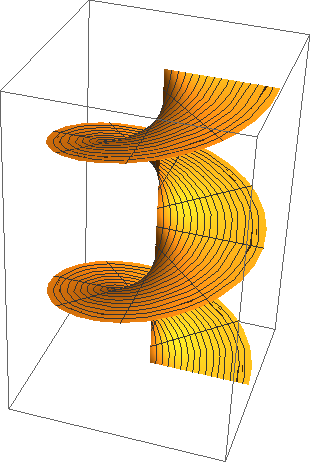
- Surface of revolution: a curve c(t) = (x(t), 0, z(t)) in the xz-plane, rotated around the z-axis
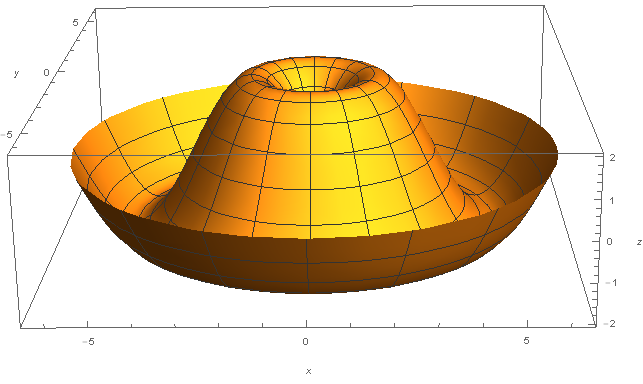
Hint: Make one parameter t moving around c(t), and the other parameter turning around the z-axis. - Spheroid with diameters 2a, 2b, 2c
(each coord plane section is an ellipse)
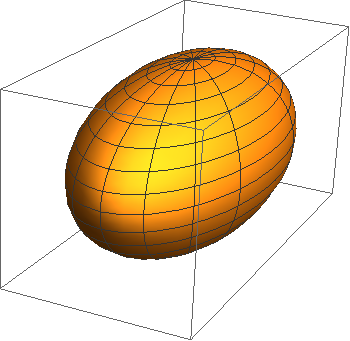
- Ellipse on a tilted plane, with major axis
from a = (1,2,3) to −a = (−1,−2,−3), and minor axis from
b = (2,−1,0) to −b = (−2,1,0). Note a ⊥ b.
Hint: Use polar coordinates with respect to the axes a, b instead of i, j. - Extra Credit: Ram's Horn
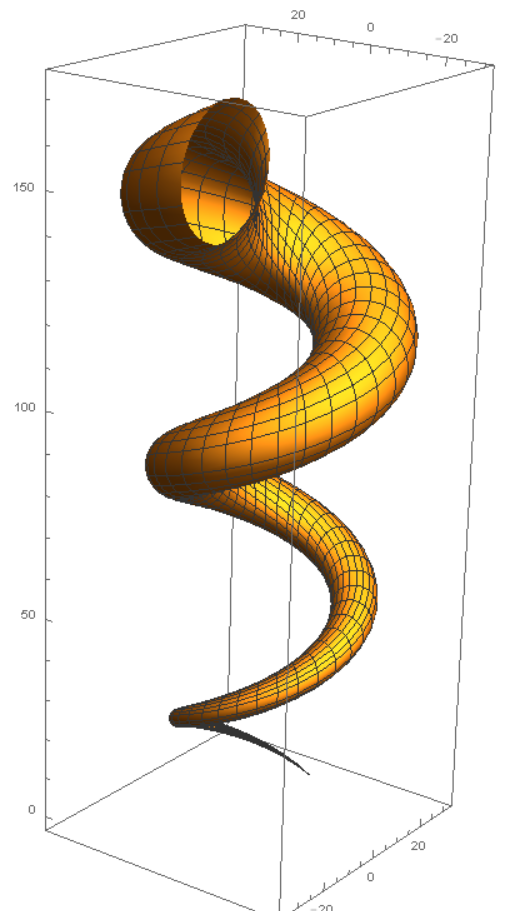
- ADD WHW 8: Limit proofs (tex), Limit proofs (tex)
-
⊞
ADD
WHW 9 due 4/17: Constrained max/min problems.
NEXT TIME: distance between same surface: x3−x−y2 and lower curve y = 0, z = (1−x2)/2, closer to positive-curvature part of surface, making stable critical point (min pt)
Assignment (tex) Note: You can get Mathematica for free, though you can probably make do with Wolfram Alpha. - ADD WHW 11: Epicycloid problem
- Notes to supplement the M&T text.
- Review notes on Calculus I and Calculus II.
- Marsden & Tromba Theoretical Supplement
-
⊞
Software
- Wolfram Alpha: plot curves, surfaces, vector fields; multiply matrices.
- Get Wolfram Mathematica for free.
- Surface plotters: Zweig, Desmos, URI
- Consider the function: F(u,v) = (uv, u⁄v) = (x,y) over the parameter domain u,v > 0.
- Picture F : R2 → R2, F(u,v) = (x,y)

